We’ve recently reviewed the history of what is probably the most emblematic collection from IWC, the Portugieser. A range that has been around since the 1930s, it somehow encapsulates everything IWC is known for: complications, style and precision. But there’s another, more recent collection that’s as important, if not even more impactful, one that traces its origins back to the 1940s and wartime, a watch that deliberately shocked the world when it came out: Die Grosse Fliegeruhr, also known as the IWC Big Pilot. For our latest instalment of The Evergreens, we’ll go through the entire history of what is one of the most emblematic pilots’ watches ever created.
The Origins of IWC Pilot’s Watches and the Legacy of the Big Pilot’s Watch Ref. 431
IWC’s pilot’s watches are a category that dates to the early days of aviation and continues to shape the brand’s identity today. The modern Pilot’s Watch collection foundations are rooted in the military-issue “Mark” watches supplied to the British Royal Air Force, and the oversized “B-Uhr” timepieces built for the German Luftwaffe. At the heart of the latter tradition is a monumental watch that would become an icon in its own right: the Big Pilot Reference 431.
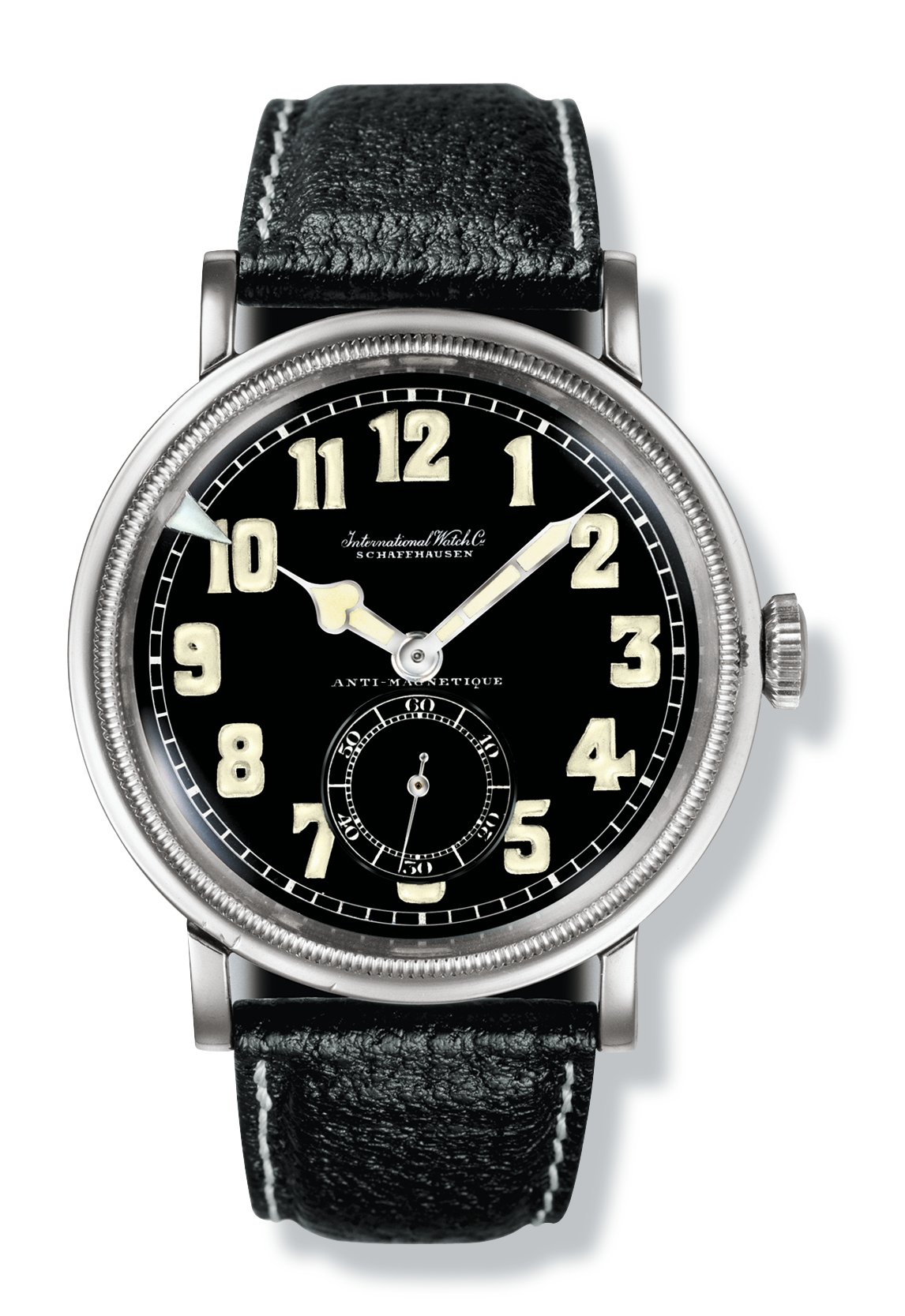
IWC’s flight began in 1936 with the release of the Special Pilot’s Watch Ref. 436, informally dubbed the Mark IX (IWC never labelled it as a Mark IX, the name derived colloquially from the next model, which was classified as a Mark X by the British Ministry of Defence. Conceived by the sons of then-owner Ernst Jakob Homberger, both licensed pilots, the watch was purpose-built for aviation with its large 38mm case, high legibility, and antimagnetic movement that performed reliably across a wide temperature range. It was followed by the more widely known Mark X and eventually the Mark XI in 1948, a chronometer-grade tool watch that was supplied to the RAF and remained in active military service for decades.
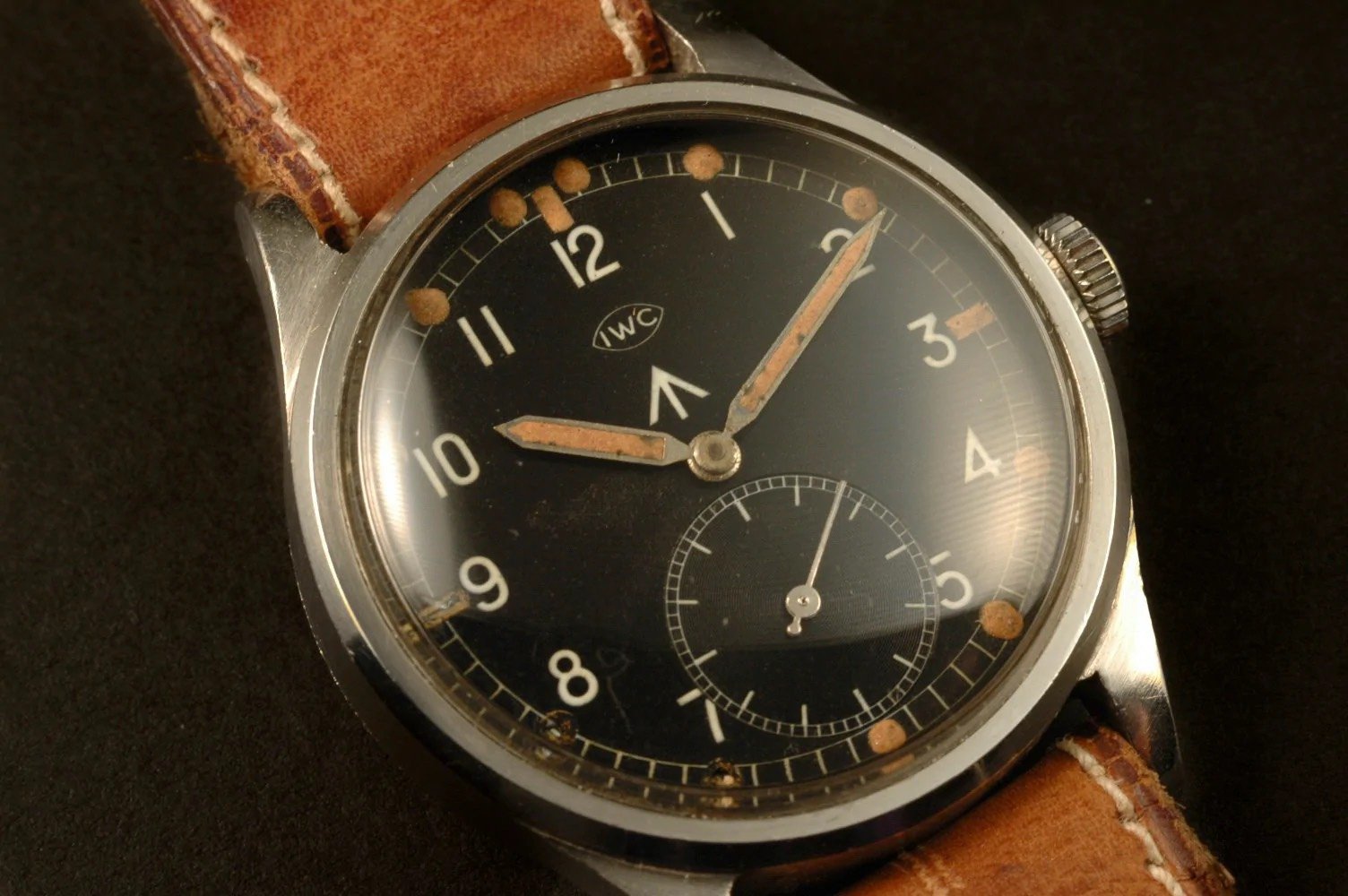

These early pilots’ watches laid the groundwork for IWC’s rugged, functional, and highly legible timepieces. These qualities would reach their peak with the unveiling of an even more ambitious project during World War II.
1940 – The Big One, the Reference 431 and the B-Uhr Legacy
In 1940, in response to the German Air Force’s specifications for an observation or “Beobachtungsuhr” (B-Uhr) watch, IWC began production of what would become the largest wristwatch in the company’s history: the Reference 431. Developed under strict military standards, the Reference 431 (1,000 pieces made) came with a 55mm x 16.5mm case, measured at 183 grams, and powered by the Calibre 52T 19″ H6 SC, a robust and historically significant movement deeply rooted in IWC’s manufacturing heritage.
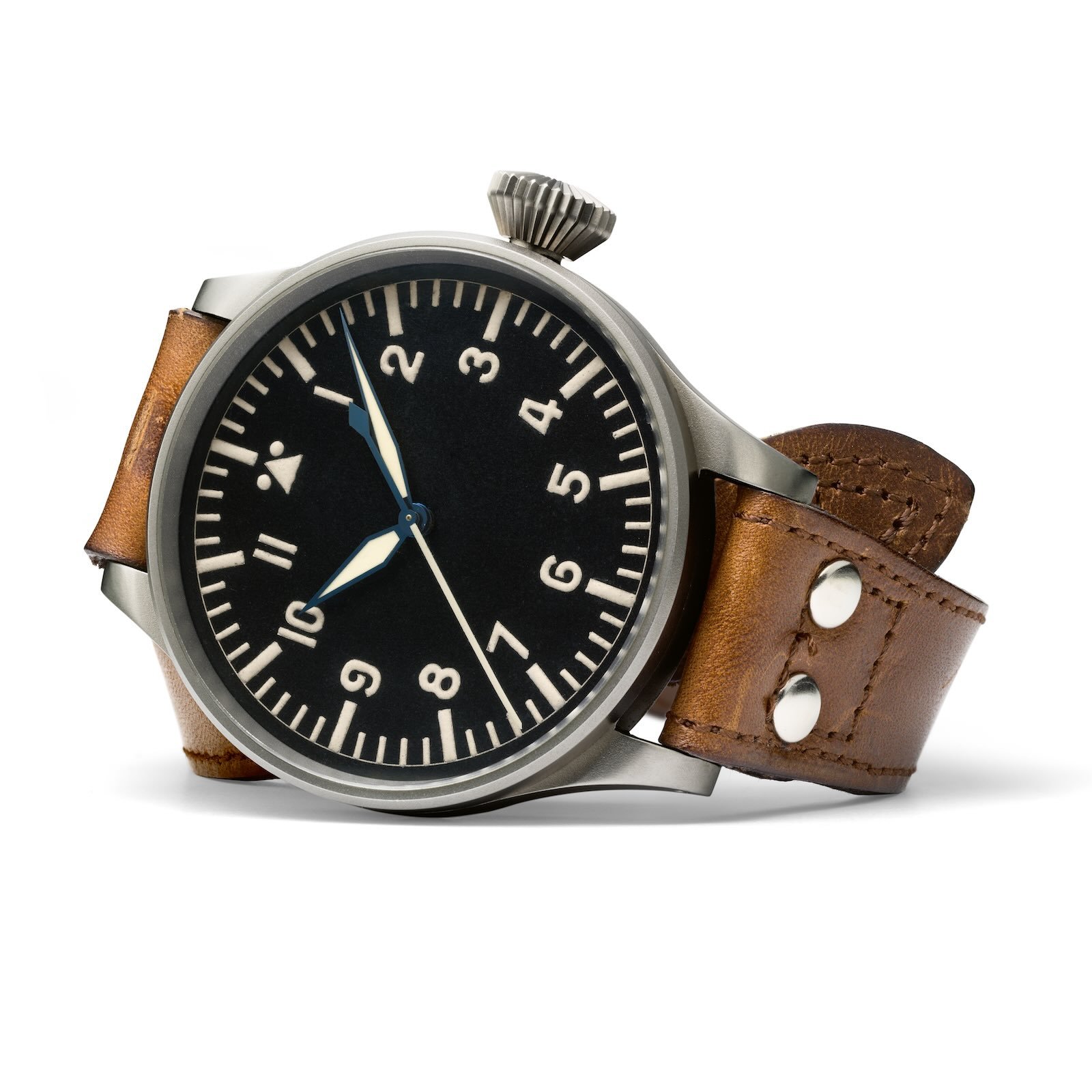

The Calibre 52 T.S.C. was the result of over five decades of mechanical evolution. Its origins trace back to the 1886 Elgin III movement, an American design that served as the blueprint for IWC’s own “Calibre IWC” series introduced in 1888. These early calibres laid the technical foundation for what would become the Calibre 52 (open-face) and Calibre 53 (hunter case or Savonette with crown at 3 o’clock).
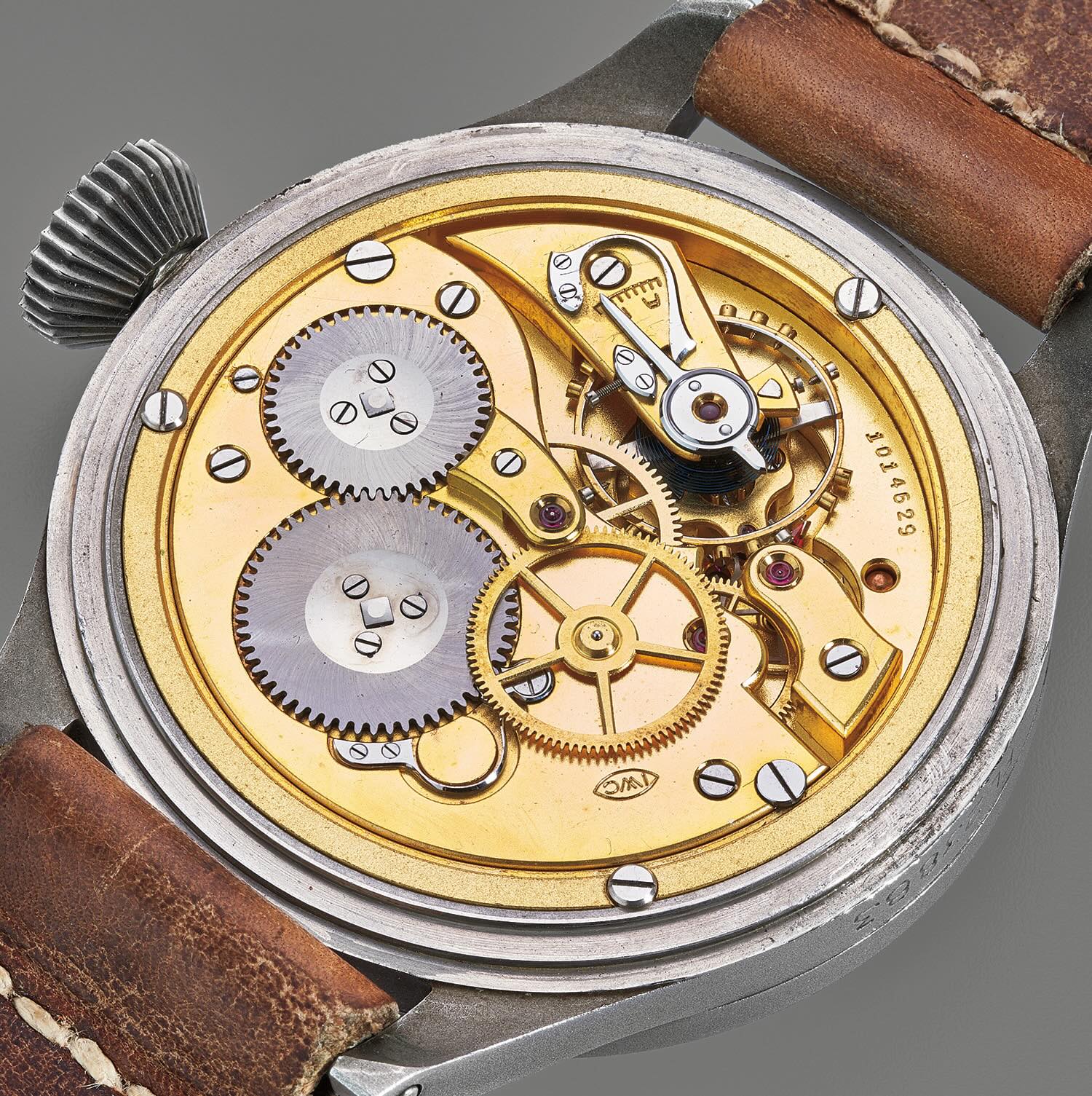

Over 460,000 examples of Calibres 52 and 53 were produced from 1888 to 1940, making them not only the most prolific movements in IWC’s history but also the longest continuously produced. Known for their strength and durability, these movements were the mechanical tractors of their era: highly accurate, thick, and dependable, if not elaborately decorated. Over the decades, the Calibre 52 underwent certain refinements, like changes to the regulator system and height adjustments. One major functional evolution was the adaptation from subsidiary seconds to indirect central seconds, a crucial feature for aviation watches that required hacking seconds for precise time setting. This final, military-grade version, the Calibre 52 T.S.C., was produced in a final batch of 1,200 units in 1940, specifically for two roles: powering IWC’s Big Pilot’s Watch Ref. 431 and equipping British Navy deck chronometers.
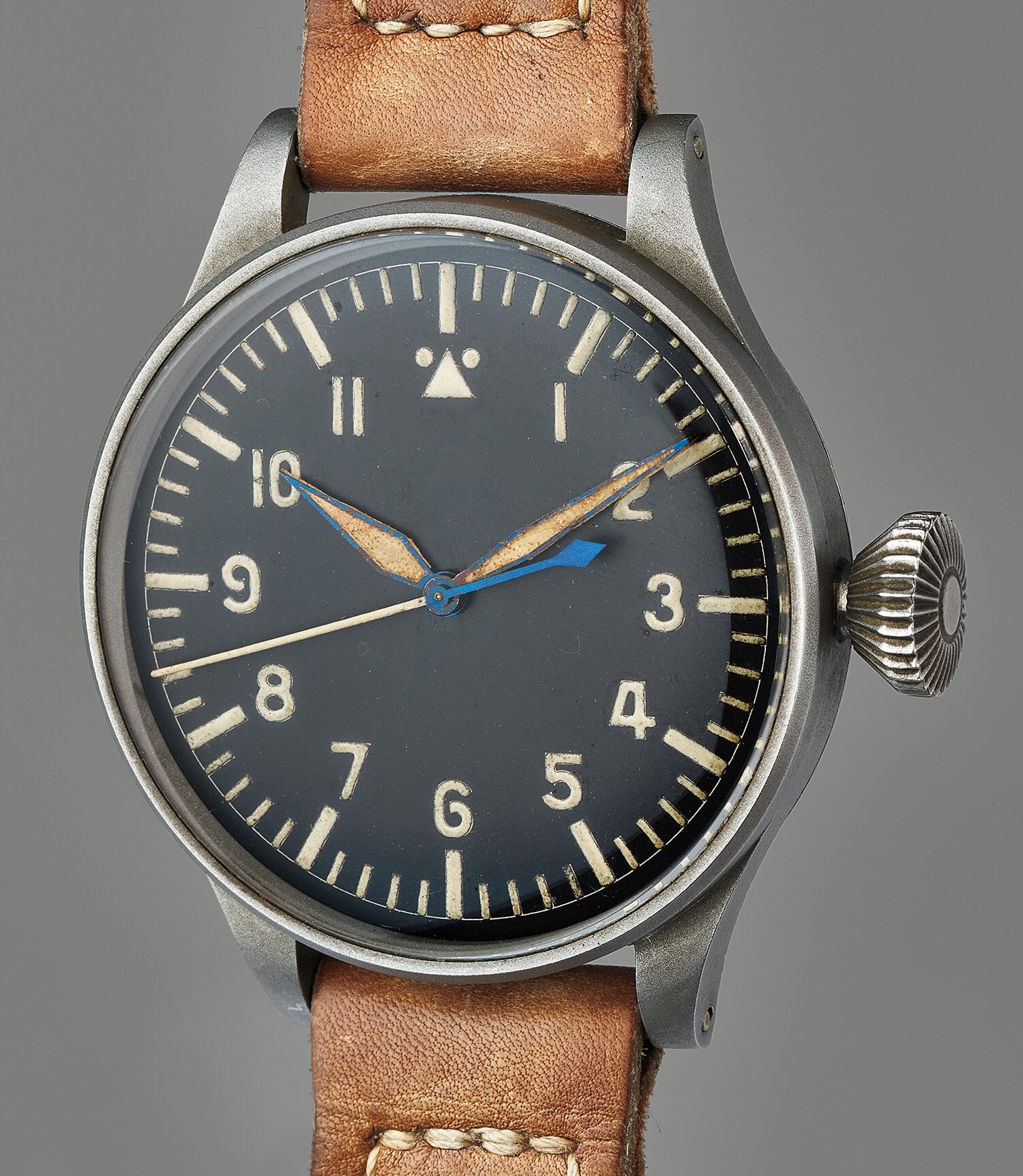

The Reference 431’s defining features were built around pilot usability and wartime practicality. Its large conical crown could be easily operated while wearing gloves, and its stark black dial, with luminous Arabic numerals and hands, followed the Baumuster A layout specified for B-Uhren. These traits ensured excellent legibility, even in low-light or high-stress environments. The dial took visual cues from the instrument panels of the Junkers JU 52, reinforcing its identity as an aviation instrument first, and a wristwatch second.
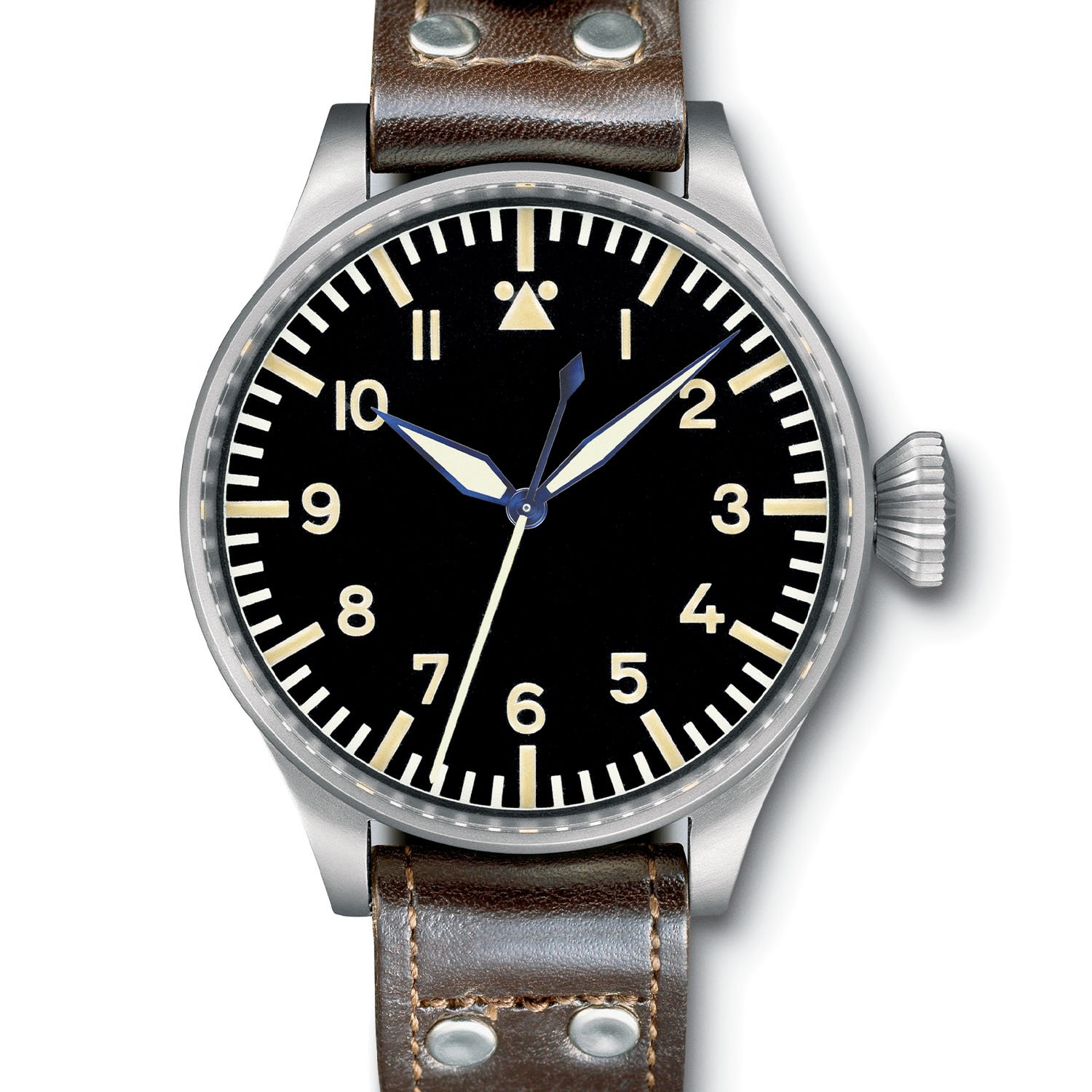

Though IWC was one of five official B-Uhr suppliers alongside A. Lange & Söhne, Laco (Lacher & Company/Durowe), Stowa (Walter Storz), and Wempe (Chronometerwerke Hamburg), the Ref. 431 stands out for its superior movement lineage and faithful execution of technical specifications.
2002, The Return of the Big Pilot, a.k.a Die Grosse Fliegeruhr
The Grosse Fliegeruhr stayed in retirement until 2002, when IWC introduced the Big Pilot’s Watch Ref. IW5002, a reinterpretation of the original Ref. 431. Envisioned by IWC’s legendary leader Günter Blümlein, the revival was a tribute to both IWC’s wartime engineering and its distinctive design language. Internally named the Mark XXI during development, the new IWC Big Pilot featured an automatic movement, power reserve indicator, and all the signature elements of the original, including its imposing presence. And some bold advertising campaigns too, in classic Blümlein style…
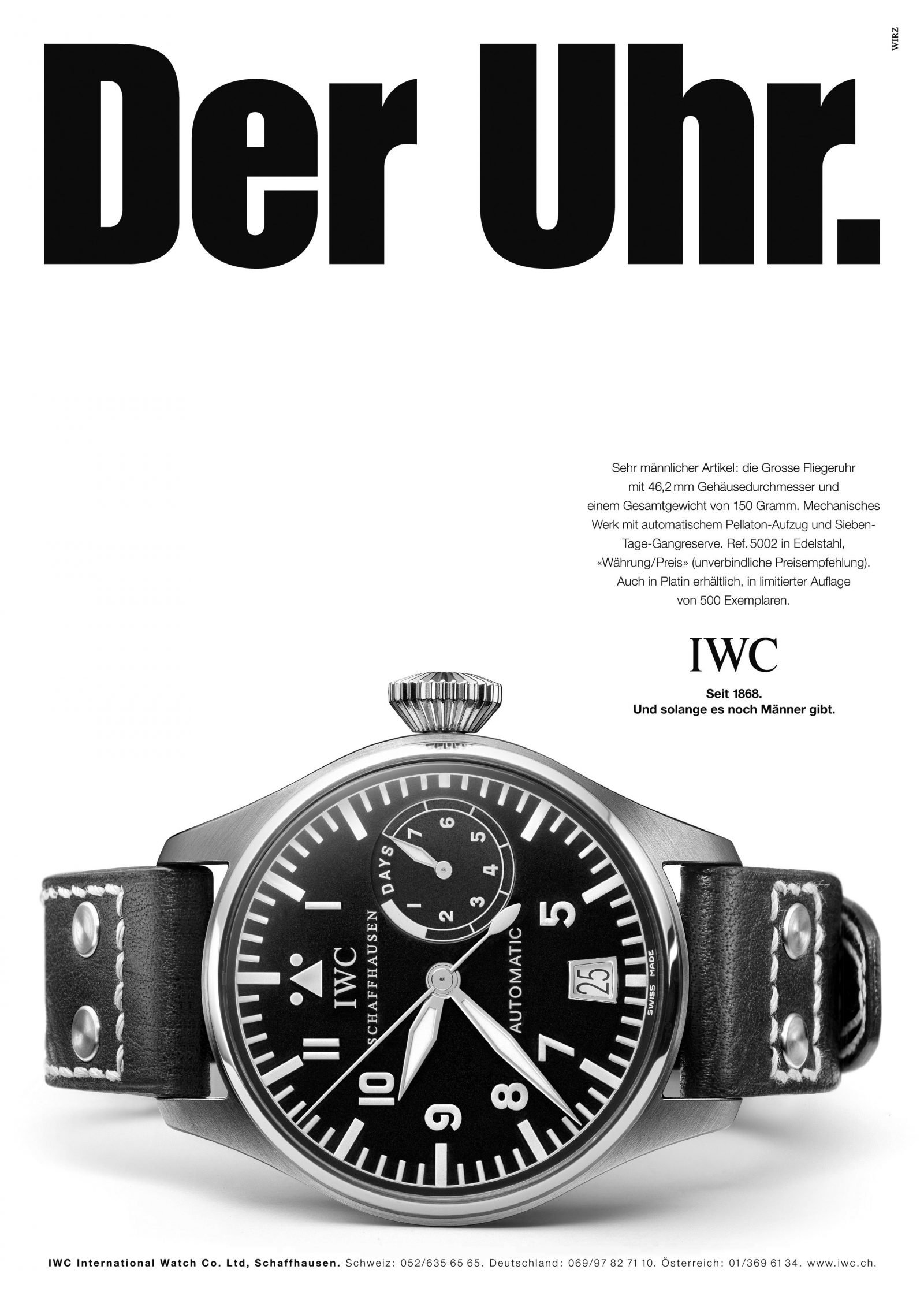

2002 – The Original – The IWC Big Pilot’s Watch Ref. IW5002
The IWC Big Pilot’s Watch Reference IW5002 was introduced in 2002. Measuring 46mm in diameter and 15.8mm in height, the IW5002 was deliberately large. Its proportions were balanced, not brash, and echoed the tool-watch philosophy from which it was born. The stainless steel case (the watch was also offered in a limited platinum edition) housed a soft iron inner cage that provided magnetic resistance up to an impressive 32,000 A/m, far beyond the industry norm of 4,800 A/m.
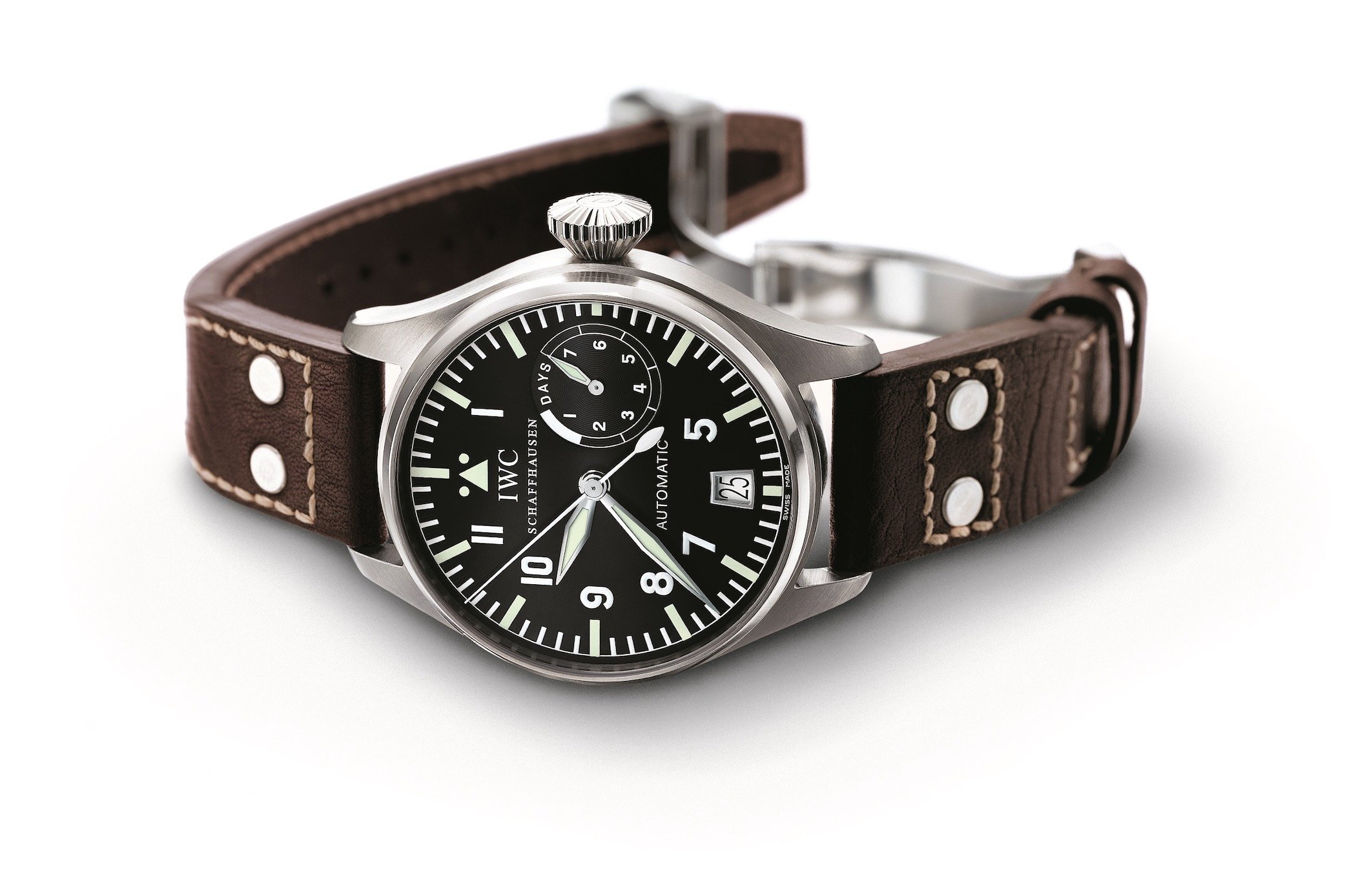

An oversized screw-in cone-shaped “fish” crown reinforced the original design language. The anti-reflective sapphire crystal was pressure-resistant and designed to withstand sudden drops in cabin pressure, further enhancing the watch’s robustness. The matte black dial (or deep blue in the platinum version) remained legible in any light, with Arabic numerals and indices treated in Super-LumiNova. The luminous hands followed the original 1940s design, providing both an aesthetic and functional link to its heritage. A date window was positioned at 6 o’clock, subtly integrated without disrupting the dial’s symmetry.
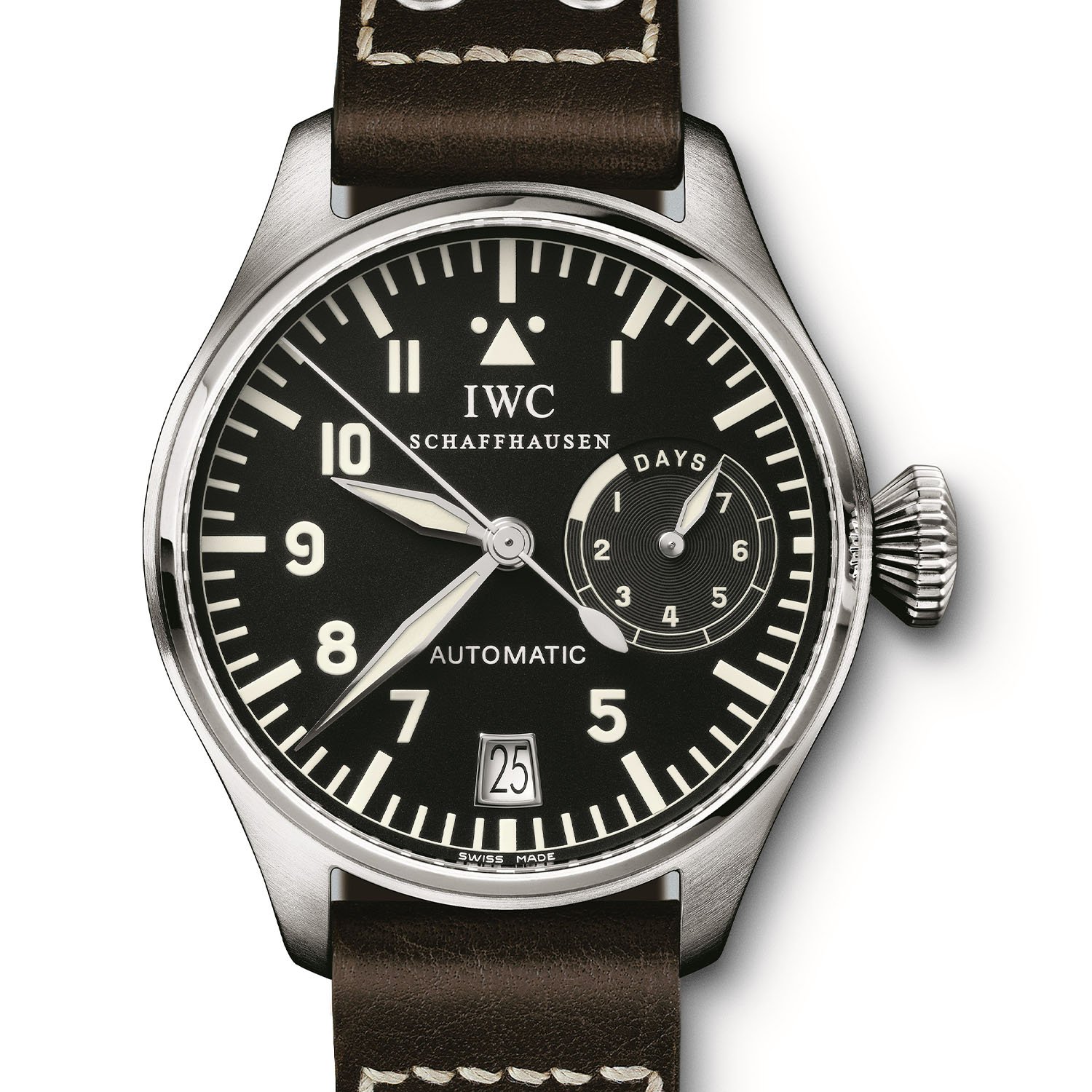

Beneath the industrial exterior lay IWC’s in-house calibre 5011 (produced from 2002 to 2003), beating at 18,000 vibrations/hour, which was later updated with faster 21,600 vibrations/hour operation to become Cal. 50110 (2003–2005), then to 51110 (2005–2006), and finally to 51111 (from 2006 onward). The Cal. 5011 was a new version of the Cal. 5000, introduced in 2000 with the Portugieser 2000. Cal. 5000 marked the return of IWC to in-house movement development, and the 5011 adopted its features, the impressive power reserve, the Pellaton automatic winding system, and the 38.2mm diameter. However, with the 5011, this calibre family received the central seconds display and the date, while the power reserve indicator at 3 o’clock was retained.
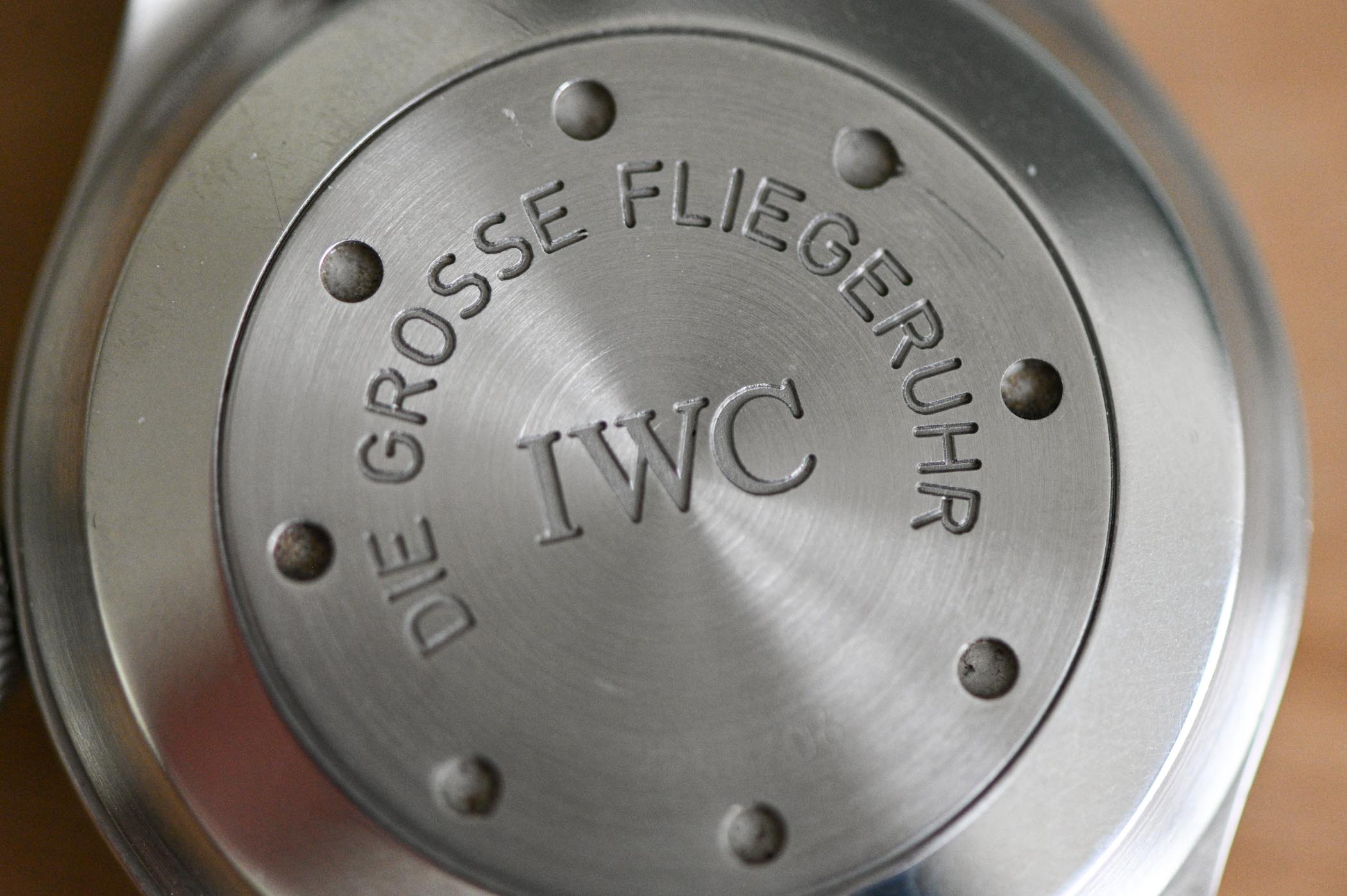

Measuring 38.2 mm across and 7.44 mm in height, the calibre 5011 comprised 334 components in 53 subassemblies and incorporated 44 functional rubies. The movement employed the refined Pellaton winding system, utilising a cam disc and dual pawls that converted bidirectional rotor motion into highly efficient winding. Even the slightest wrist movement charged the mainspring, while the spring-mounted rotor and ruby pawls enhanced durability and ease of servicing. The 5011 offered a power reserve of 8.5 days via a robust aluminium spring barrel and a mainspring that completed 13.6 revolutions when fully wound. However, to maintain consistent performance, the movement was mechanically stopped after precisely 168 hours (7 days). This thoughtful feature ensured the watch never entered a state of low-torque instability.
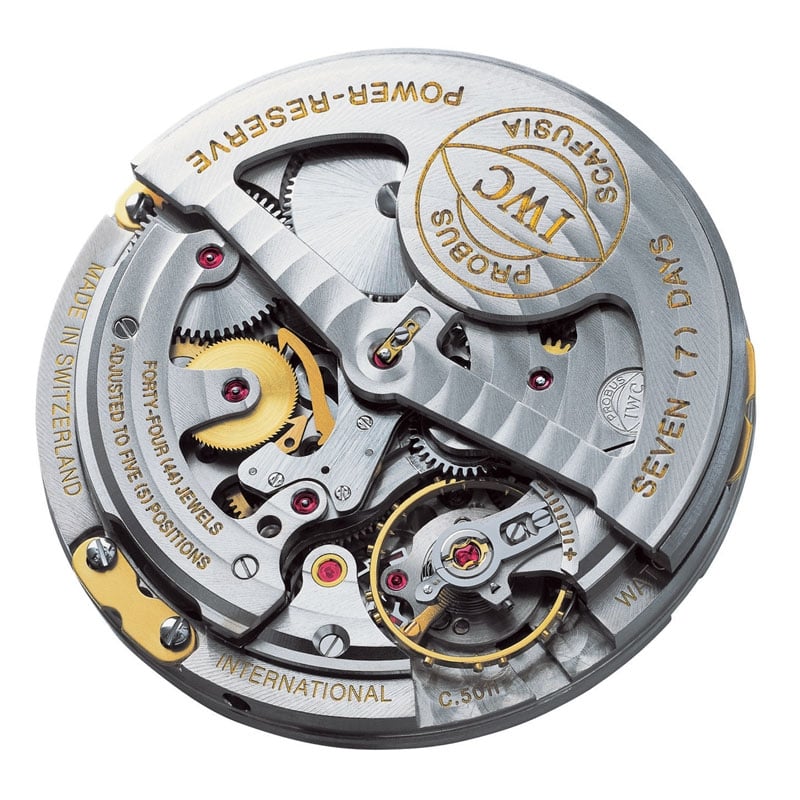

The escapement design also spoke to IWC’s dedication to precision. The 5011 employed a screw balance with 16 micro-adjustment screws and two regulation cams, derived from the exacting standards of the legendary Mark XI. The Nivarox 1 balance spring with a Breguet overcoil ensured thermal stability and operated at a frequency of 18,000 vibrations/hour (2.5Hz).
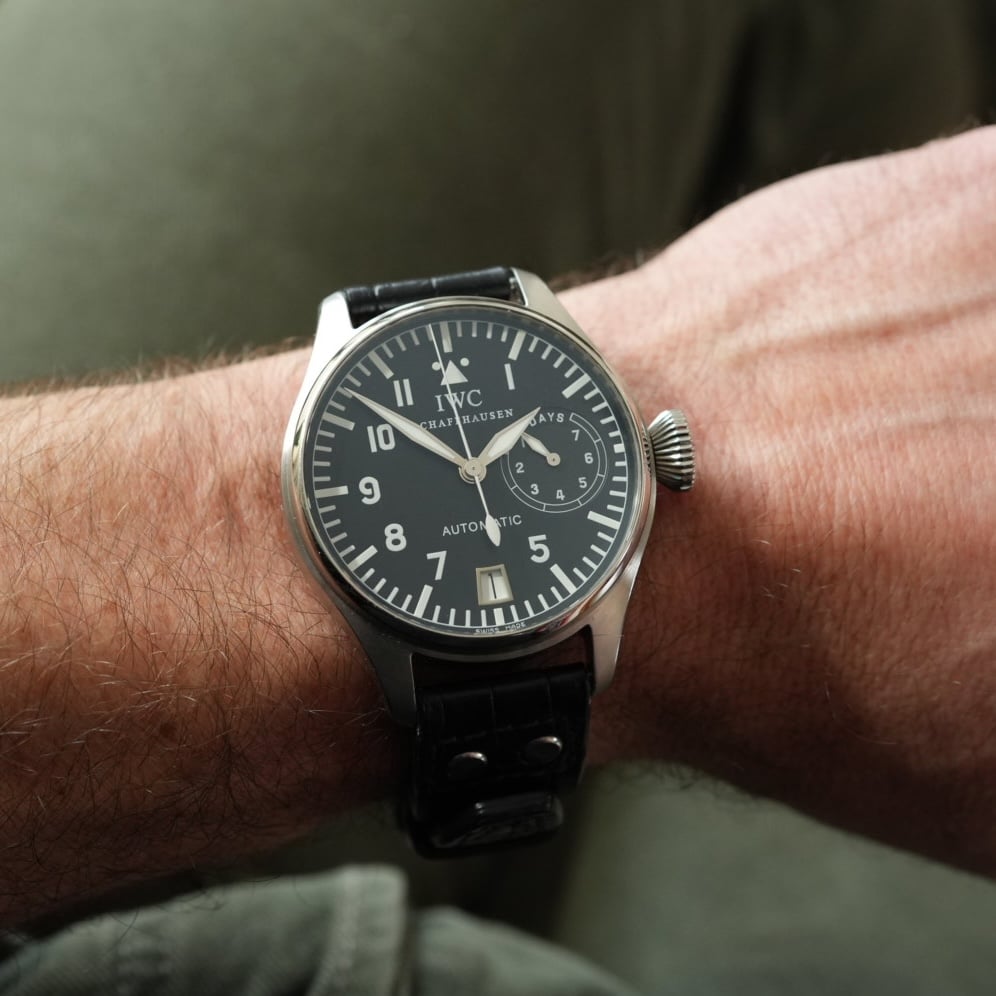

Although the caseback remained closed to preserve its antimagnetic shielding, the calibre’s decoration was notable: bridges were circular-grained, edges diamond-cut, and the rotor bore IWC’s “Probus Scafusia” motto in gold engraving, an emblem of quality from Schaffhausen.
2006 – The Big Pilot’s Watch IW5002 Transitional
Among the many chapters in the evolution of IWC’s Big Pilot, few are as elusive or as quietly significant as the Ref. IW5002 Transitional. Produced briefly in late 2005 through early 2006, this version of the original Big Pilot’s Watch marks an unofficial turning point in the line’s mechanical development. On the surface, it looks identical to the classic IW500201, but under the dial beats the calibre 51110, a newer, higher-frequency movement introduced just before IWC unveiled the fully updated Ref. IW500401 later that same year.
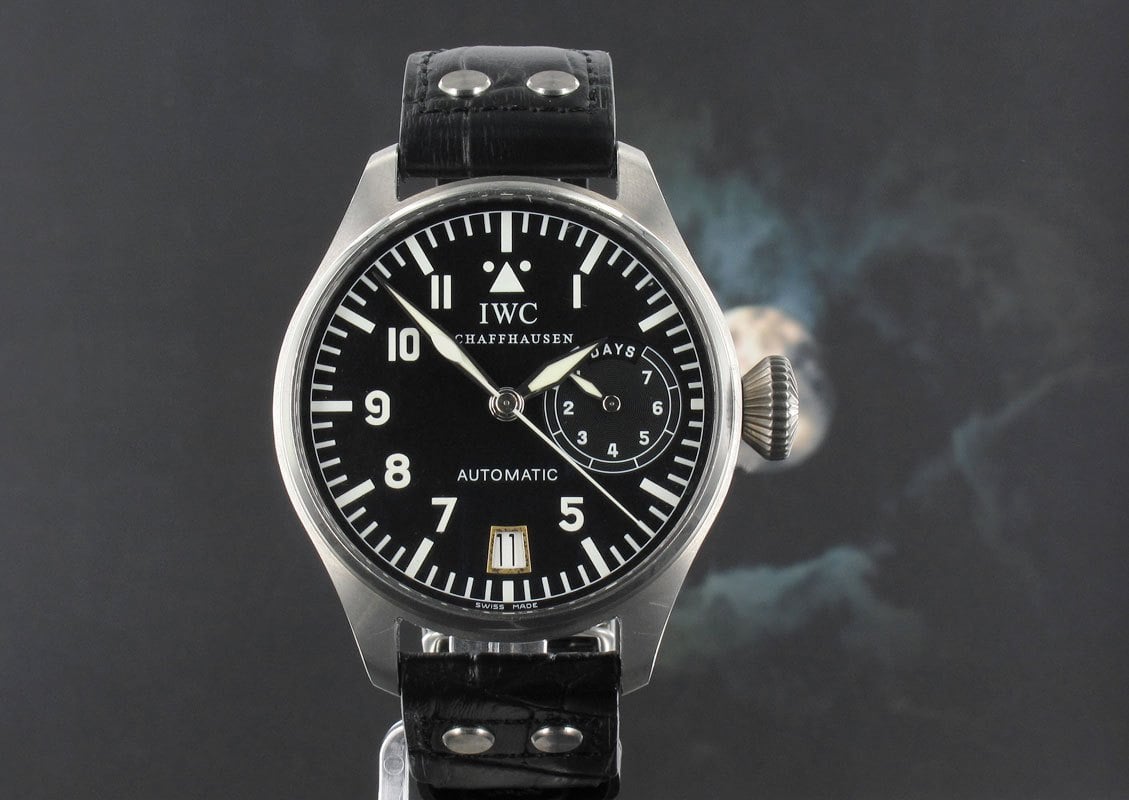

This shift from the original calibre 5011 to the 51110 may appear minor on paper, but it marked a leap in performance. The earlier 5011, beating at 18,000 vibrations/hour, wasn’t known to be the most precise… However, with the introduction of the 51110, IWC refined that formula by increasing the beat rate to 21,600 vibrations/hour, thereby improving timekeeping stability without compromising the movement’s iconic power reserve or reliability. Some IW5002 Transitional watches were equipped with Cal. 51111, a direct upgrade of Cal. 51110, which brought minor mechanical refinements and improved reliability. They came with an updated rotor with a medallion or engraving.
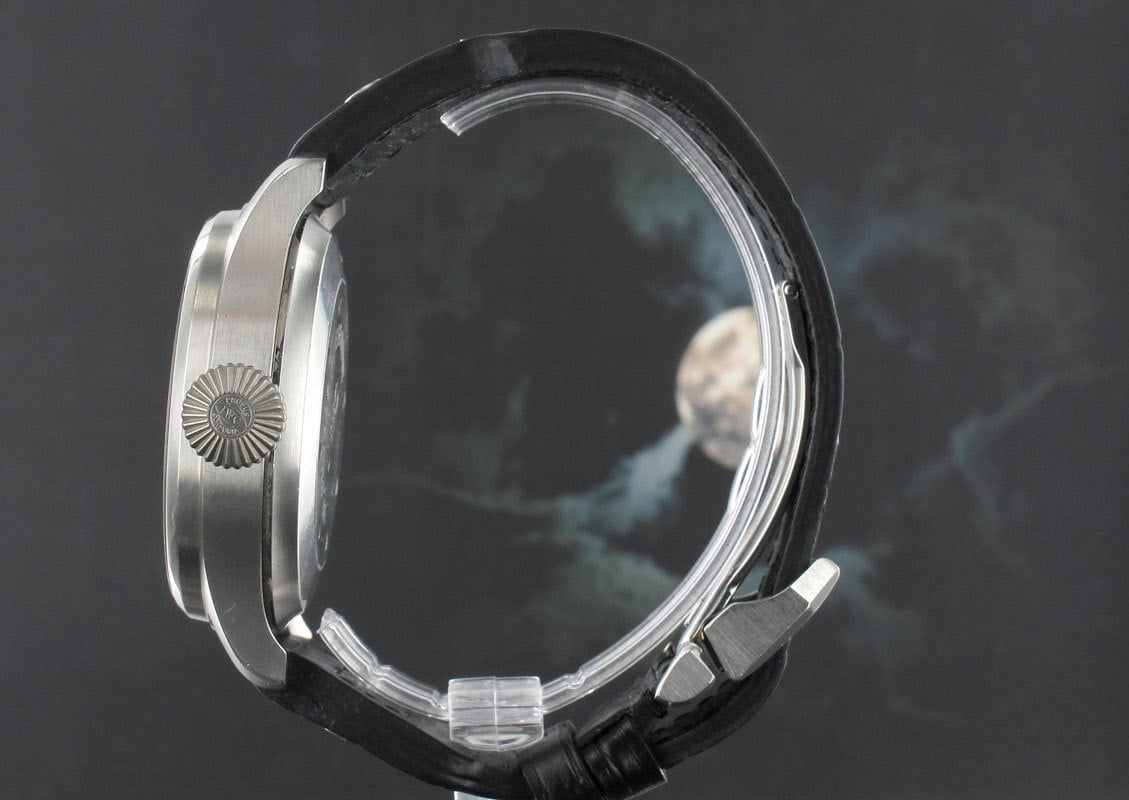

How many were made? No one knows for sure. There appear to be no official production records from IWC, and some point to the only semi-reliable marker: a serial number above 314XXXX, although even this isn’t conclusive. Tellingly, the only way to verify a Transitional 5002 is to examine the movement’s beat rate. And while some might point to the Probus Scafusia crown as evidence, that too is inconclusive, as IWC often replaced the original “fish” crowns during servicing unless specifically instructed not to do so.
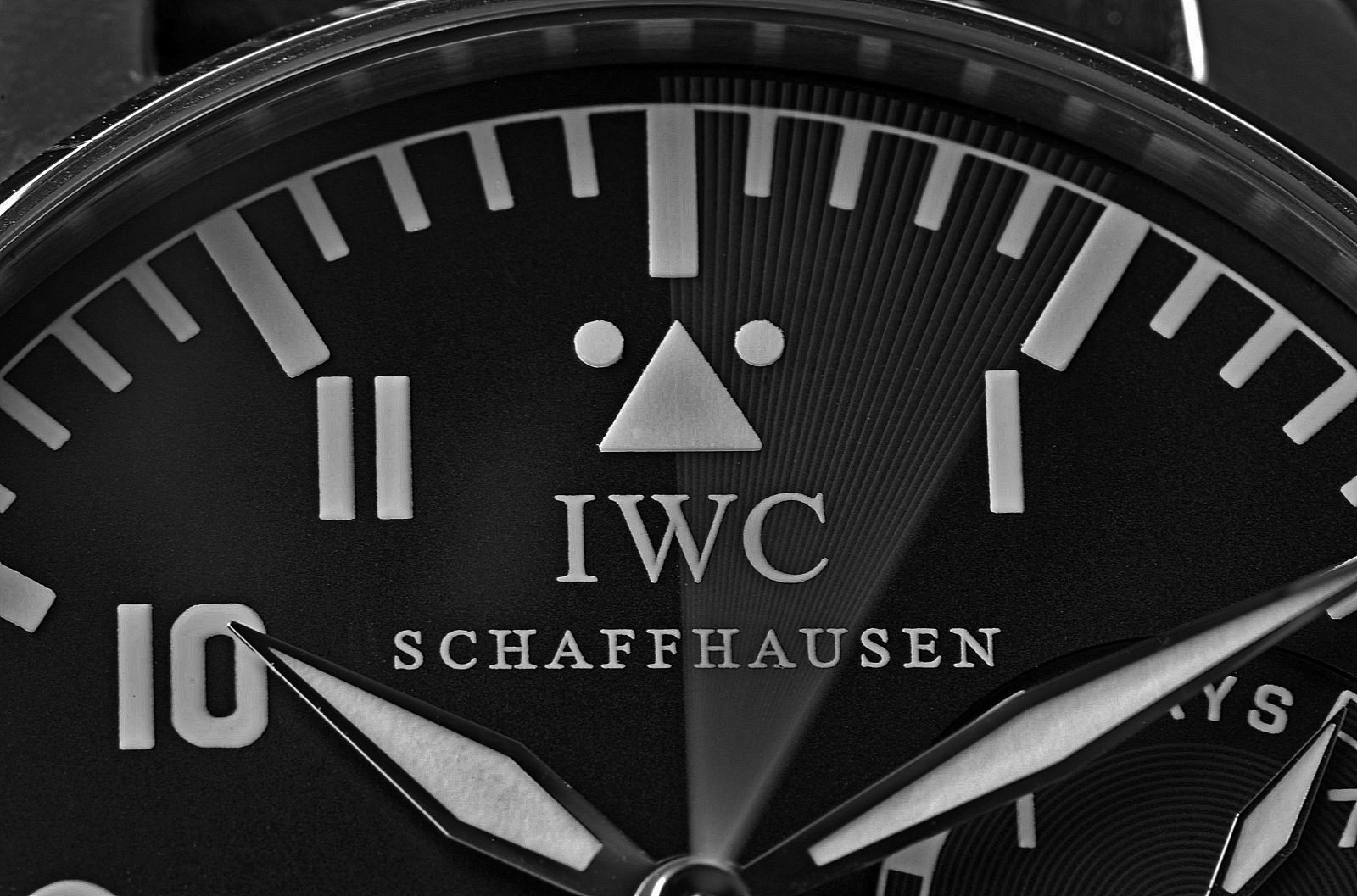

The IW5002 Transitional is a mechanical footnote that has evolved into a collector’s favourite, a fleeting reference for those who appreciate nuance, rarity, and the subtle shifts that define modern watchmaking history. It is a watch that bridges the romanticism of the early 2000s IWC with the precision and polish of what would follow, making it a moment in time, caught mid-transition.
2006 – The Big Pilot’s Watch IW5004, the Icon Takes Flight
Unveiled in 2006, the IWC Big Pilot’s Watch Ref. IW500401 marked a pivotal modernisation of one of the most iconic pilots’ watches ever made. As the direct successor to the Ref. IW5002, the IW500401 retained the imposing wrist presence and unmistakable aviation DNA of its predecessor, while refining the mechanics and aesthetics to usher in a more contemporary era for the Big Pilot line.
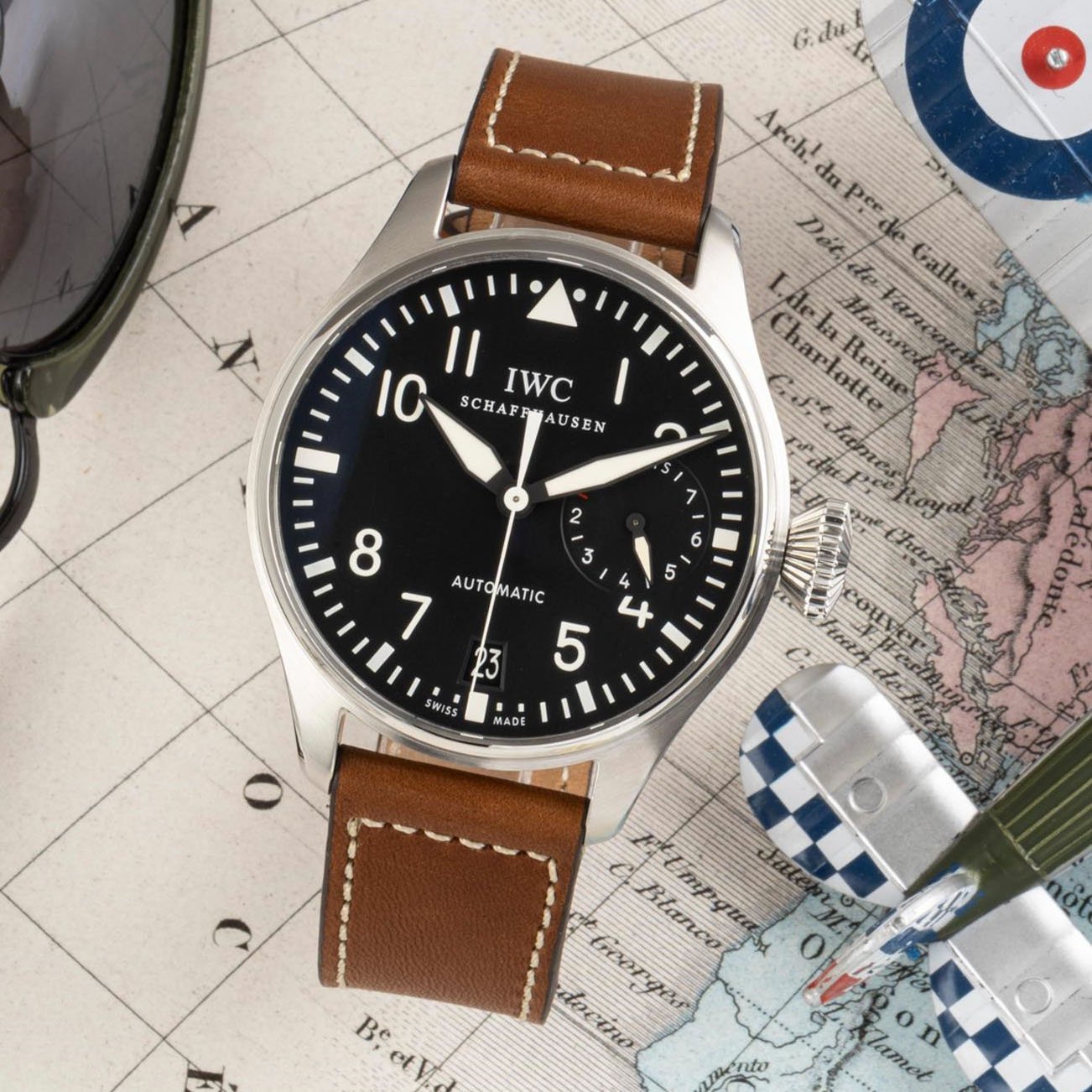

The IW500401 remained true to the spirit of early observation watches with its oversized 46.2mm stainless steel case, subtly more refined than its predecessor. The lugs were slightly more integrated into the case profile, lending the watch a more modern wrist fit. The polishing and brushing were more pronounced and precise. The IW5004 is also when the “Probus Scafusia” crown entirely replaced the crown with the “fish” emblem, used by IWC to mark its water-resistant watches (all BPs boasted 60m water-resistance, only recently it was upgraded to 100m).
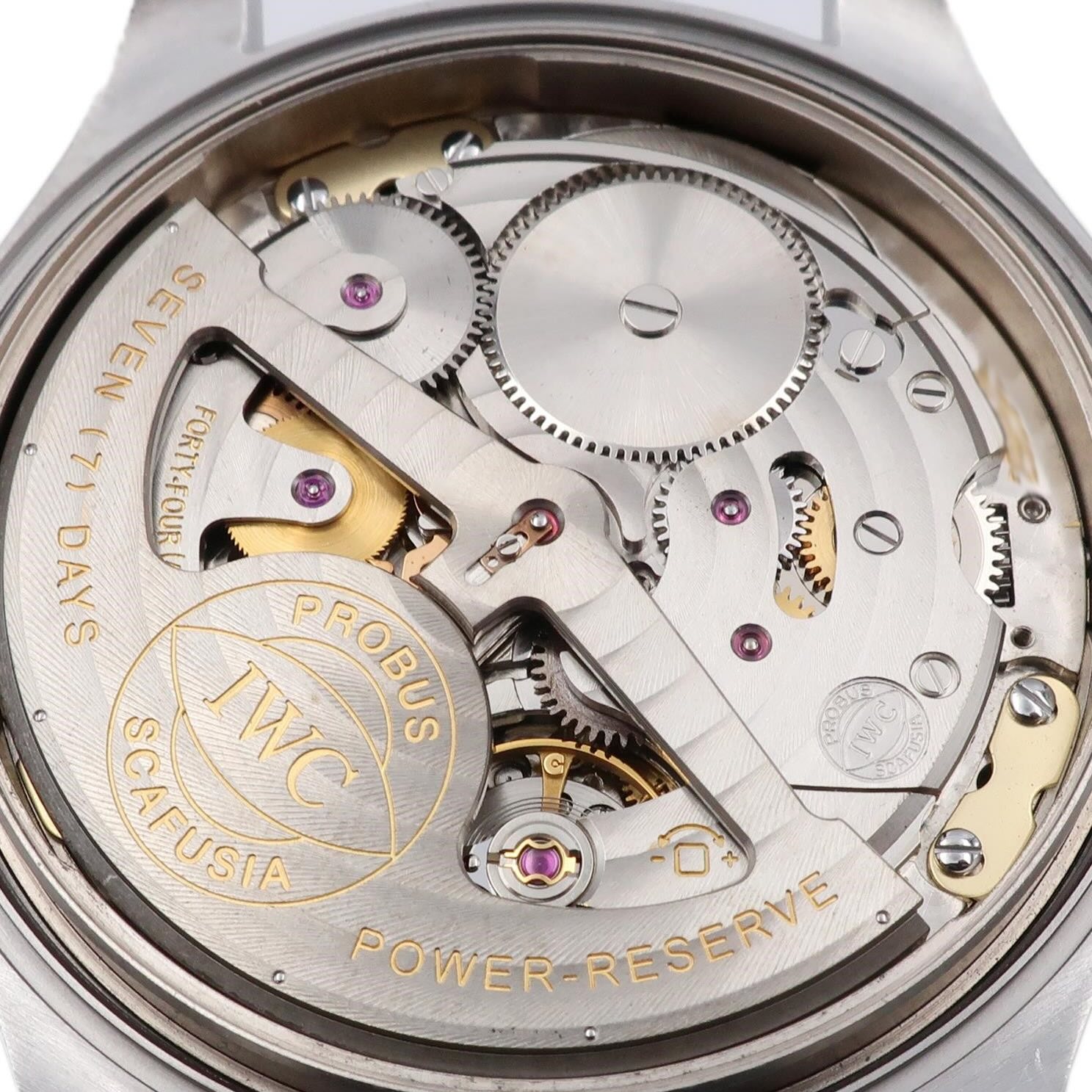

One of the key upgrades in the Ref. IW500401 was the movement: the calibre 51111. It was an evolution of the calibre 51110 used in the late-production “Transitional” 5002 models and the earliest version of the IW500401 (in 2006 only), and brought with it a suite of improvements. Like the 51110, the 51111 used IWC’s proprietary Pellaton winding system and a 3Hz frequency (21,600vph). The movement still packed a massive 7-day (168-hour) power reserve, stored in a single oversized barrel. The 51111 also featured enhanced shock protection and a balance bridge rather than a balance cock, improving stability and resilience.
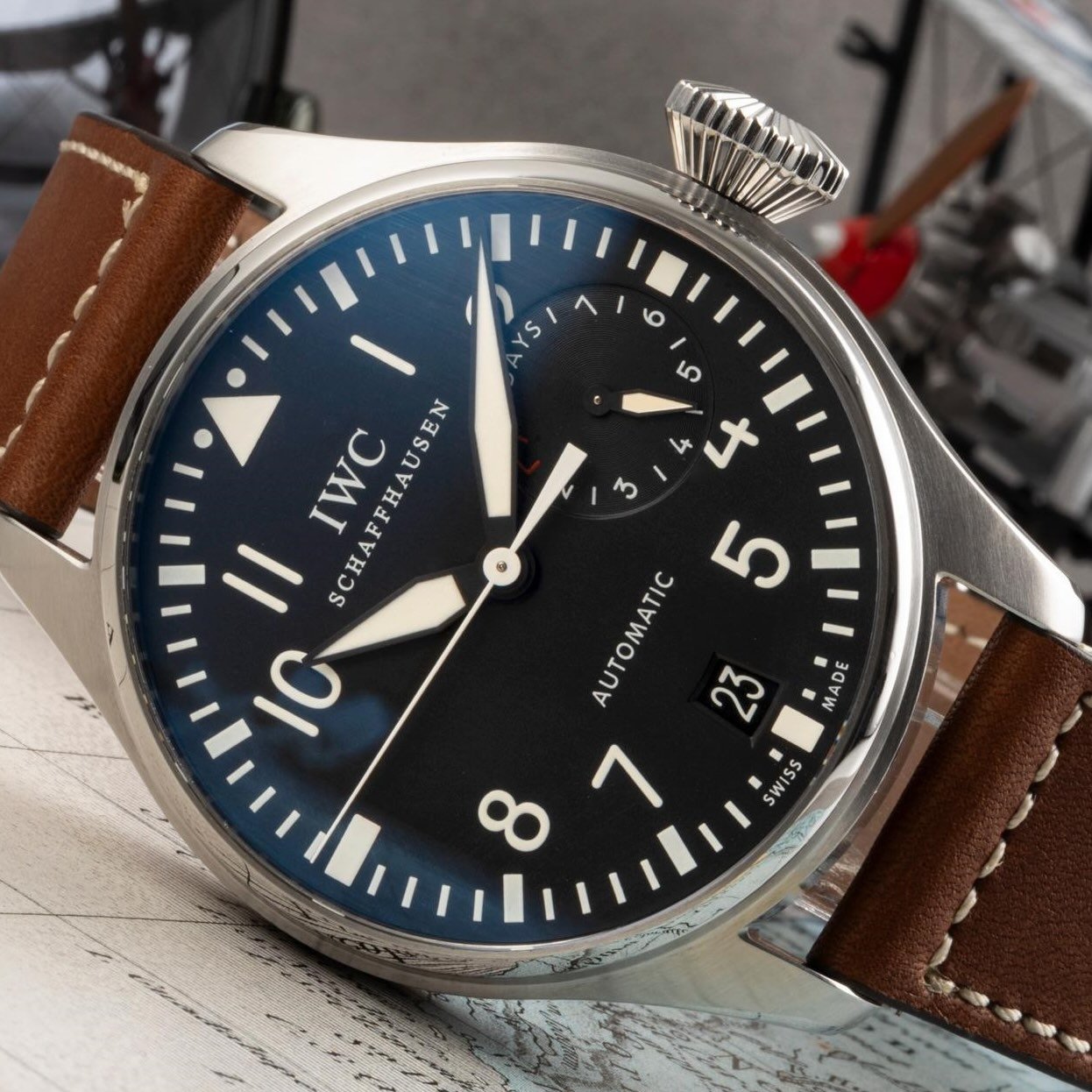

While the IW5004 dial layout remained largely faithful – central sword hands, triangle at noon, power reserve at 3, and date at 6 – the details were reworked for better balance and legibility. Compared to the 5002, the Arabic numerals and hour indices on the 500401 were updated, the 9 o’clock numeral was eliminated, and the triangle at 12 o’clock was smaller and moved up to become the 12 o’clock marker, making the dial feel a bit more airy while still focused. The minute track was sharper, with more precise printing, and the power reserve display was better integrated, with cleaner typography and a smaller visual footprint. The date window also received attention: the font used was a clearer sans-serif style, and the aperture was refined to appear more proportionate within the dial’s layout.
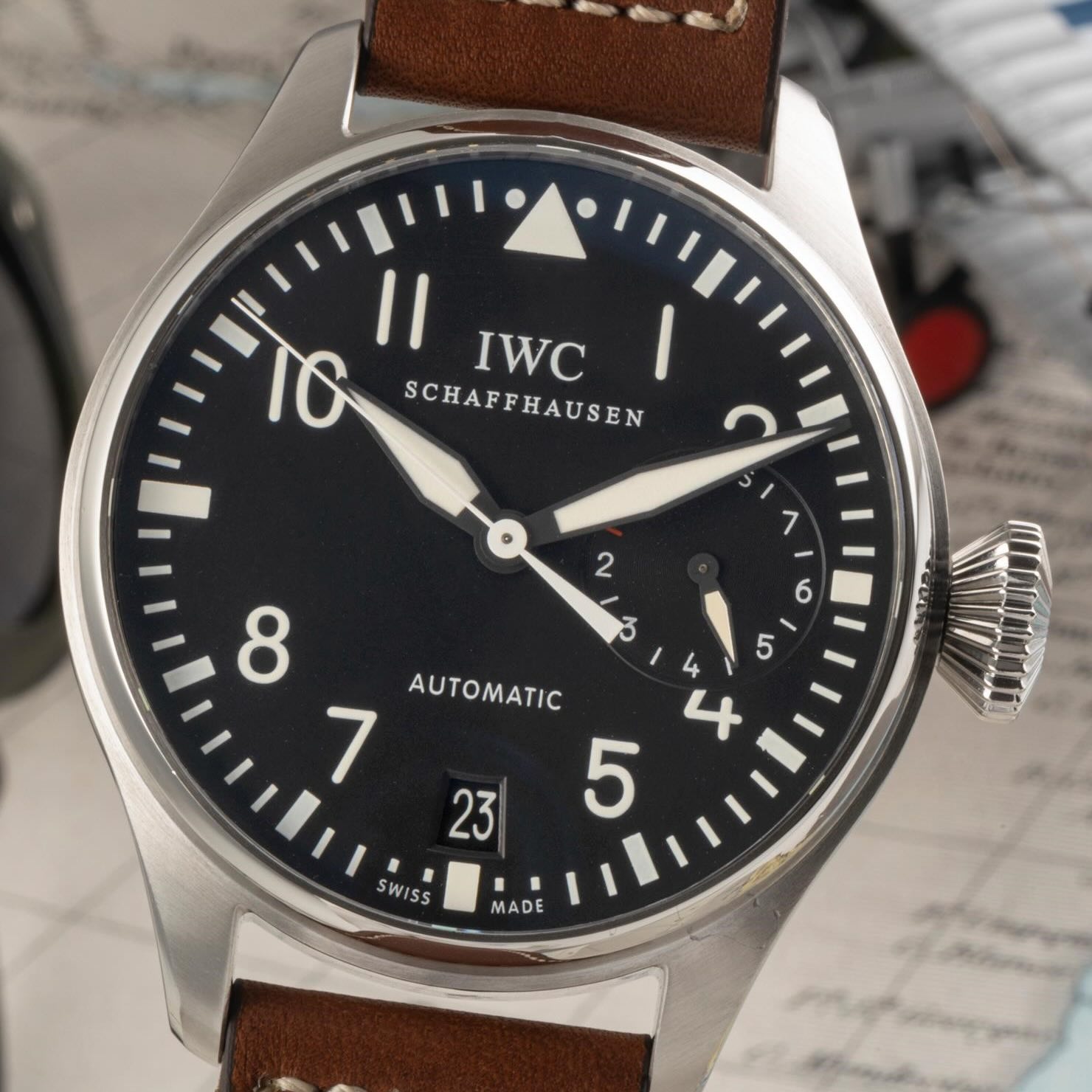

The Ref. IW500401 preserved the tool-watch soul of its forebearers, and with a refined case, a more modern and legible dial, and a high-performance in-house calibre 51111, it effectively laid the groundwork for all Big Pilots that followed.
2012-2018 – Big Pilot’s Watch IW500901 (2012) & IW500912 (2016), Legacy Refine
Among the various evolutions of the IWC Big Pilot model, the IW500901 and its closely related successor, the IW500912, represent the most refined iterations of the classic Big Pilot before the latest redesign.
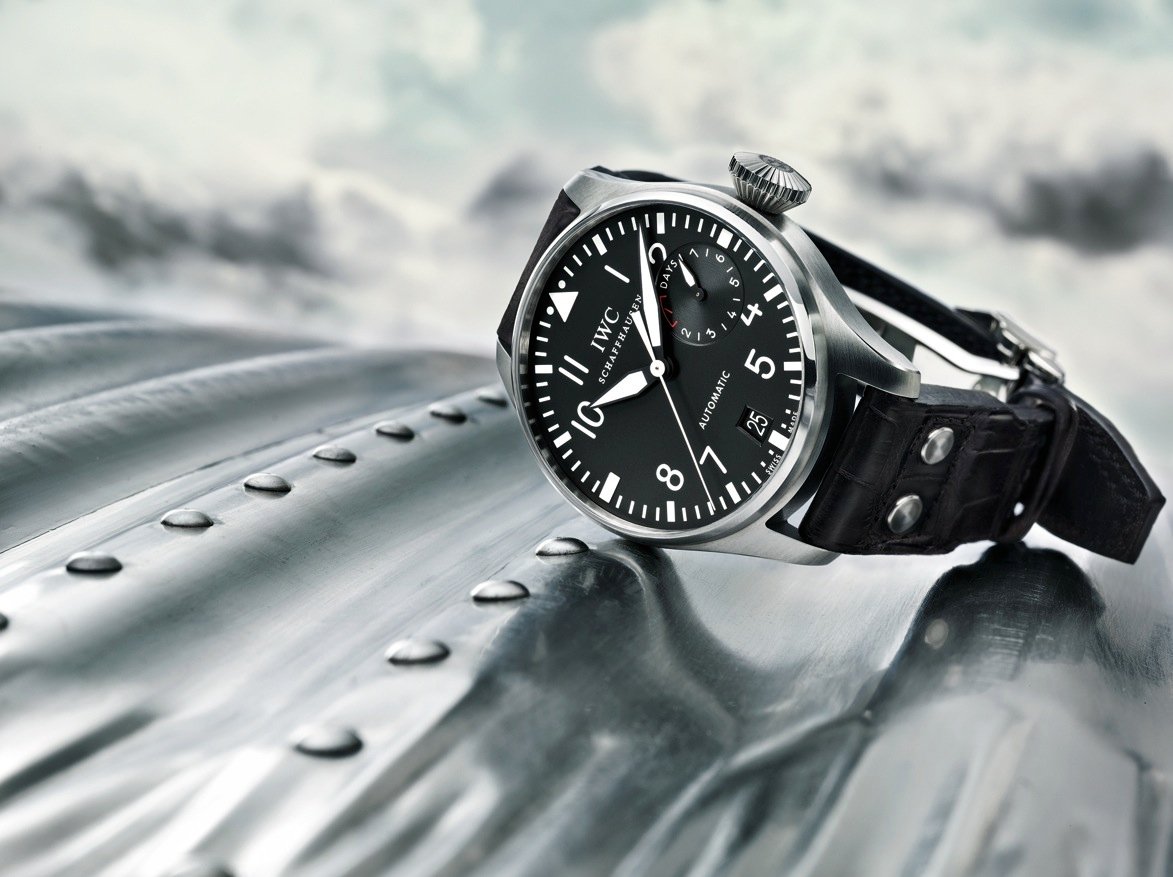

Launched around 2012, the Ref. IW500901 was built on the platform of the earlier IW500401, retaining the essential features that defined the modern Big Pilot: a 46.2mm stainless steel case, 15.7mm thick, with a new oversized crown and stem sealing system, powered by IWC’s Calibre 51111. This version slightly refined the Big Pilot’s aesthetic without compromising its instrument-like legibility. The black dial with luminous Arabic numerals, power reserve at 3 o’clock, and date window at 6 o’clock offered the same no-nonsense, highly functional layout. However, one distinctive feature remained from the earlier reference, the absence of the numeral “9”, with just a simple baton marker in position to maintain visual balance.
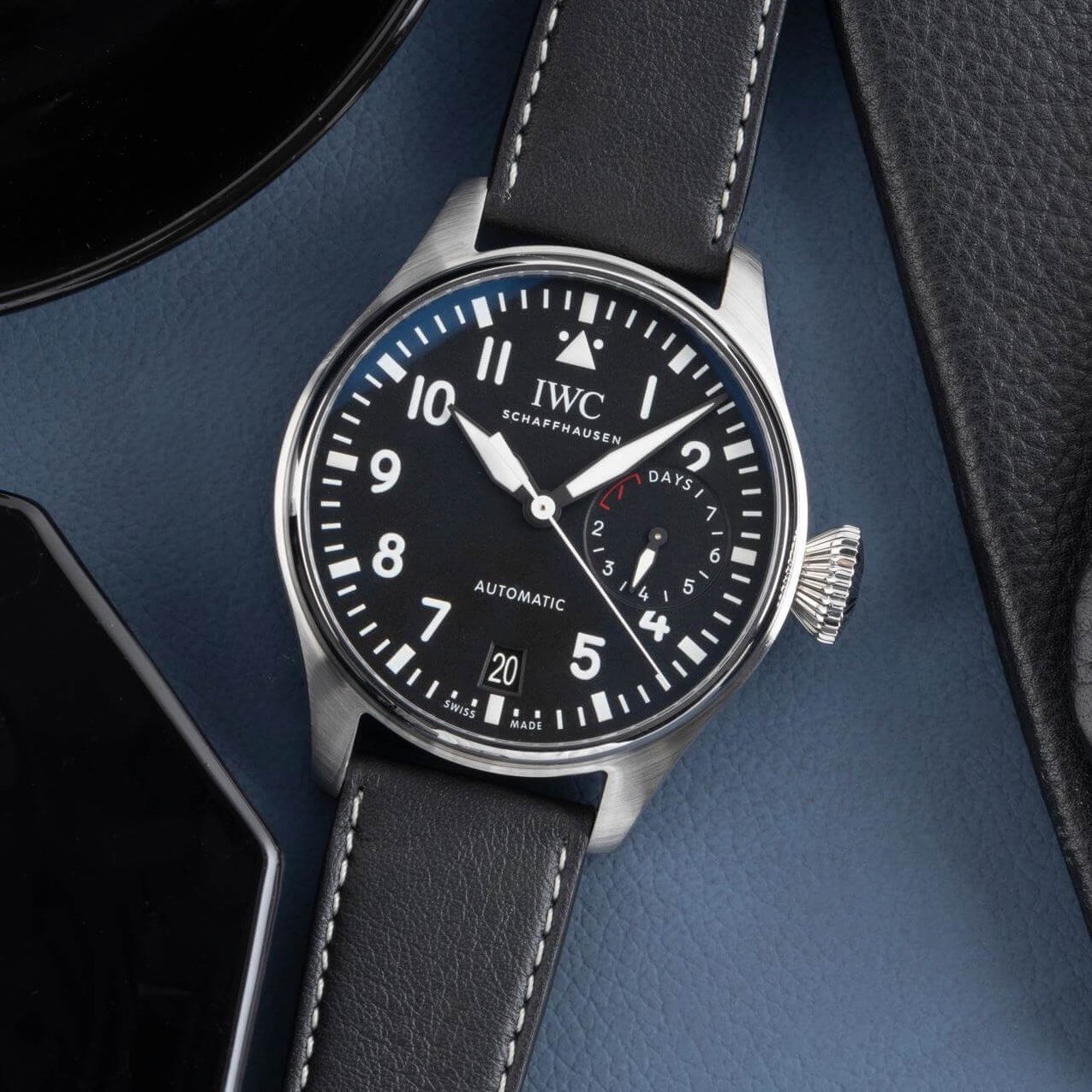

The IW500912, introduced as a direct successor to the IW500901 in 2016, maintained nearly identical technical specifications but came with subtle updates that signaled IWC’s commitment to pursue design balance and historical continuity: the numeral “9” returned; a small but impactful change, appreciated by purists who felt the missing “9” disrupted the visual cohesion of the classic purpose-built face.
2018 – The Big Pilot’s Watch Ref. IW501001, New Calibre for a New Era
With the launch of the Big Pilot’s Watch Ref. IW501001, IWC ushered its flagship Flieger into a new mechanical generation. Building on the visual legacy of the IW500912, the IW501001 maintains the unmistakable silhouette. Still encased in 46.2 mm of stainless steel, with a height of 15.6 mm, with an oversized crown, the IW501001 feels every bit as substantial and purposeful as earlier Big Pilots with its clean, functional dial layout. The black dial retains the clear Arabic numerals, date display at 6 o’clock, and the power reserve at 3, along with central seconds and IWC’s signature sword-shaped hands. Yet subtle refinements, like improved printing and a cleaner layout, quietly modernise the design.
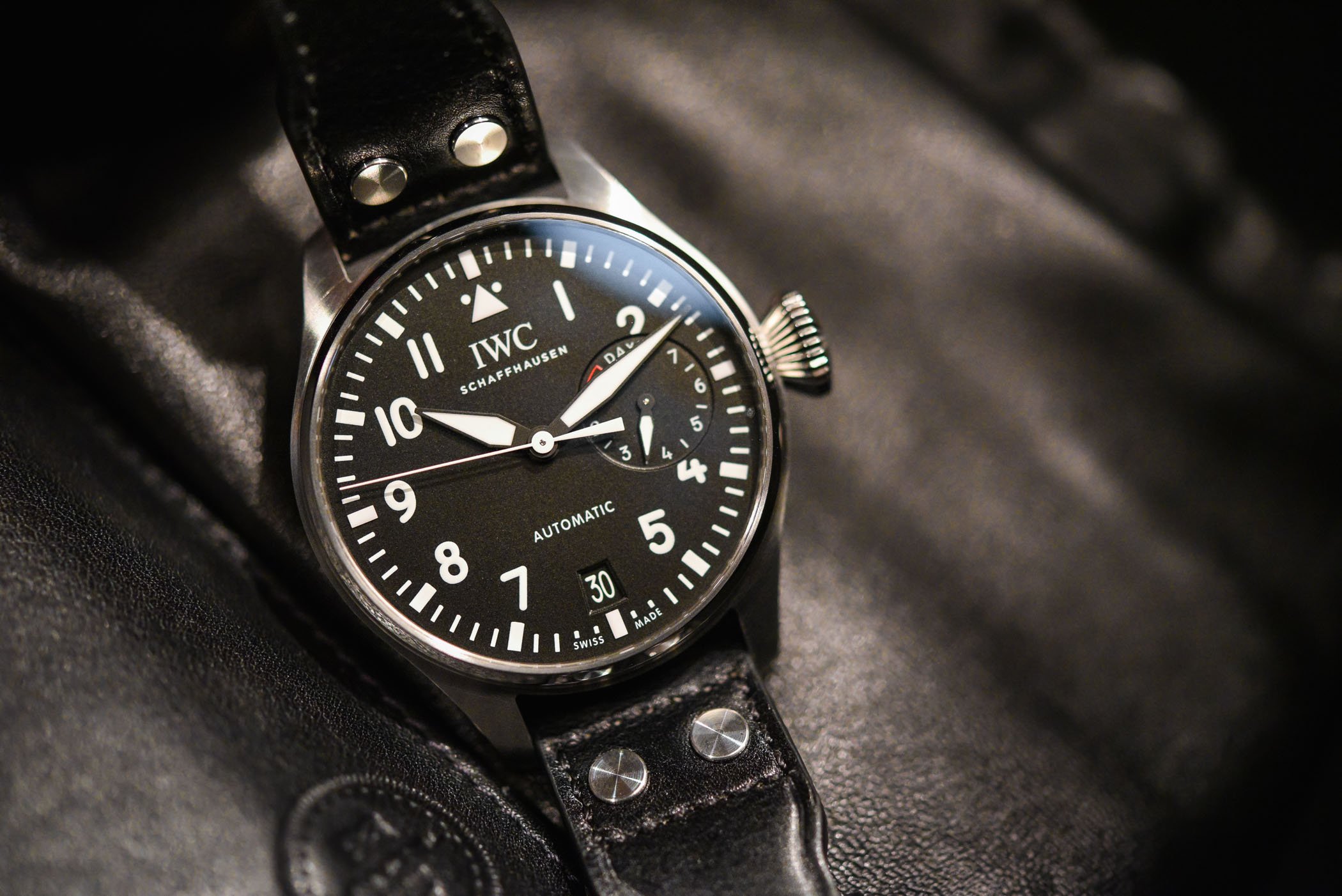

However, beneath the dial, it featured a significantly reengineered movement, the IWC-manufactured Calibre 52110, which is part of the next-generation 52000 movement family introduced in 2015. This movement marked a major step forward from the outgoing Calibre 51111, which powered the IW500912. While both calibres offered an impressive 7-day power reserve and featured IWC’s signature Pellaton automatic winding system, the 52110 brought a suite of upgrades that redefined long-term durability and precision.
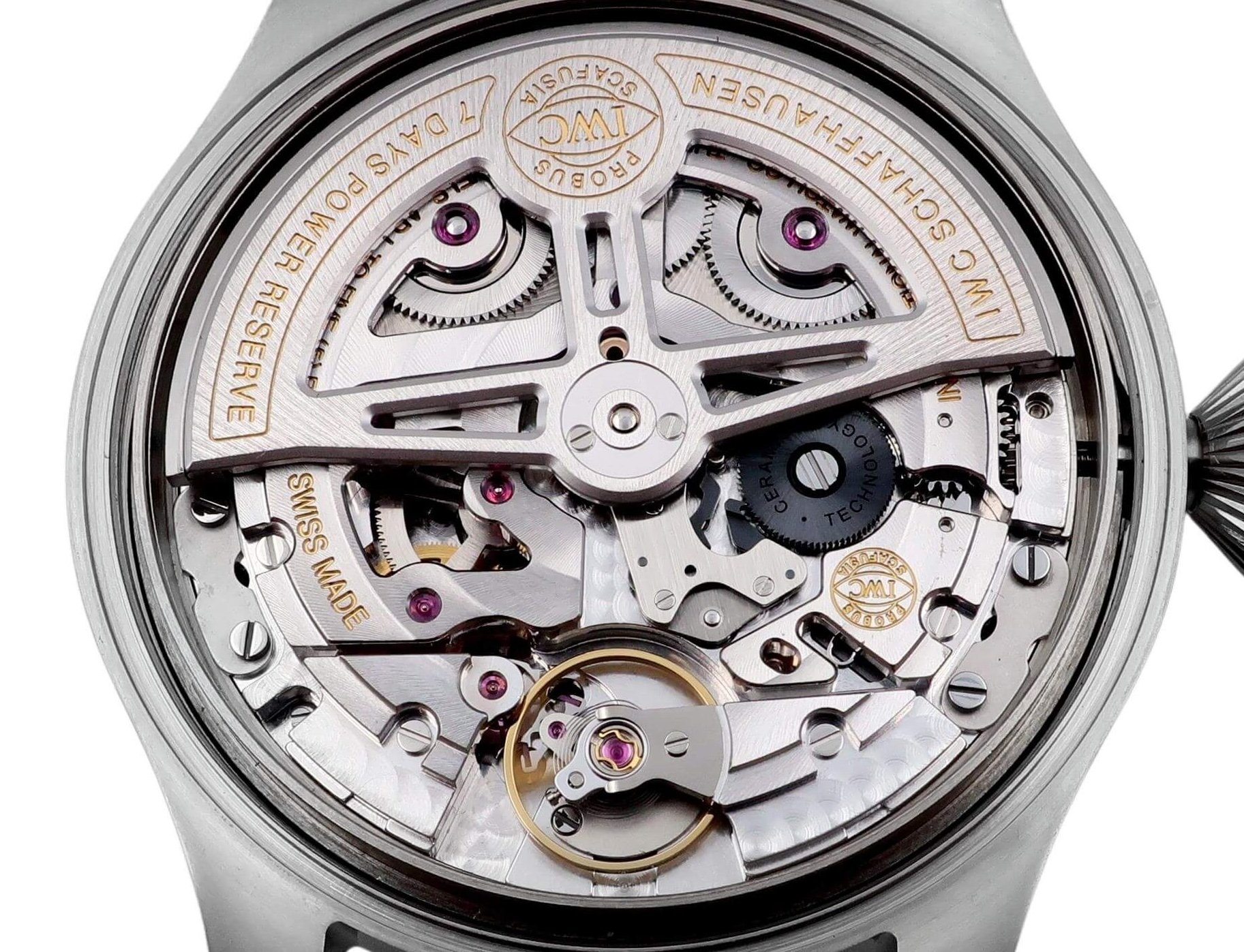

Most notably, the movement incorporates ceramic components for the winding pawls, automatic wheel, and the rotor bearing, making the winding system virtually wear-free. The addition of dual barrels (replacing the single barrel of the 51111) ensures more consistent torque delivery across the full power reserve. Furthermore, the beat rate has been increased to 4 Hz (28,800 vph), up from 3 Hz, enhancing chronometric stability. The movement’s aesthetics also received attention.
The Limited and Special Editions
Since 2002, when the original Ref. IW5002 was introduced, the Big Pilot watches were made in over 150 references, to include special and limited editions, and complications. The time-and-date (and power reserve) models for the most part differed in aesthetics, offering different dial designs, introducing new themes and materials, yet always retaining the essential Big Pilot’s features. For this chapter of our review, we have selected a few limited and special releases that felt important to us. Apologies if your favourite reference didn’t make the list, yet we start with the one that is unanimously accepted as the most distinctive and elusive interpretation of the IWC Big Pilot, the Ref. IW5003 “Markus Bühler” for it stands out not for being the most mechanically complex or lavishly decorated, but for its story, its aesthetic gesture, and the sheer rarity of its existence.
2008 – the Big Pilot’s Watch Ref. IW5003 Markus Bühler
Conceived in 2003 by then-apprentice Markus Bühler as a competition entry for a Richemont watchmaking contest, the concept took root at IWC and ultimately evolved into a limited production of only 12 pieces. Each was assembled and finished under Bühler’s supervision, along with a team of apprentices, an origin story that lends this watch an authentic, workshop-born character rarely found in commercial production. The Bühler edition appears to be a traditional Big Pilot’s Watch, retaining the robust 46.2mm stainless steel case, riveted leather strap, oversized crown, and “Baumuster A”-inspired dial of the original Ref. 5002. However, its most defining feature is immediately apparent in the small seconds subdial at 9 o’clock: a miniature aircraft turbine, spinning quietly in time to the seconds. A tiny red dot on one of the blades serves as the indicator.
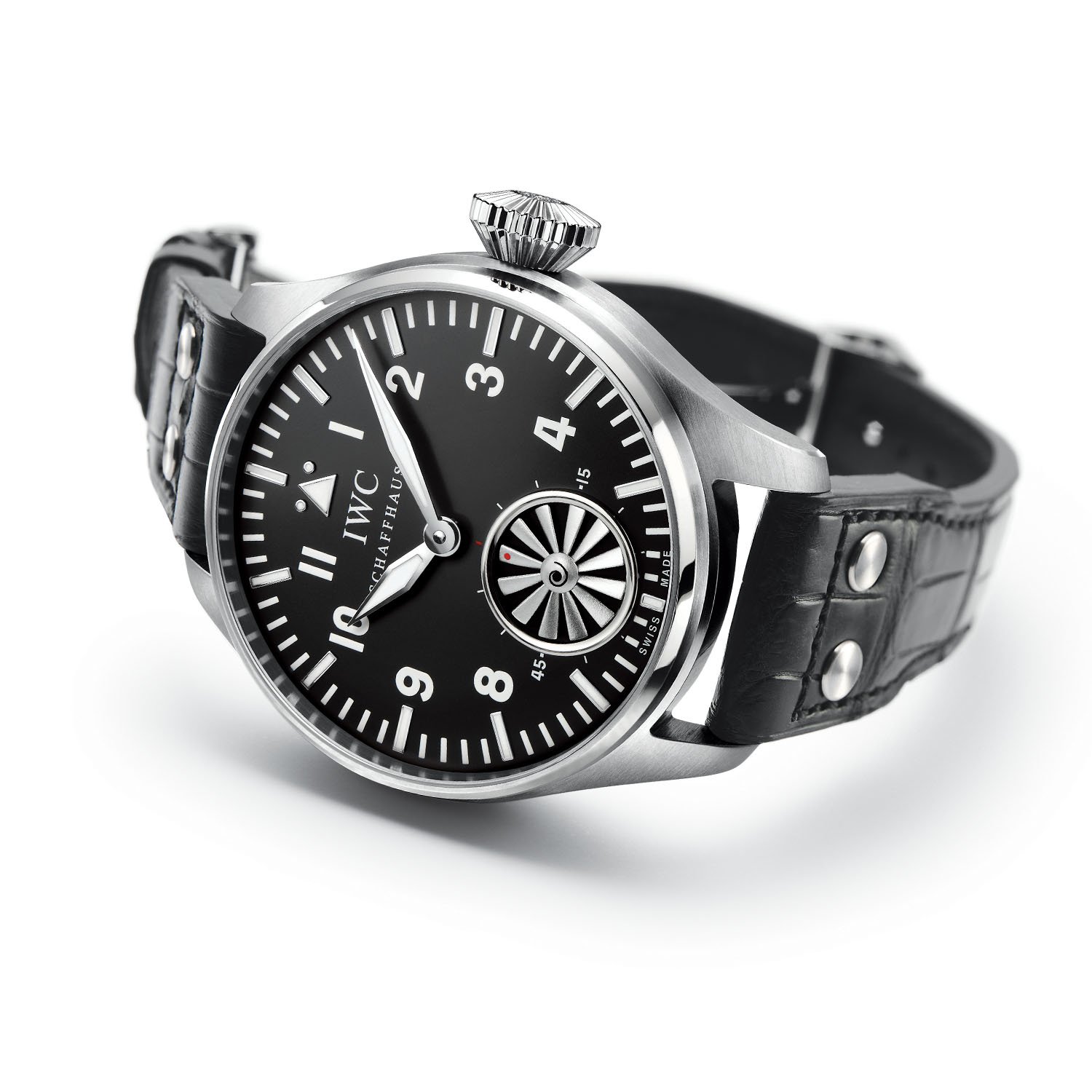

The movement is perhaps the most surprising part of the story. Rather than using IWC’s in-house Calibre 5000, the Markus Bühler relies on a modified Unitas 6498, reworked and renamed as Cal. 64900. But in this case, the modesty is deliberate and elevated. The rear turbine motif, replacing the traditional ratchet wheel, serves as both a decorative element and a mechanical metaphor. To mirror the jet-engine aesthetic, Bühler repositioned the striping on the movement bridges, allowing the Côtes circulaires to radiate outward from the turbine rather than from the centre, evoking the burst of energy that defines a jet engine.
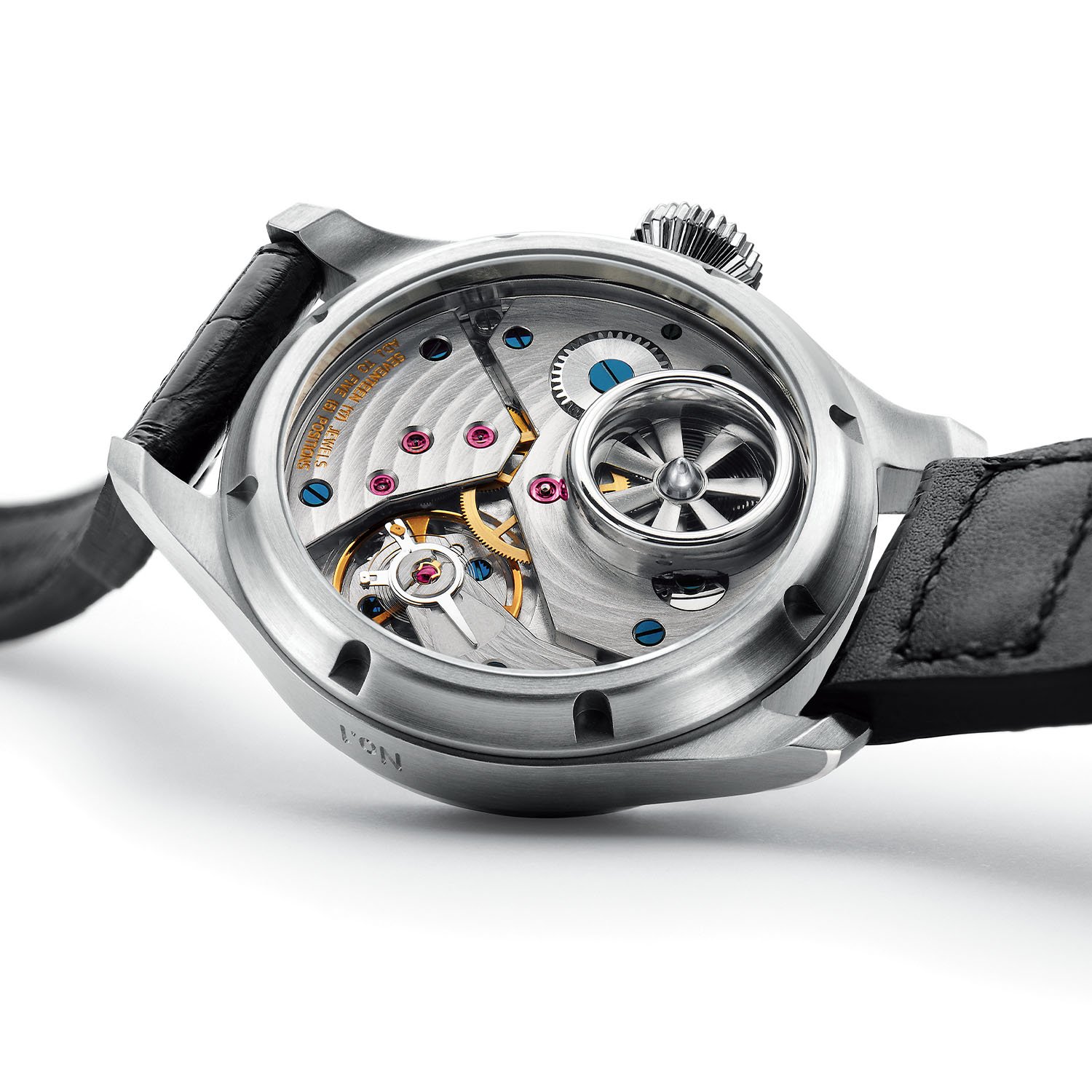

The rest of the finishing is surprisingly artisanal for a watch from such a major brand. The bevels are gently polished by hand, the countersinks bear clear milling marks, and the wheels of the going train show crisp circular graining. In 2023, IWC staged a comeback of the Bühler design, with an upgraded movement and platinum case, as the Big Pilot’s Watch 43 Tourbillon Markus Bühler, which retains the key elements of the 2008 original, but with a self-winding tourbillon movement with the flying tourbillon cage in the form of a turbine blade.
The Antoine de Saint-Exupéry and Le Petit Prince Editions
IWC Schaffhausen has maintained a long-standing and heartfelt partnership with the Antoine de Saint-Exupéry Youth Foundation. Created in 2009 by the descendants of the aviator and author of The Little Prince, the partnership is committed to promoting education and fighting illiteracy, especially among children in underprivileged communities around the world. As we will see, this partnership has produced numerous “firsts” within the collection, many of which debuted under the Le Petit Prince or Antoine de Saint-Exupéry sub-series.
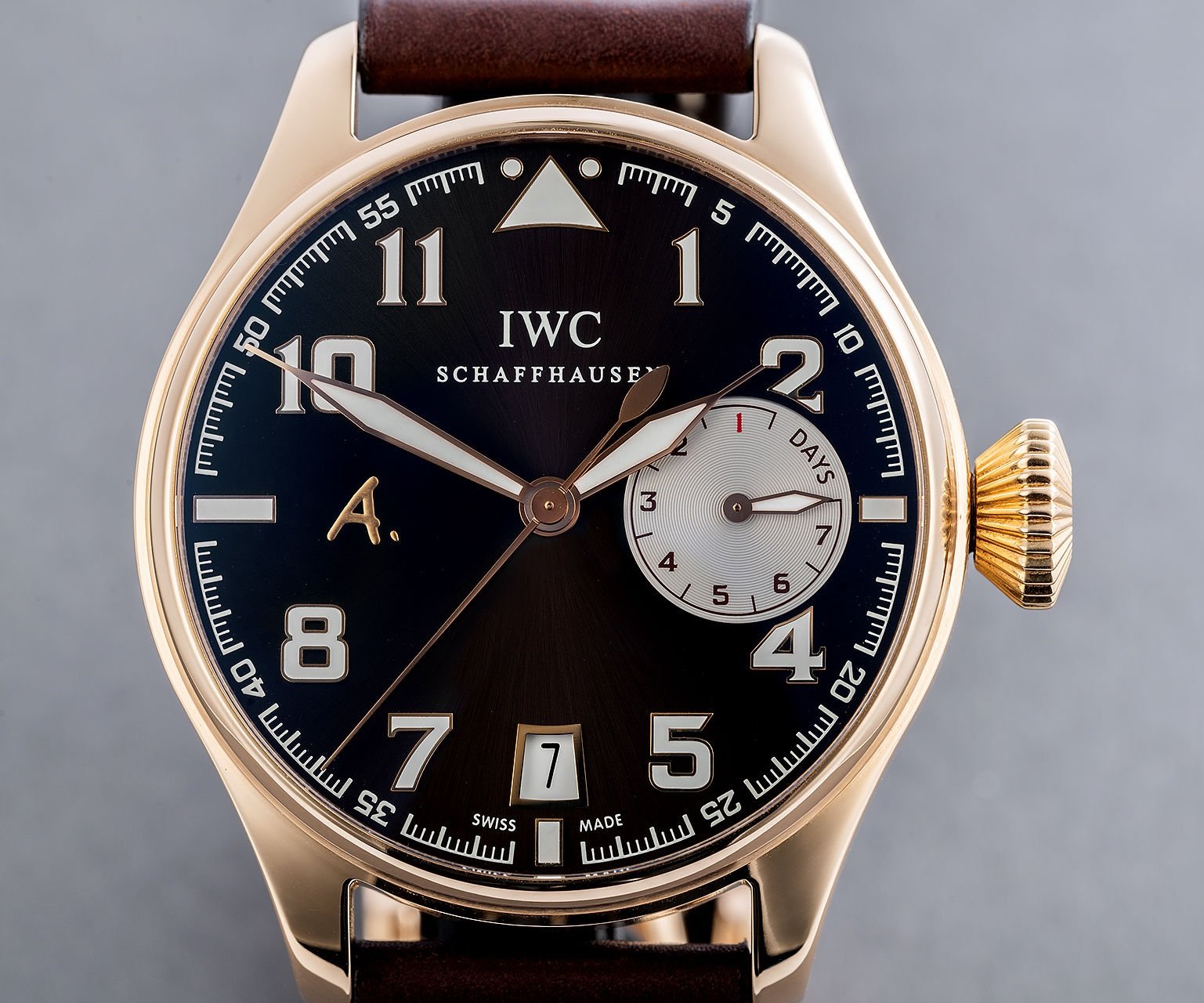

The collaboration began in 2009 with a memorable trio of Big Pilot’s Watches, in white gold (IW500420, 250 pieces), red gold (IW500421, 500 pieces), and stainless steel (IW500422, 1,149 pieces). All three featured elegant tobacco sunray dials and numerals, similar to those on the 1936 IWC “Special Watch for Pilots” Calibre 83, including a charming detail: the letter “A.” subtly placed next to the 9 o’clock marker, a tribute to Antoine himself.
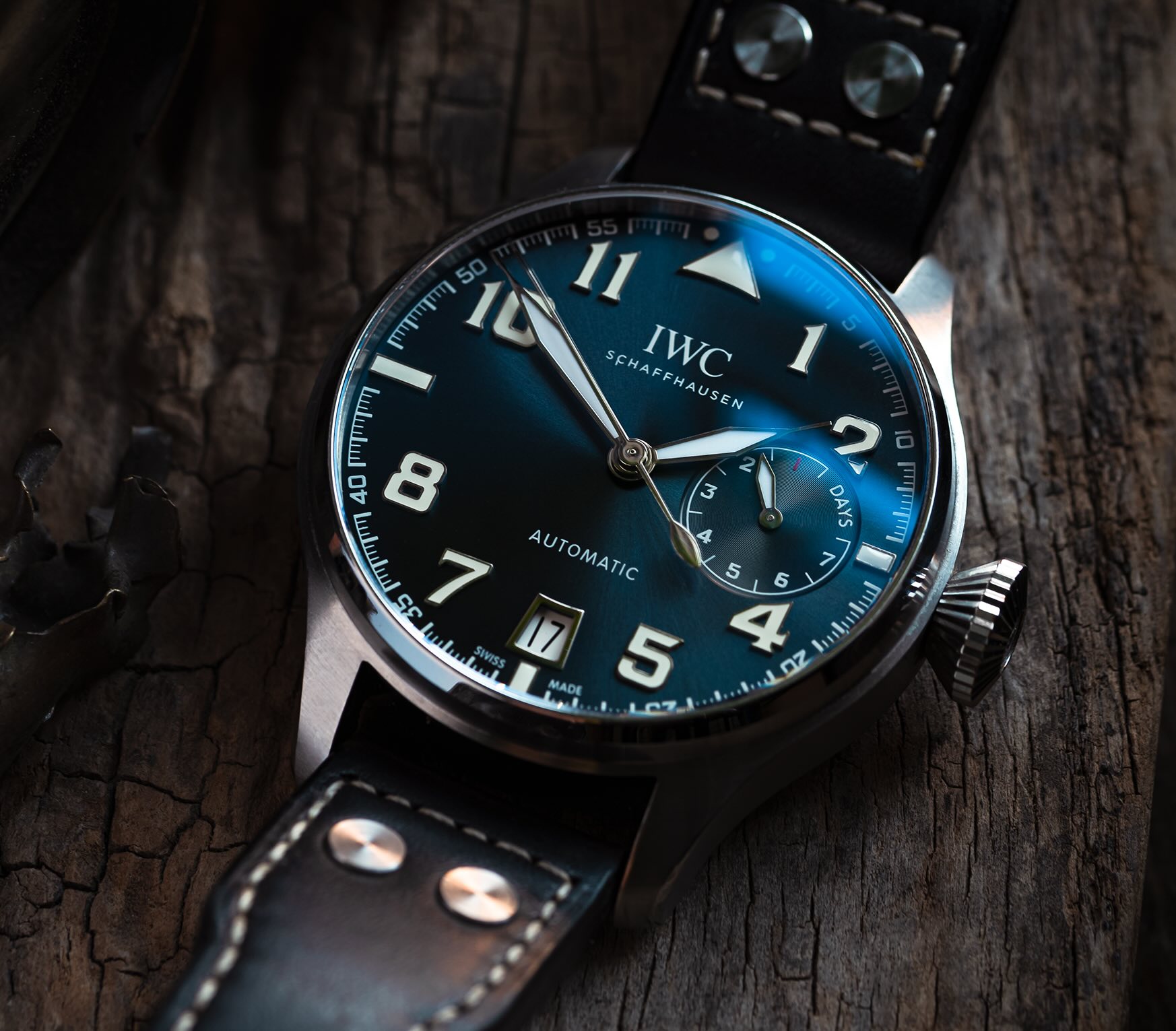

The cooperation also led to IWC Le Petit Prince series, with the 5009-based steel (IW500908, 1000 pcs) and red gold (IW500909, 250 pcs) Big Pilot’s editions, both featuring midnight blue dials and with the same typeface for numerals as the AntExupéry Saint Exupéry watches which would become hallmark of the series, both released in 2014.
The most notable Special/Limited Big Pilot Watches
Among the standout Big Pilot’s limited editions is the 2015 Patrouille Suisse (IW500910, 250 pieces). Housed in a sandblasted steel case with a grey slate dial, it features a small seconds at 9 o’clock, thanks to the IWC calibre 51011. Best known as the power source of the Portugieser Automatic 5001, this movement first appeared in the Big Pilot’s Watch within a few of the 5004 limited series. But the Patrouille Suisse marked the first time IWC paired this design with an aviation theme, created to honour the official aerobatic team of the Swiss Army.
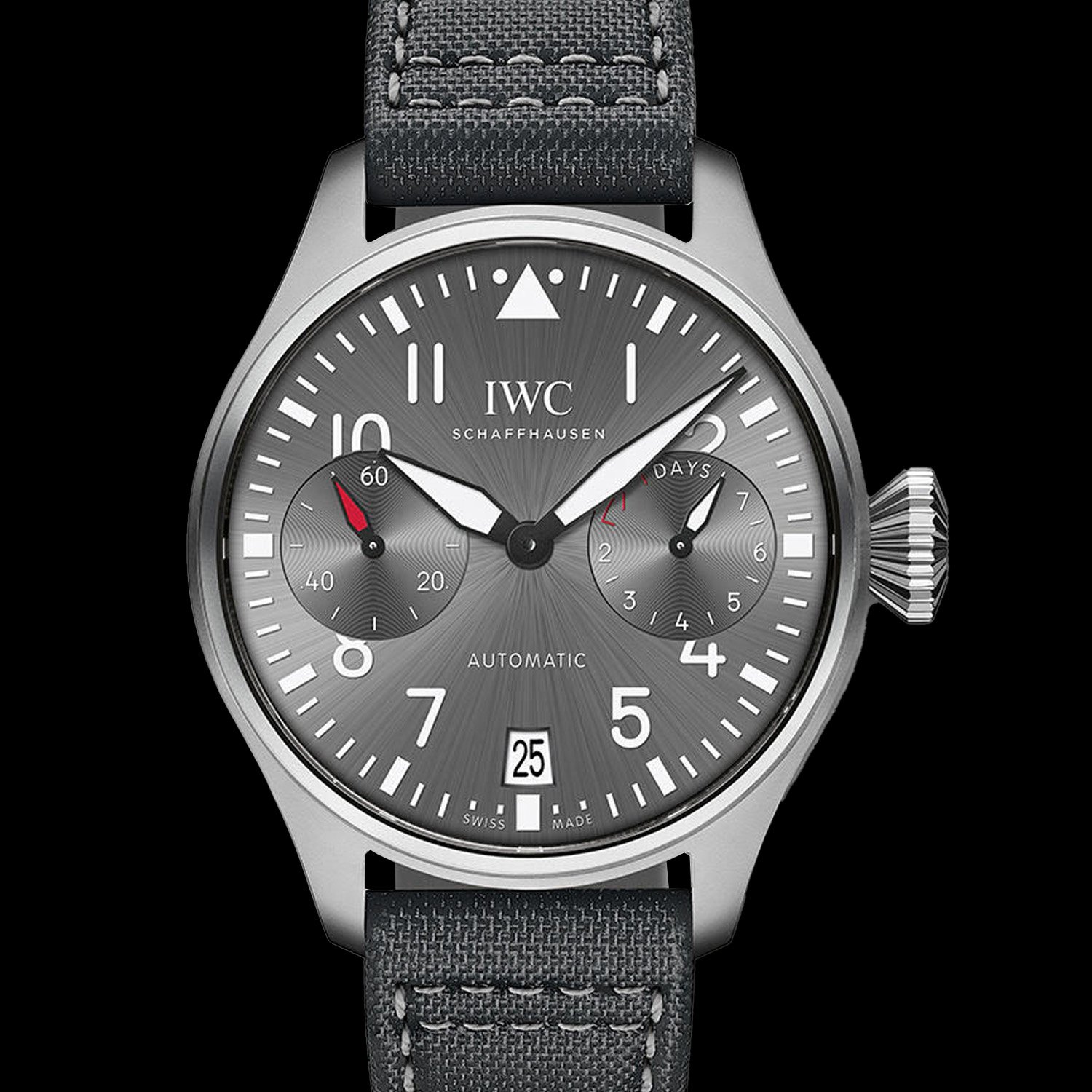

The 2016 Big Pilot’s Heritage 48 (IW510301, 100 pcs) and the Heritage 55 (IW510401, 100 pcs) in 48mm and 55mm titanium cases, powered by the in-house calibre 59215 and 98300, respectively, became the first hand‐wound Big Pilots since the IW500301 Bühler. Both featured black dials with a sub-seconds at 6 o’clock reminiscent of IWC’s Reference 436 from 1936, the Mark IX.
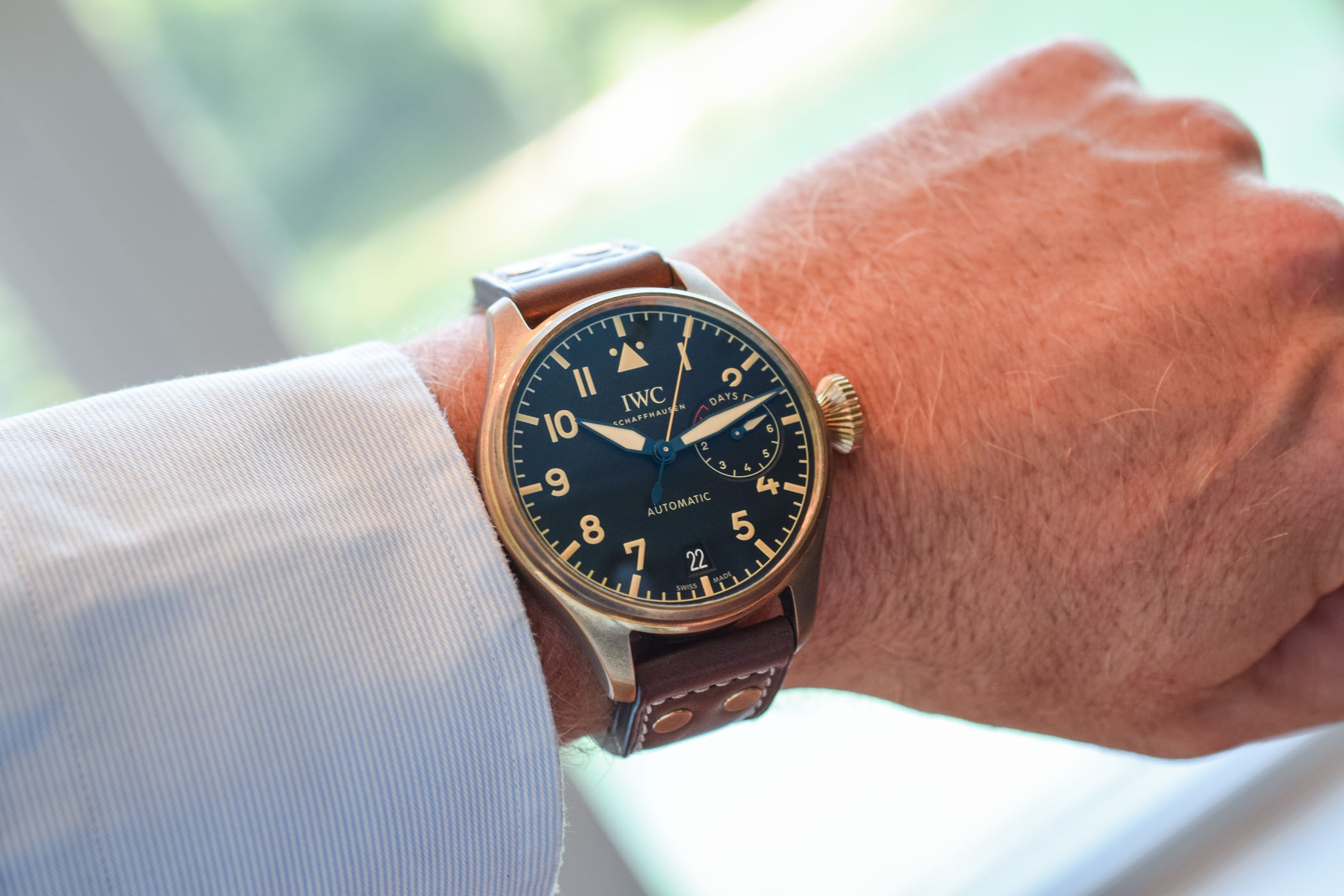

The 2017 Heritage Titanium IW501004 and Bronze IW501005 editions are worth mentioning as they were the first to employ the calibre 52110 with ceramic components and two barrels for the 7-day power reserve, ahead of its appearance in the new steel IW501001 reference. Both editions featured black dials with blued hands and faux-vintage lume for the indices and hands.
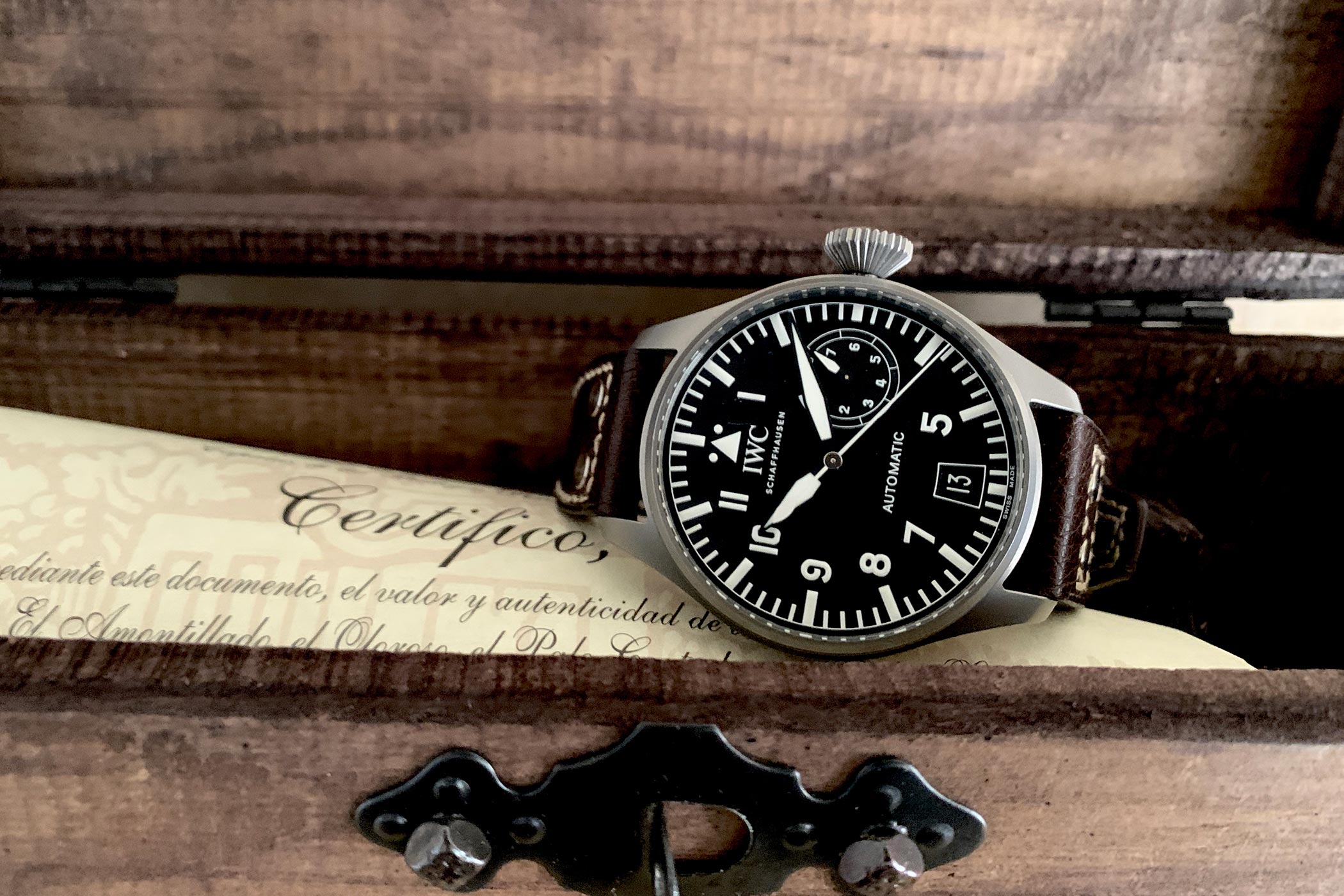

The 2018 Tribute to 5002 Safari (IW501007) began as a one-off piece created for IWC CEO Christopher Grainger-Herr, spotted on his wrist during a safari in South Africa. Enthusiasts showed so much interest that the brand decided to produce a limited run of 100 watches. Visually, it closely echoes the original 5002, but with a few updates: the hour and minute hands from the 5004/5009, a matte titanium case, and a date window with white numerals on a black background framed by a white outline. Staying true to the spirit of the original, it also features the iconic “fish crown” rather than the Probus Scafusia design.
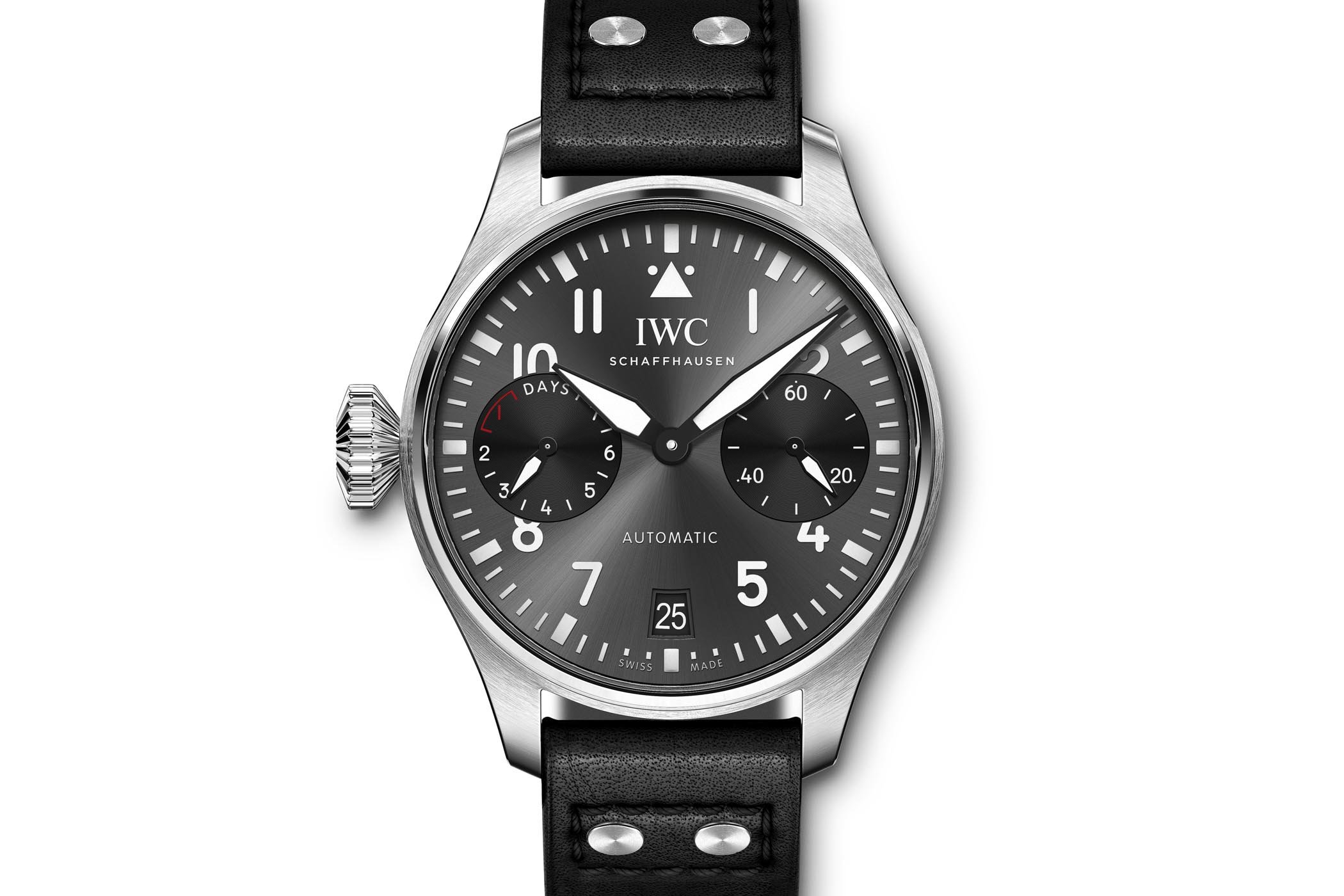

In 2019, IWC released 250 pieces of the IW501012, a special Big Pilot’s designed for right-handed wearers, with the crown flipped to 9 o’clock. Housed in stainless steel and powered by the calibre 50210, it sports a black dial with small seconds at 3 o’clock and a power reserve opposite.
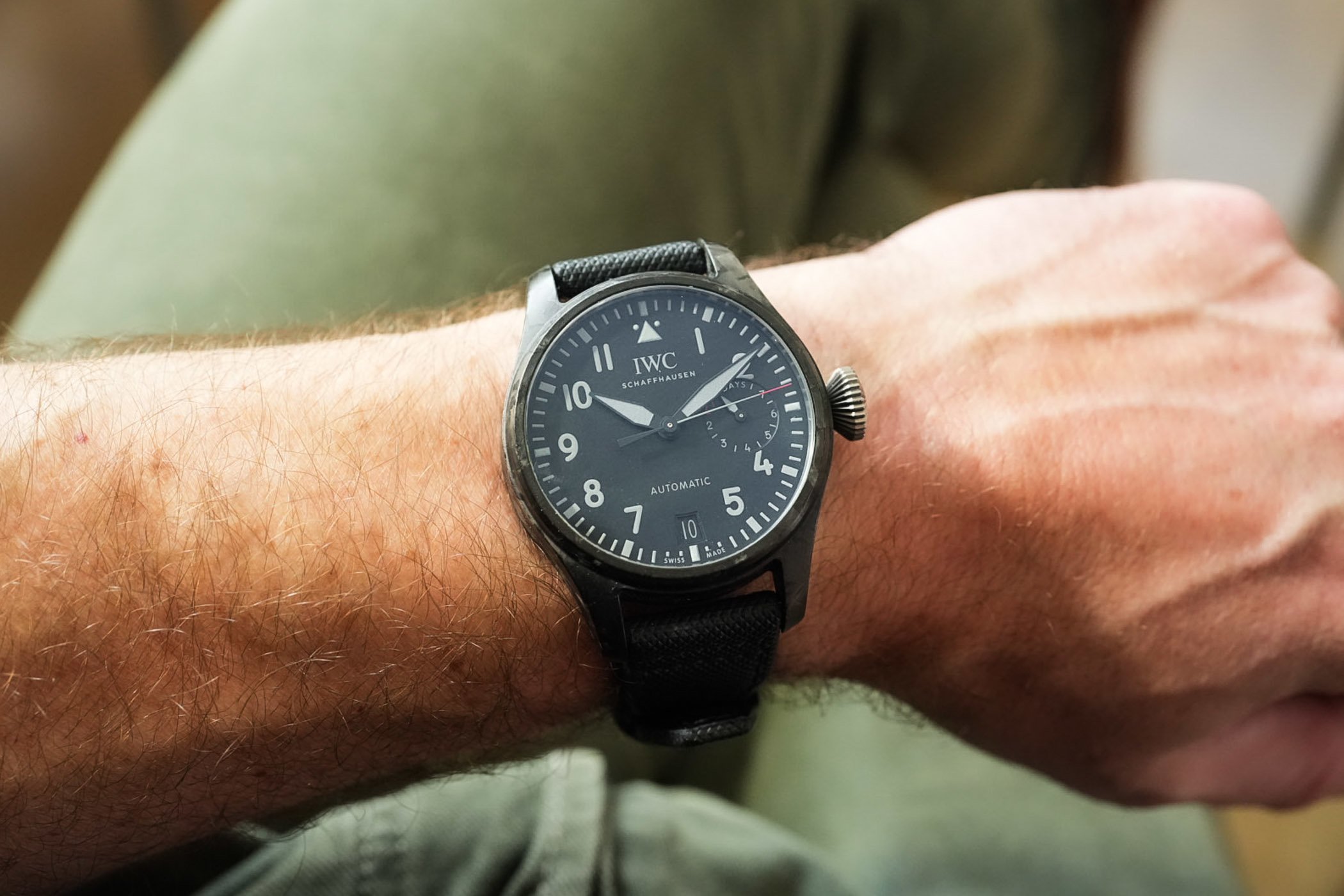

A year later, IWC broke new ground with the IW506101, the first Big Pilot’s in a carbon composite case. Limited to 100, it featured dear to enthusiasts’ “fish” crown. The project evolved through turbulent times and is said to have been initially conceived in 2018 as a Hong Kong Edition during a design workshop with IWC’s top 14 local collectors. To honour their role, 14 watches from the production run, marked by a red “10” on the date disc, went to those who initially helped shape the idea.
The TOP GUN Collection
While countless boutique and other specific editions have showcased the Big Pilot’s remarkable versatility in colours and materials, it’s the aviation-themed models that truly stand out, especially the Top Gun line.
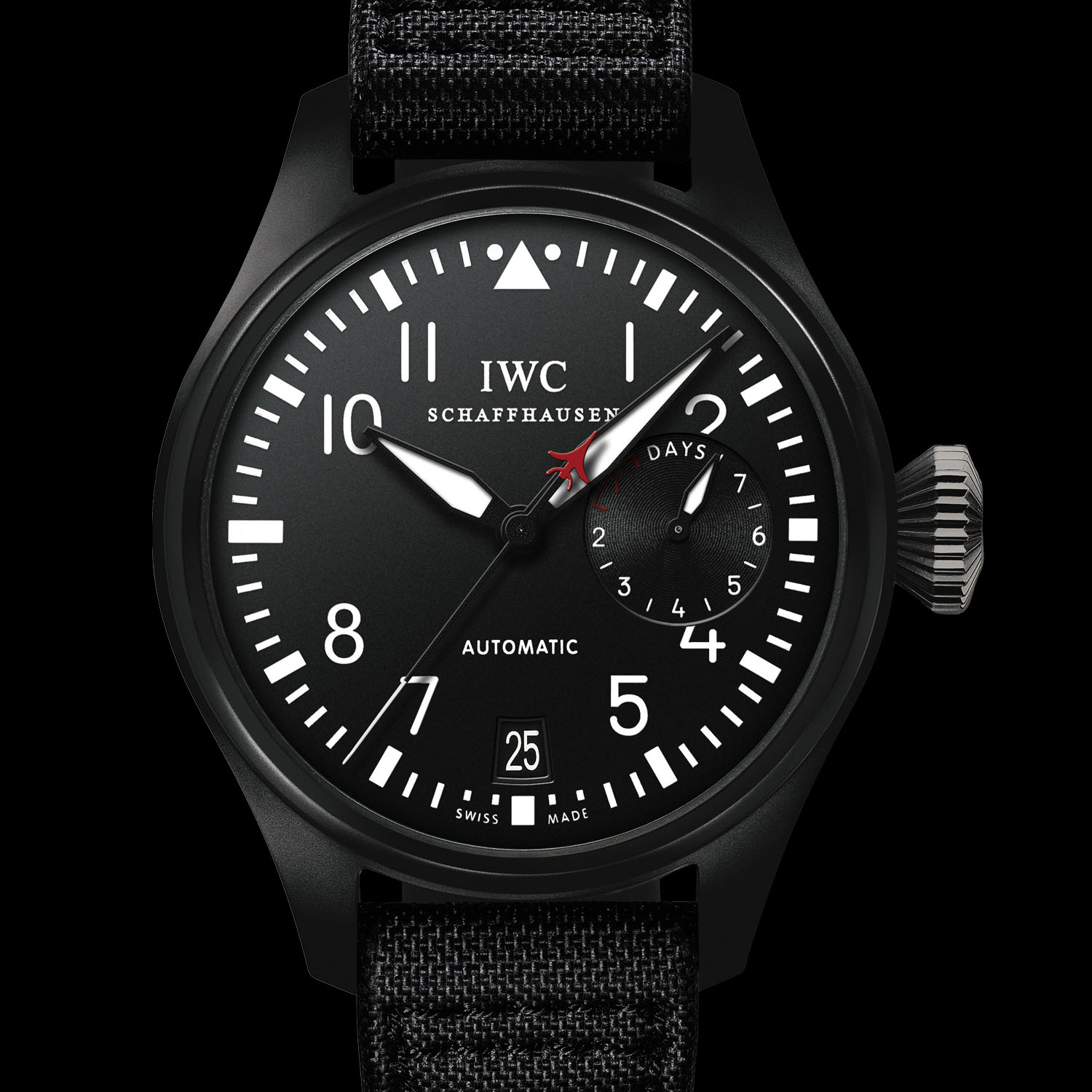

This part of the IWC story began in 2007 with the Pilot’s Watch Double Chronograph Top Gun, Ref. IW3699, to evolve into a full Top Gun sub-series spanning various Pilot’s Watches, including the Big Pilot’s, since 2012. The Ref. IW501901, housed in a 48mm x 16mm black ceramic case with a titanium crown, remained true to the classic Big Pilot’s 500901 design but added a fighter jet-shaped red counterweight on the central seconds hand and a Top Gun emblem on the caseback.
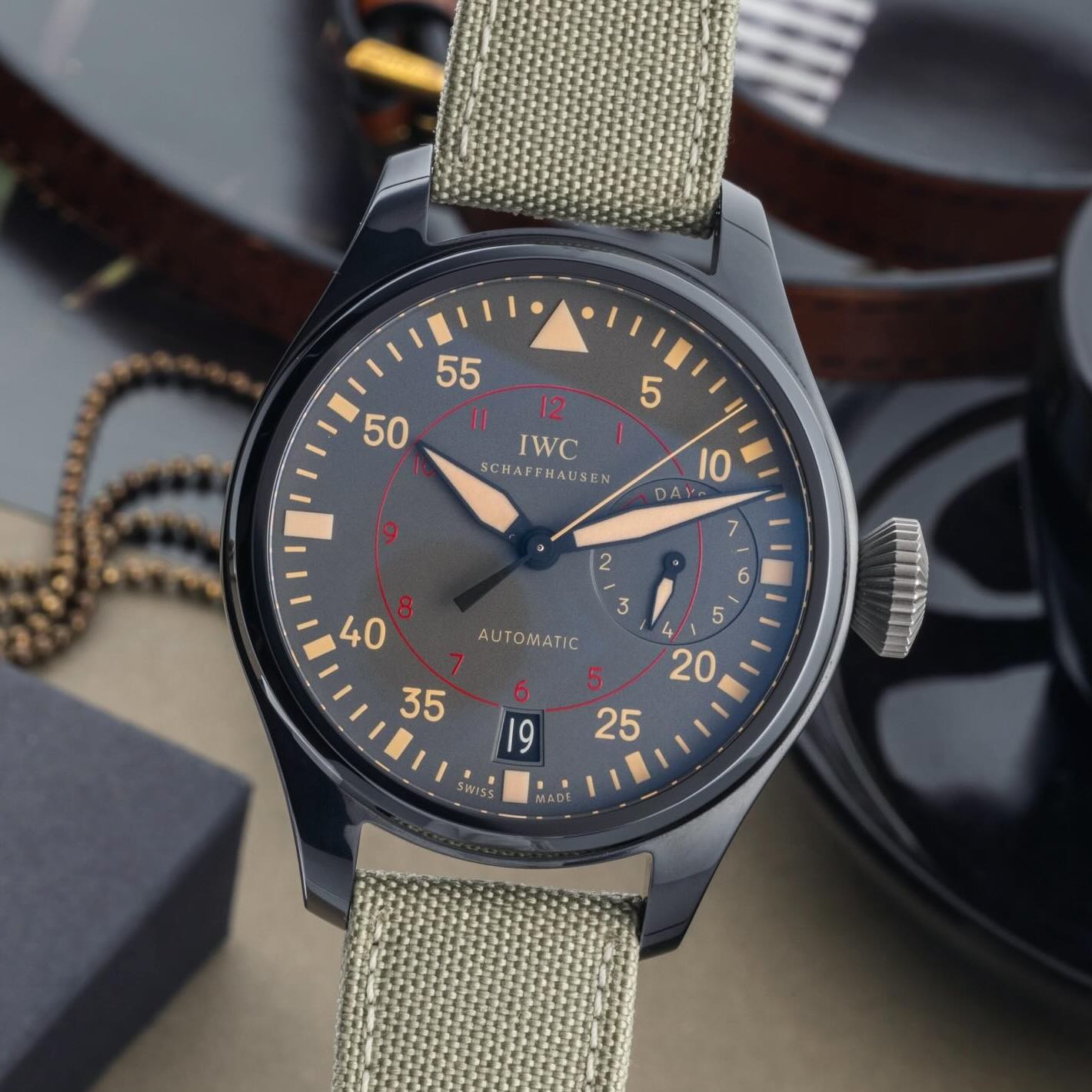

That same year, IWC launched the IW501902 Big Pilot’s Watch Top Gun Miramar, also using the 51111 calibre but dressed in grey ceramic. Sharing the same bold dimensions, it introduced a distinctive matte grey dial inspired by the B-Uhr Type B layout, with luminous markers and a separate hour ring in red, retaining the power reserve indication at 3 o’clock.
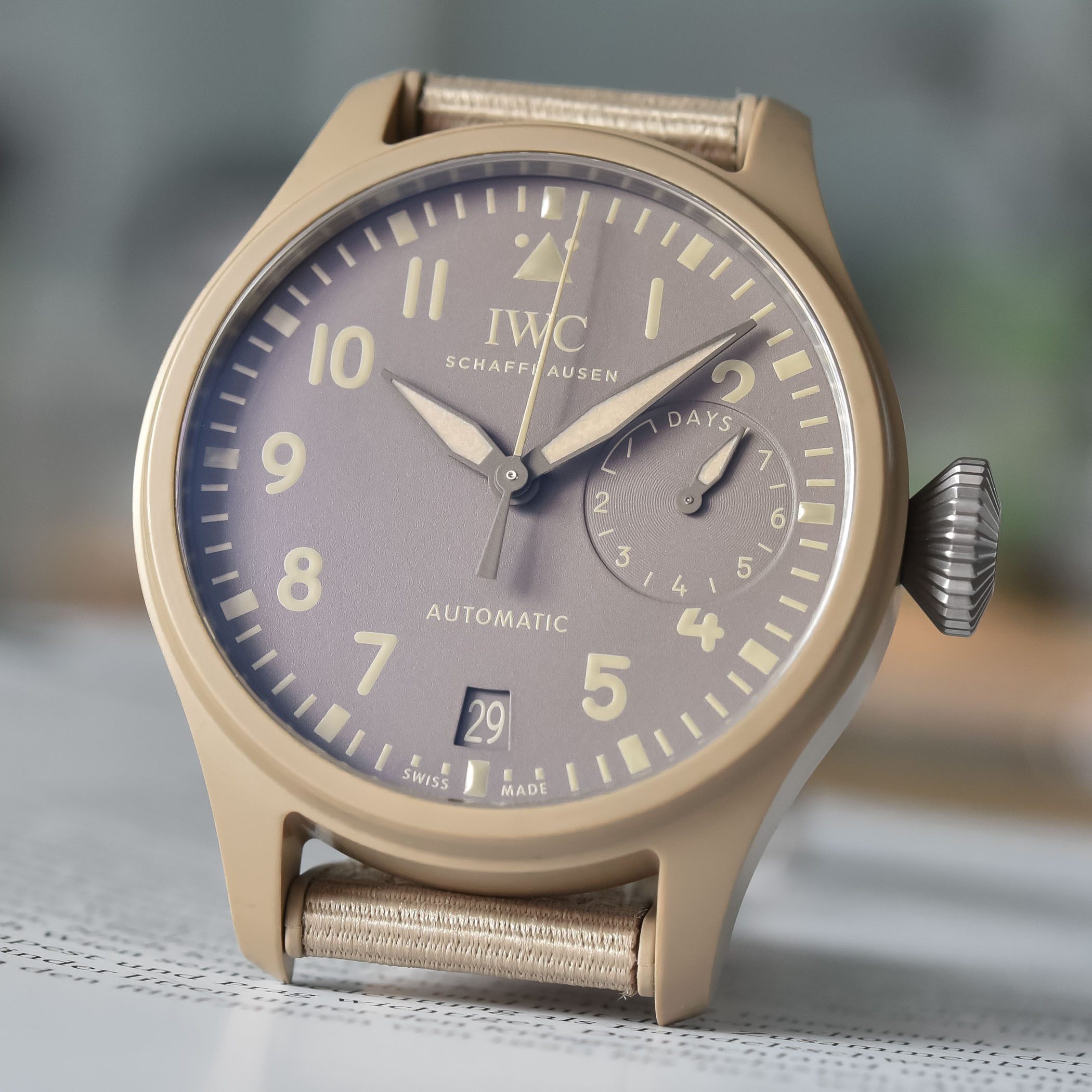

In 2021, after a few more Big Pilot’s Top Gun editions, IWC unveiled the Top Gun Mojave Desert, a limited-production model crafted in sand-coloured ceramic, echoing Navy pilots’ flight suits and the arid landscape surrounding the Naval Air Weapons Station China Lake.
The Big Pilot Watches with Complications
By 2006, the Big Pilot’s Watch collection was still in its early stages, just four years after the launch of the original 5002, when the first complication beyond the signature power reserve entered the line: the perpetual calendar.
The Big Pilot Perpetual Calendar
The first Big Pilot’s Perpetual Calendar was the Ref. IW502605, a platinum edition made exclusively for Sincere Watch in Singapore, limited to 25 pieces. This inaugural model paved the way for what would become one of the most iconic combinations in the series, followed by special boutique editions, Saint-Exupéry and Le Petit Prince tributes, and later the Top Gun Perpetuals. Future models mostly vary in materials, dial colours, and engraved details but stick closely to the distinctive four-register layout, with variations in the underlying movement and moon phase display.
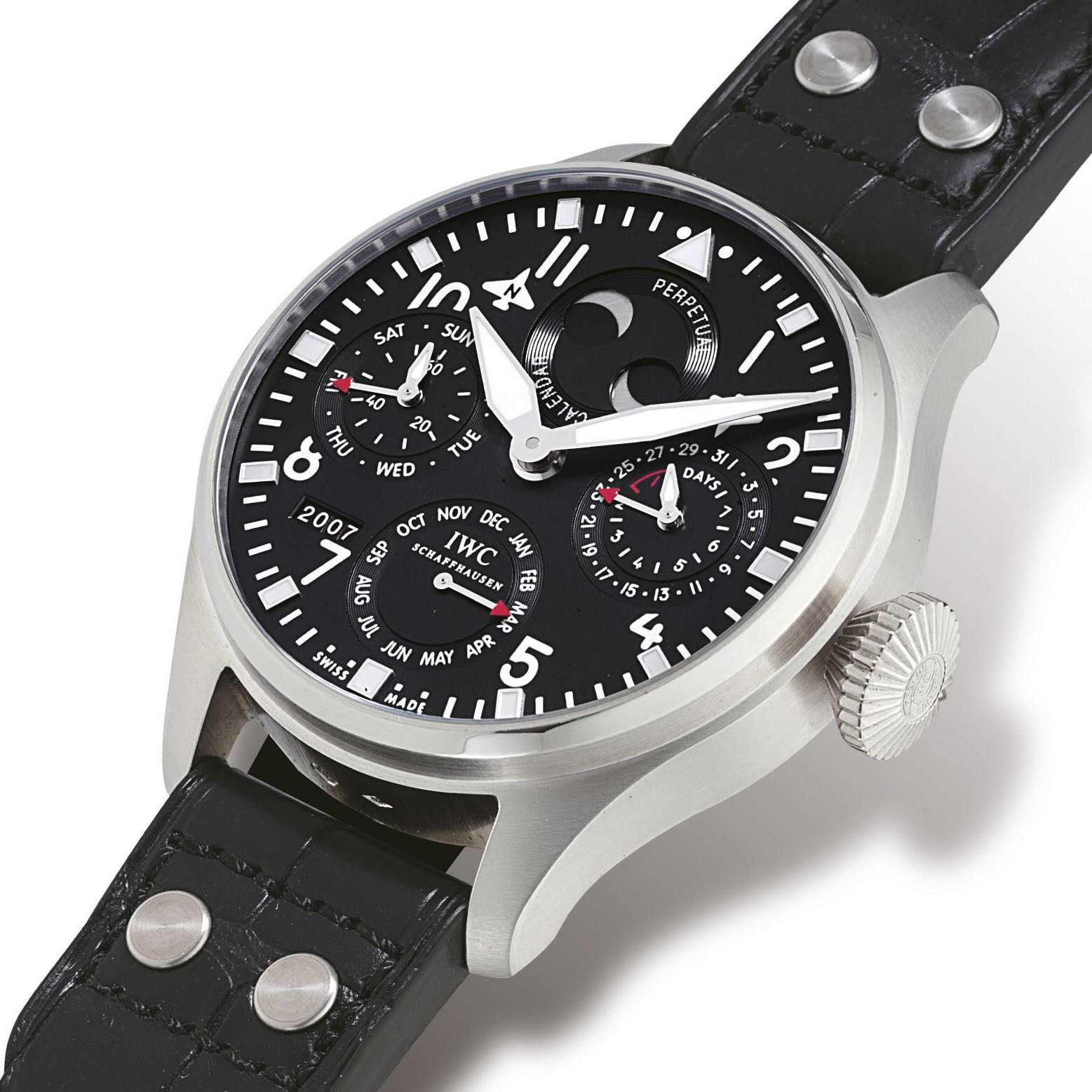

True to IWC tradition, the Big Pilot QP used the perpetual calendar module developed by Kurt Klaus in the mid-1980s, an ingenious, user-friendly system that found a perfect home in the generously sized Big Pilot. The dial space allowed for the spread of the indications: a double moon phase at 12 o’clock, showing both northern and southern hemispheres (marked with flanking small aircraft silhouettes), date and integrated power reserve at 3 o’clock, month at 6 o’clock, and day with small seconds at 9 o’clock. The four-digit year display sat neatly between 7 and 8 o’clock, rounding out the complete perpetual calendar.
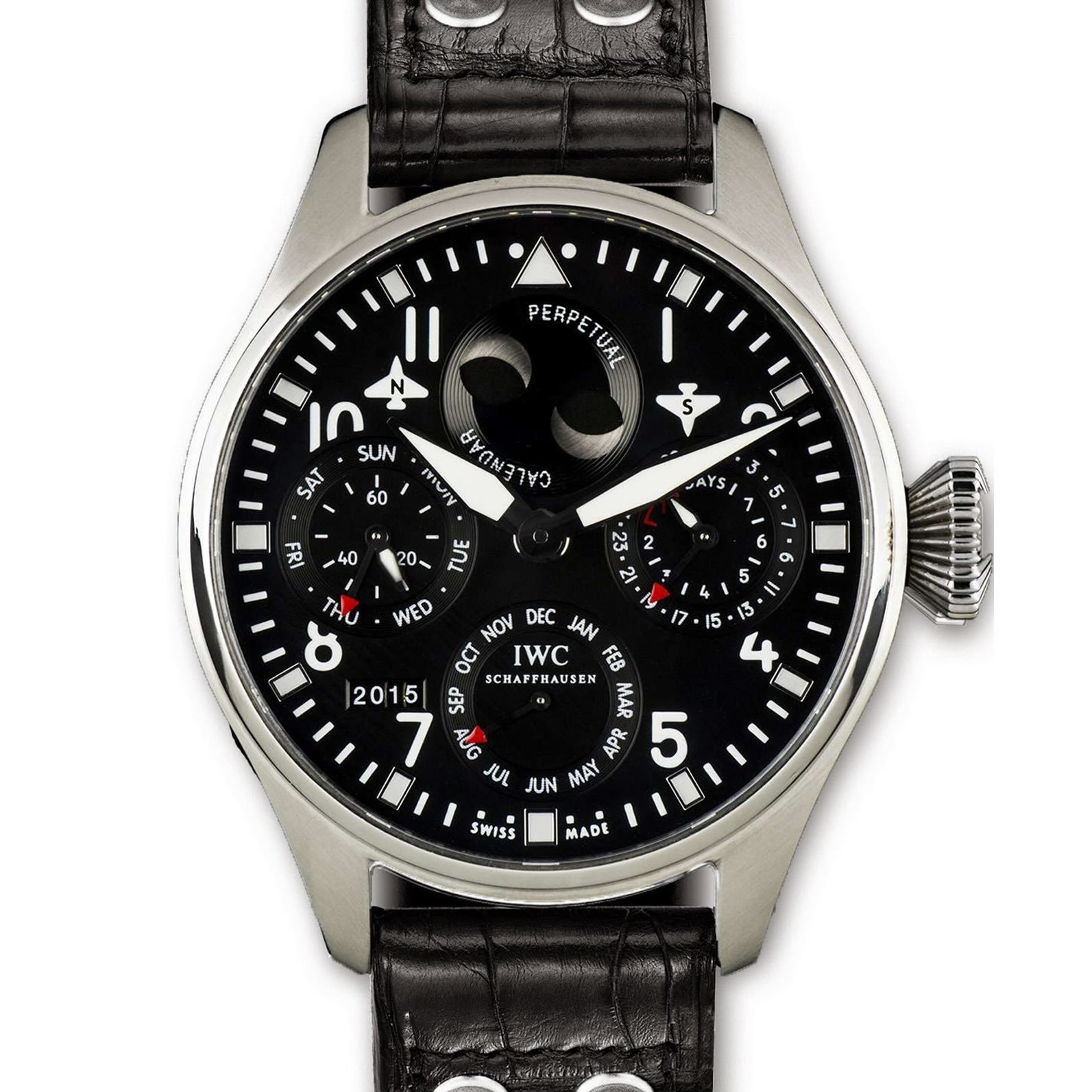

While the practicality of a perpetual calendar in a tool watch is sometimes debated, the execution looked so striking and balanced on the Big Pilot’s expansive dial that it quickly became a fan-favourite complication, making the Big Pilot’s Perpetual an important part of IWC’s modern collection.
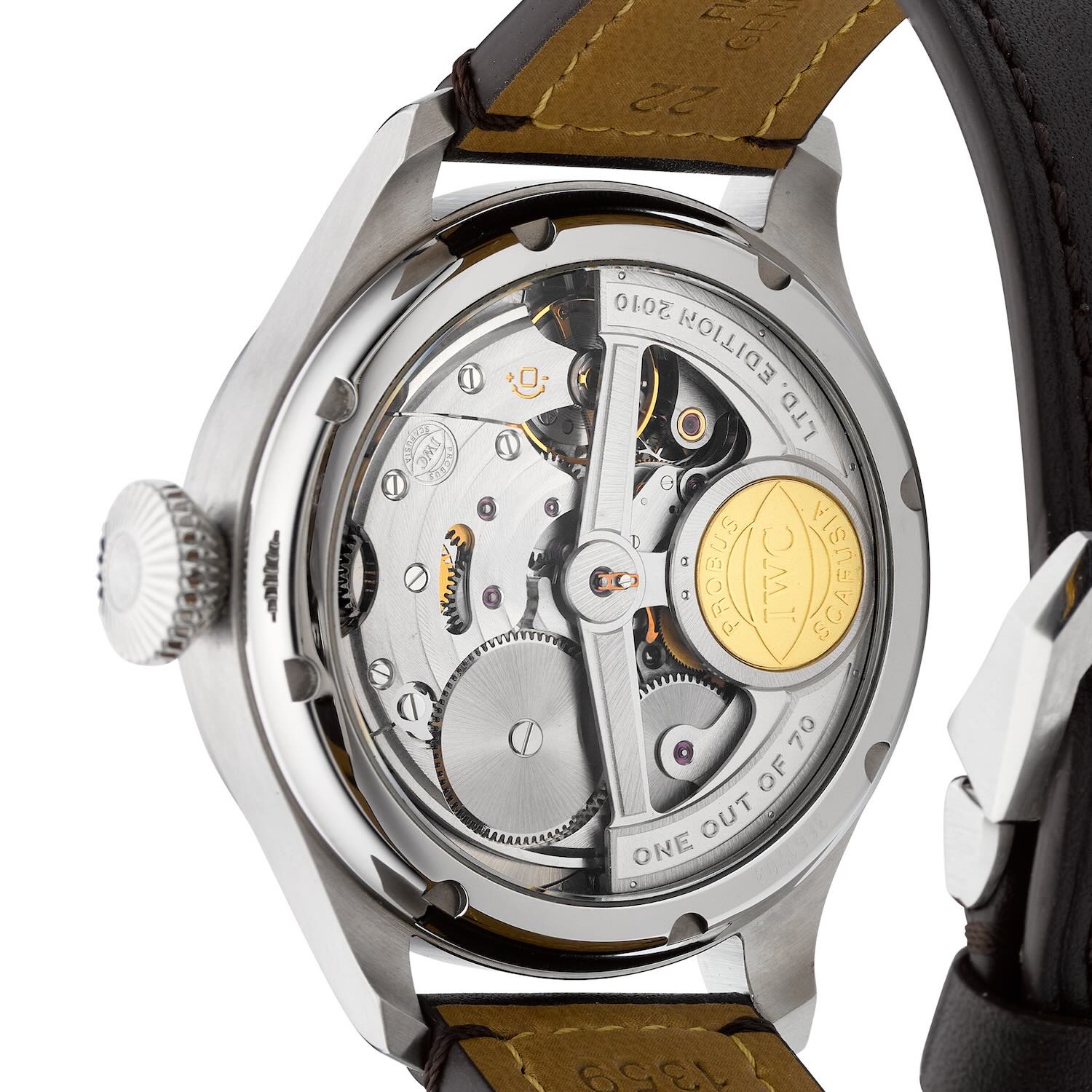

For its movement, the Sincere Perpetual used the IWC Calibre 51612, part of the 51000 series base, which runs at 21,600 vibrations/hour and offers a seven-day power reserve from a single barrel, topped with a perpetual calendar module. Beginning in 2007, this movement was succeeded by the Calibre 51614 in similar Big Pilot’s models, maintaining the same technical specifications. Reportedly, some Sincere Perpetuals were equipped with the 51614, as the production spanned two years.
The Calibre 51613, meanwhile, offered a classic single moon phase display. One of its most memorable applications was in the unique 2013 Le Petit Prince Perpetual Calendar (IW502801), a platinum piece with a deep blue dial, depicting the Little Prince as Antoine de Saint-Exupéry imagined himself.
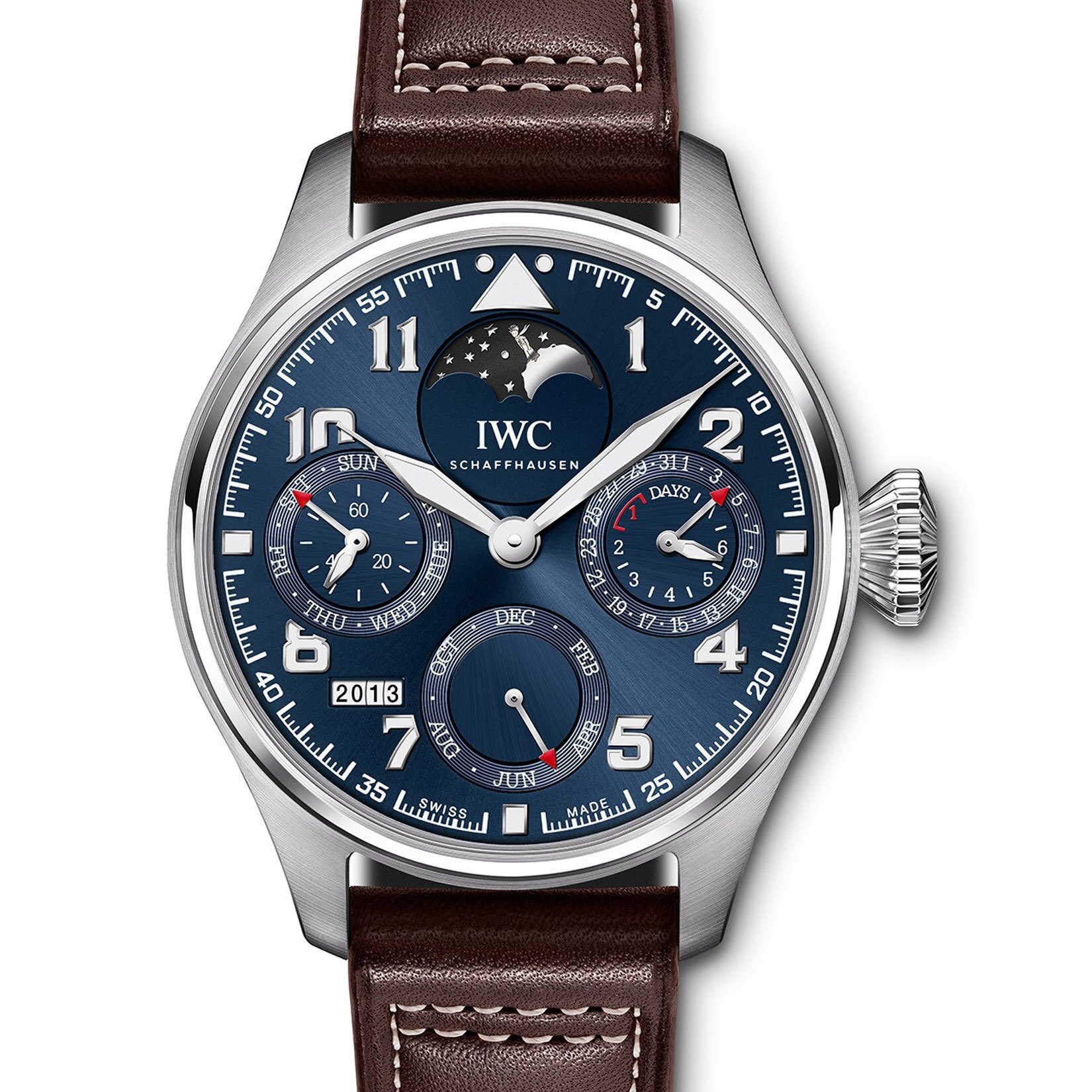

An earlier highlight was the 2011 Big Pilot’s Watch AntExupéry Saint Exupéry Perpetual Calendar (IW502617), limited to 500 pieces in red gold. This striking edition featured distinctive numerals and a double moon phase display flanked by images of the Lockheed F-5B Lightning, a reconnaissance version of the P-38 aircraft flown by Saint-Exupéry.
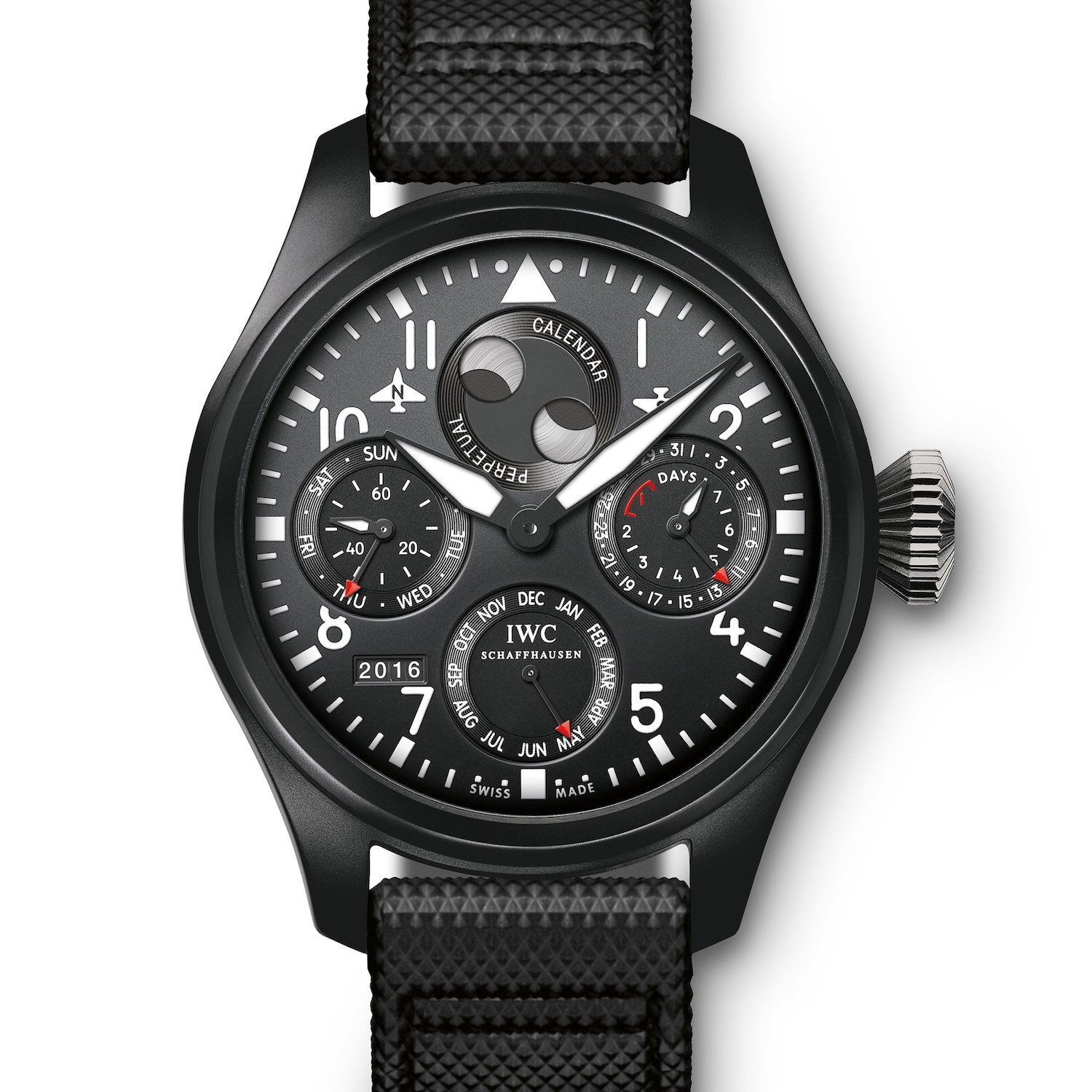

As the Top Gun line wouldn’t be complete without a Big Pilot’s Perpetual, in 2012, IWC introduced the non-limited Top Gun reference IW502902, powered by the Calibre 51614. Housed in a bold 48mm x 16mm black ceramic case with a titanium crown and caseback, it featured a matte black dial accented by crisp white markings and subtle touches of red on the small hands and power reserve indicator.
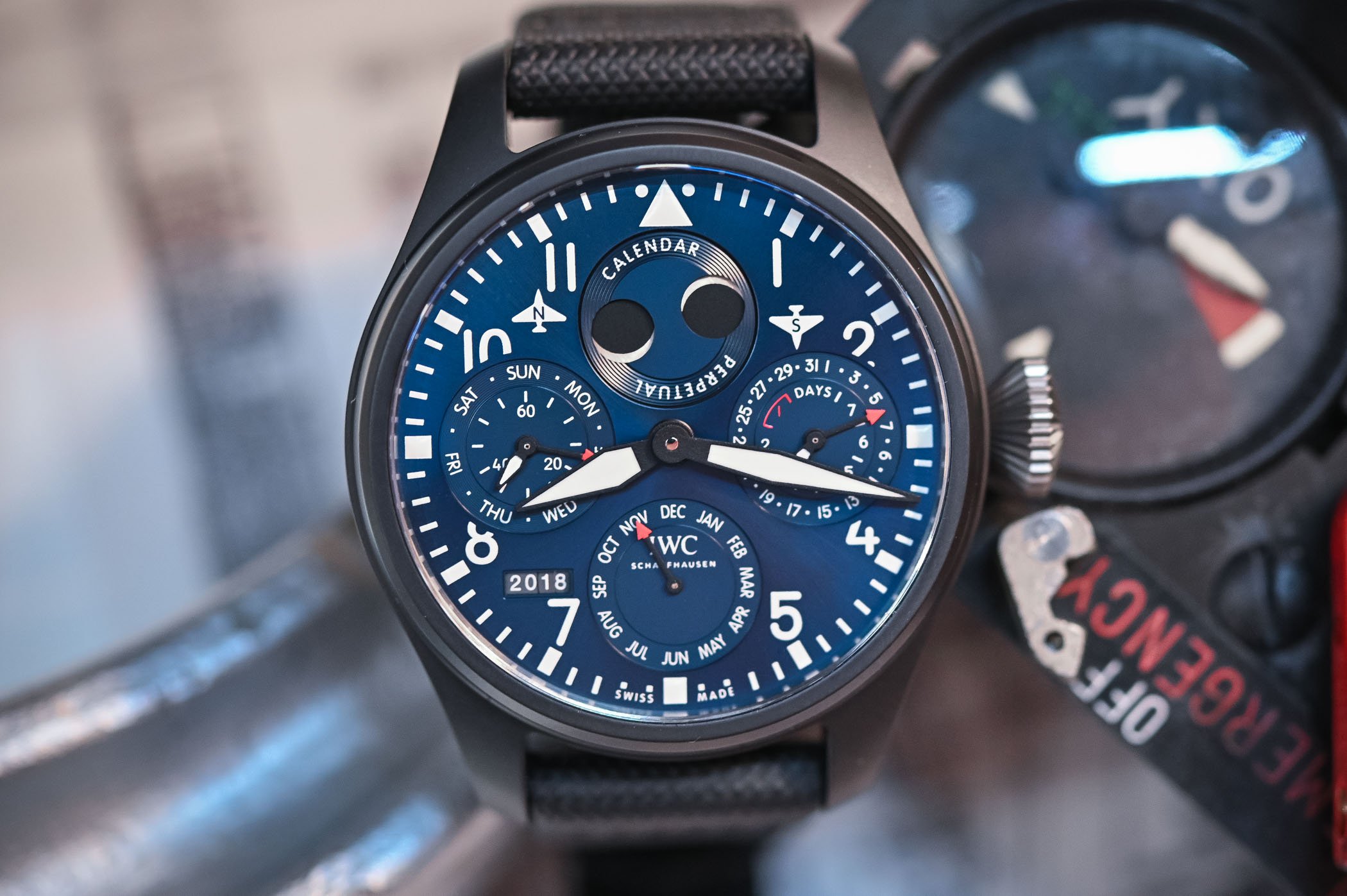

As mentioned earlier, IWC unveiled its next-generation 7-day automatic movements in 2015 with the Calibre 52000 family. These updated movements operated at a modern 28,800 vibrations/hour, incorporated an enhanced Pellaton winding system, and stored their generous power reserve across two barrels instead of one. Naturally, the perpetual calendar models transitioned to this new base movement. One of the first to showcase the updated Calibre 52615 was the 2019 Rodeo Drive Perpetual Calendar (IW503001), another non-limited but boutique-exclusive edition, featuring a 46.5mm x 15.8mm black ceramic case paired with a striking white-on-blue dial.
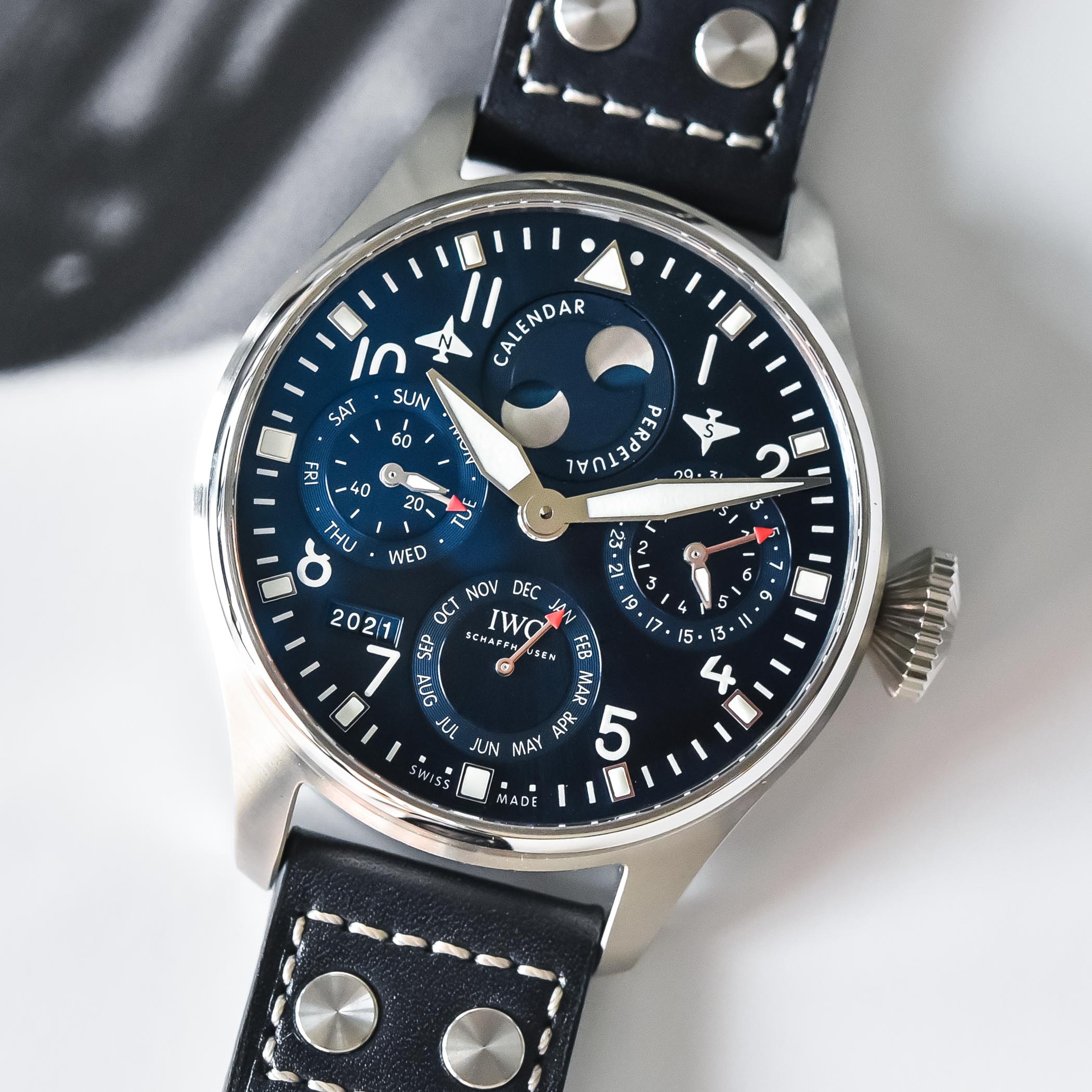

That same colourway returned in 2021 when IWC Schaffhausen introduced the Big Pilot’s Watch Perpetual Calendar IW503605 in stainless steel, adding it to the brand’s permanent collection. Alongside it came two Top Gun versions with limited annual production: Perpetual Calendar IW503604 in Ceratanium, a proprietary titanium-ceramic alloy offering lightweight durability and high scratch resistance, and the Mojave Desert Perpetual Calendar IW503004 in sand-coloured ceramic. All three models were powered by the Calibre 52615 and featured display casebacks to showcase the refined movement within.
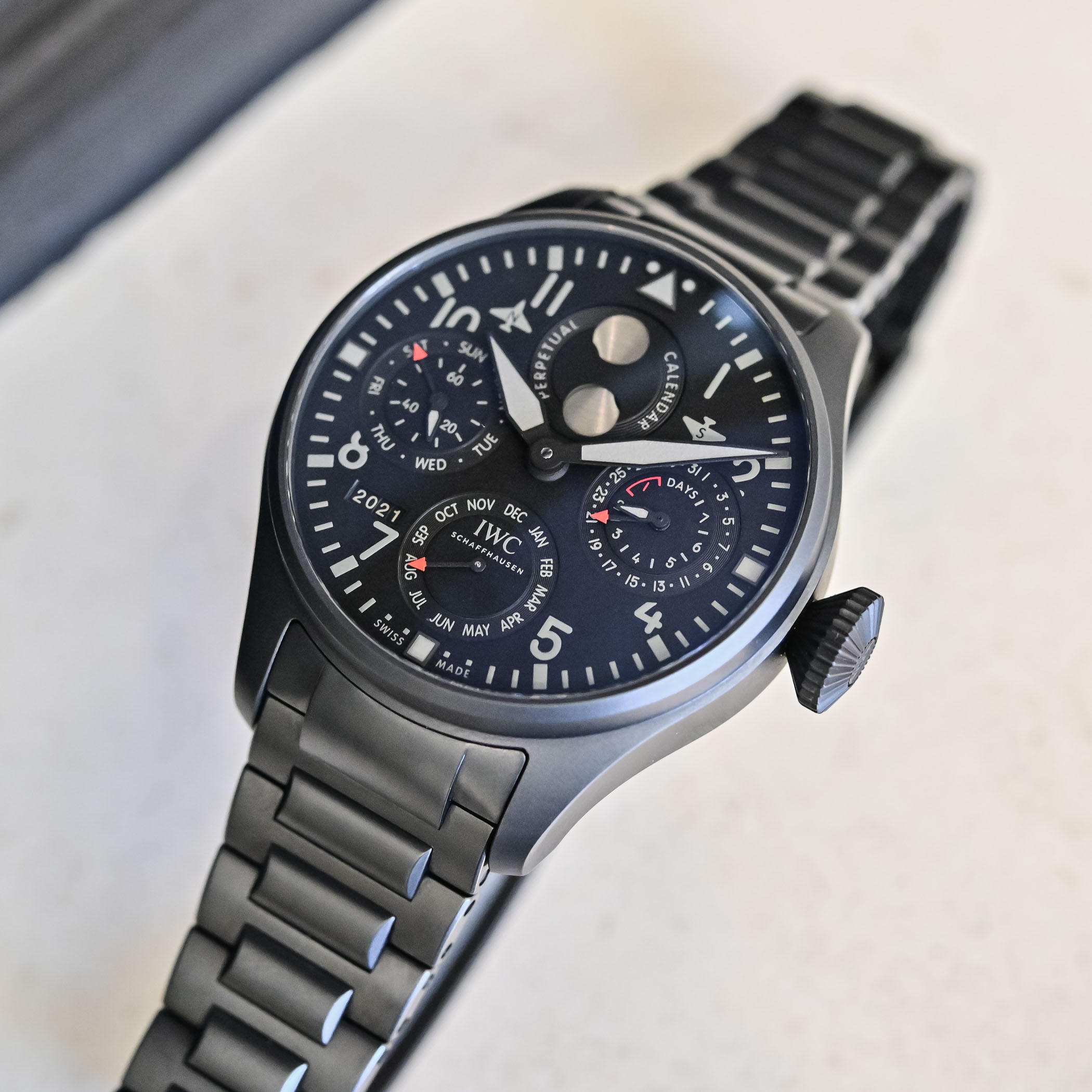

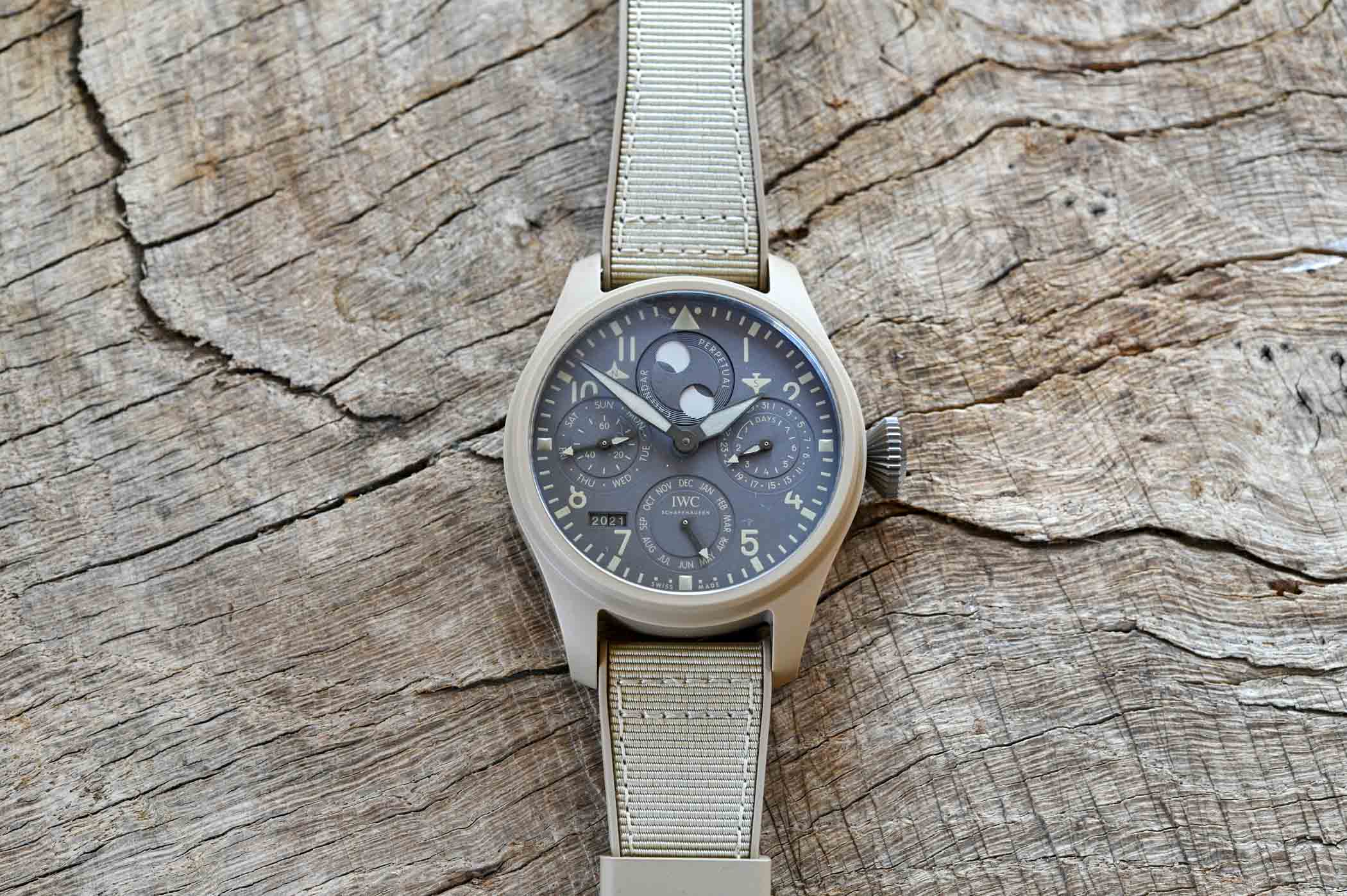

That same year, IWC also unveiled the Big Pilot’s Watch Perpetual Calendar Tourbillon Edition Le Petit Prince IW504803 (50 pcs), crafted in Armor Gold. It was powered by the slower-frequency Calibre 51950 and distinguished by a gold rotor depicting the Little Prince standing on his asteroid, a recurring poetic tribute to Antoine de Saint-Exupéry’s beloved character.
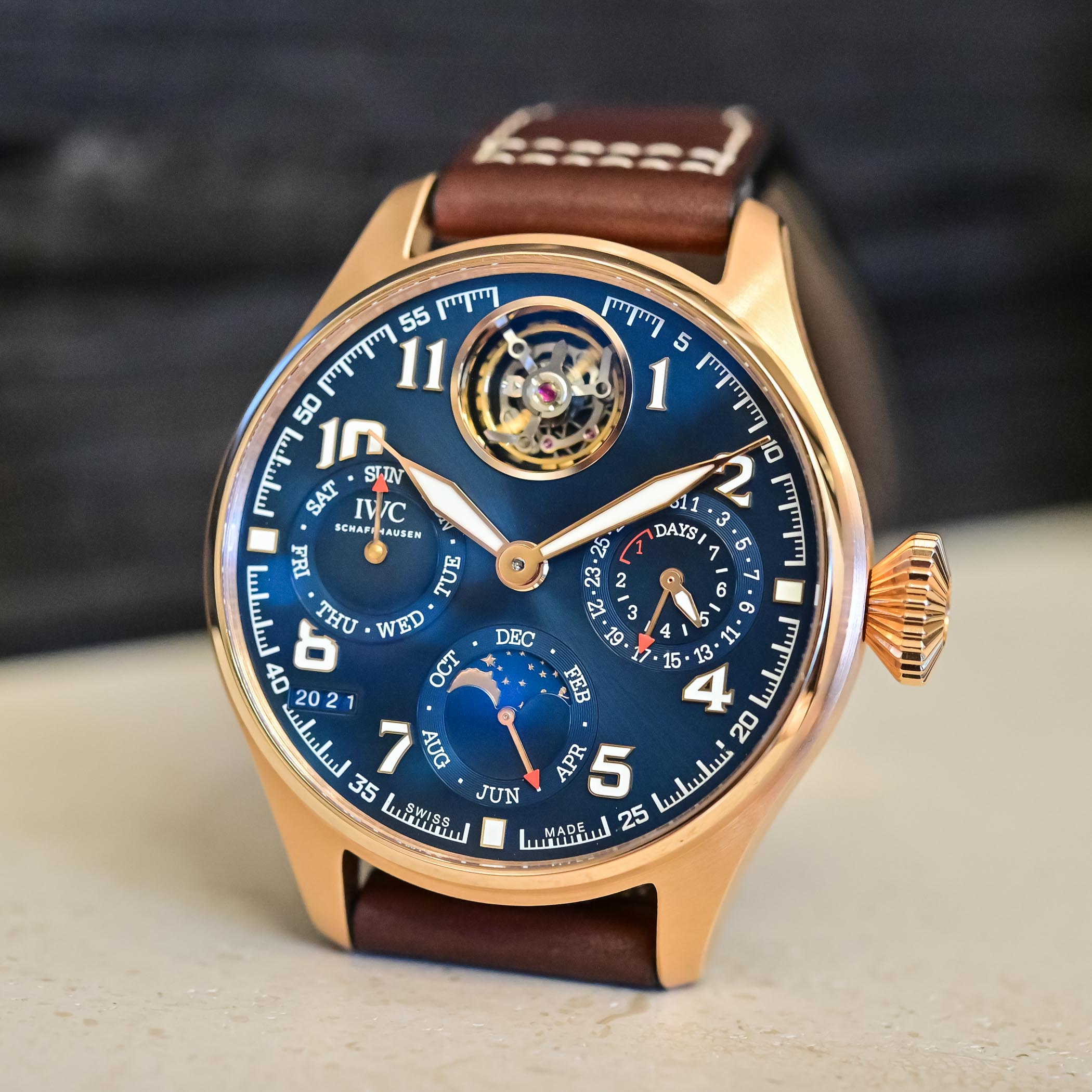

Since then, IWC has continued to expand the Big Pilot’s Perpetual line with striking new iterations, such as the IW503608 in stainless steel with a green dial, the Top Gun Lake Tahoe IW503008 in white ceramic, and the IW504901 Perpetual Calendar Tourbillon Le Petit Prince in blue ceramic, proving that, nearly two decades on, the Big Pilot’s Watch Perpetual Calendar remains as compelling as ever, blending timeless design, fresh aesthetics, and the robust engineering that defines IWC.
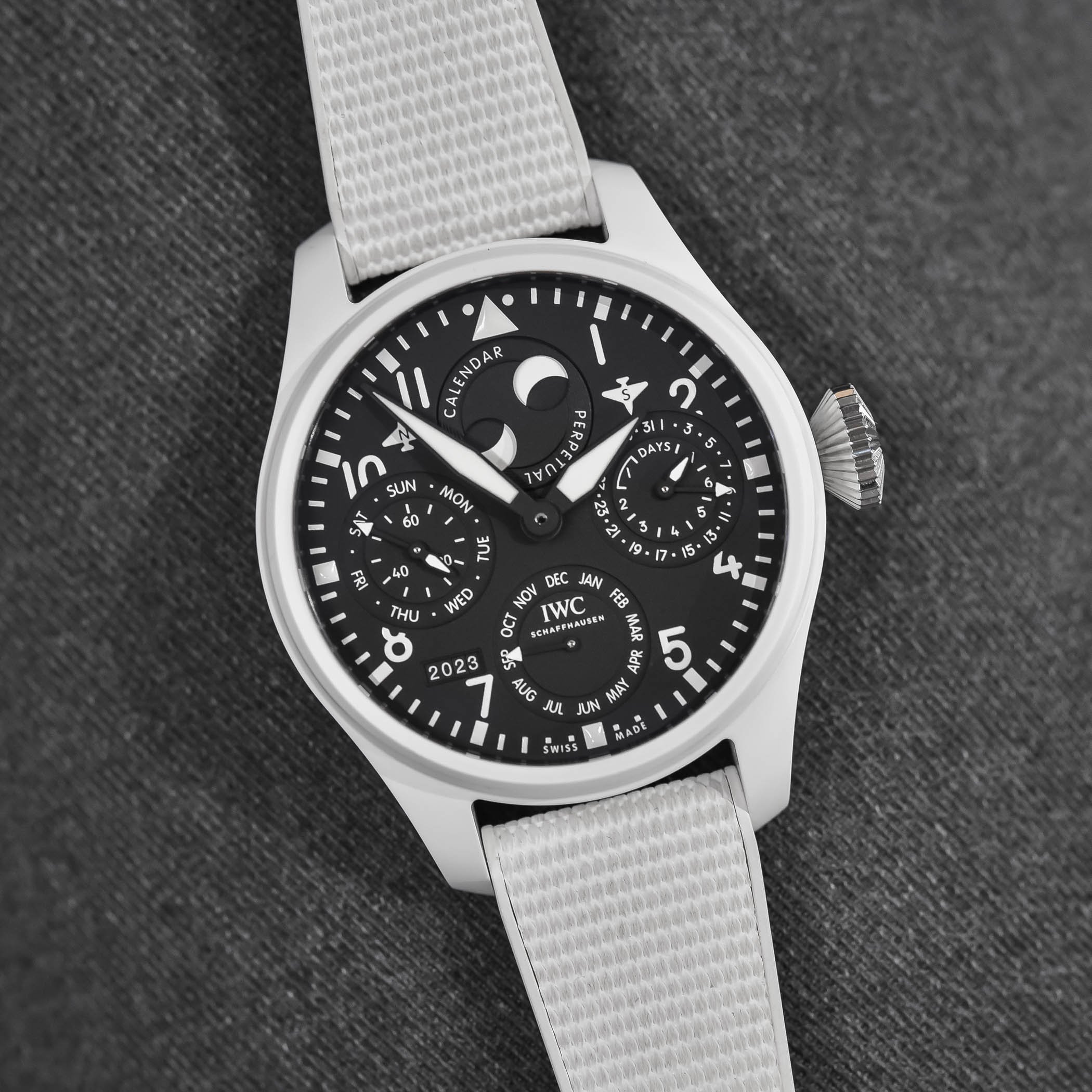

Big Pilot’s Watch Annual Calendar
In 2015, after five years of development, IWC presented an annual calendar movement within the Portuguiser collection. Since 2016, the brand has integrated the same calibre 52850 in various limited editions of the Big Pilot’s Watch series in gold and in steel, such as Le Petit Prince, Spitfire or Antoine de Saint-Exupéry, with the commemorative 150th anniversary model in 2018, mostly limited editions. The first watch in the Big Pilot’s collection to feature the Annual Calendar was Le Petit Prince ref. IW502701 (2016, 250 pcs) in red gold, and it showed how well IWC has overcome the challenge to maintain the strict design codes that have defined the Big Pilot’s lineage while adding a complication known for its visual presence.
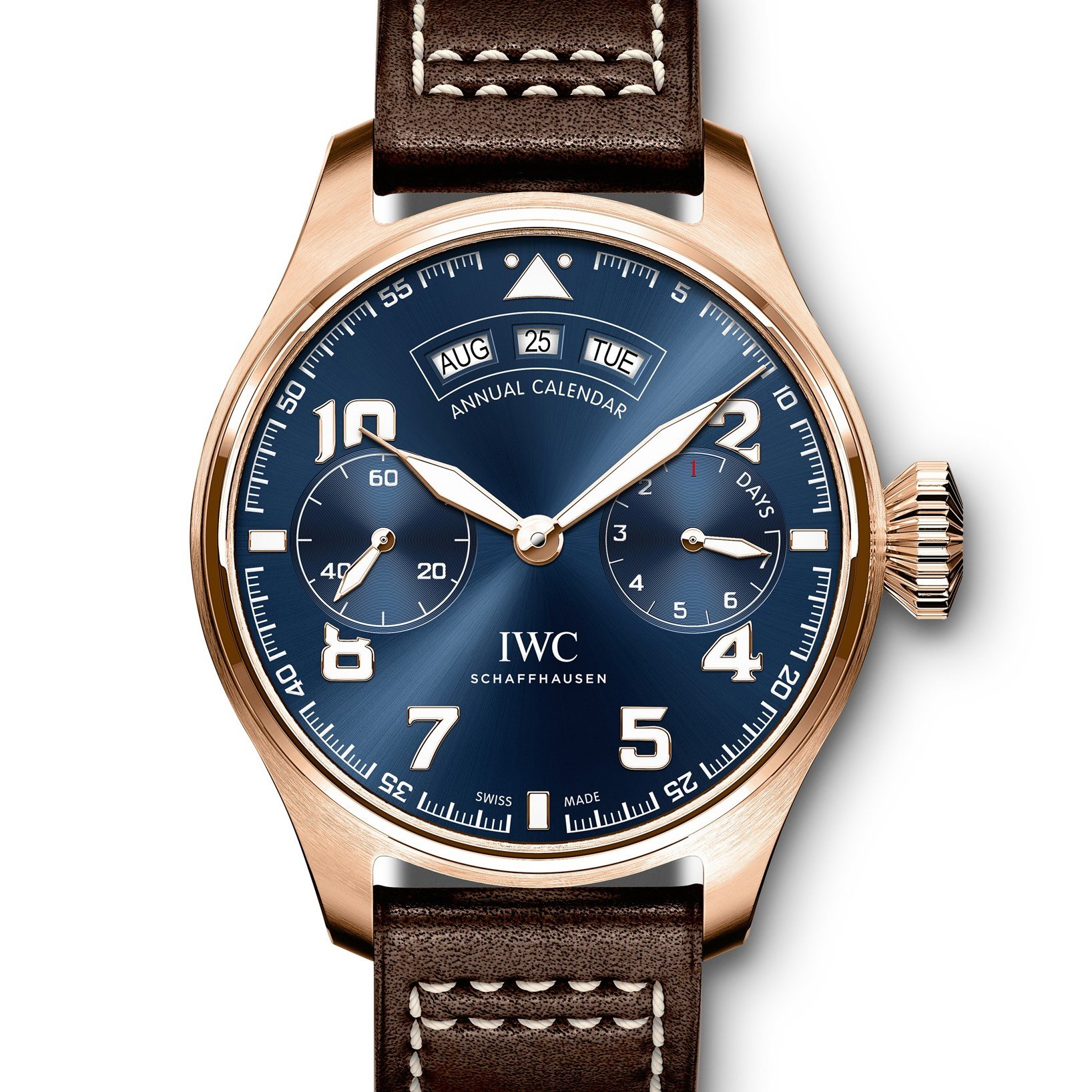

All the Big Pilot’s Annual Calendar references shared the 46.2mm diameter familiar shape case with the oversized conical crown, sapphire crystal casebacks and dial layout, distinguished by the dial colours and details. On the dial at 12 o’clock, three separate apertures displayed the month, date and day, underlined by the Annual Calendar designation (except for the 150th Anniversary IW502708), with the power reserve at 3 and small seconds at 9 o’clock. The Cal. 52850 calendar mechanism, with its three display discs, automatically accounts for the varying lengths of individual months. However, the end of February still requires manual correction, which is achieved here simply by using the crown.
Big Pilot’s Watch Big Date Edition 150 Years
As part of its 150th anniversary celebrations in 2018, IWC presented another bold evolution of an icon: the Big Pilot’s Watch Big Date Edition 150 Years Ref. IW5105. For the first time in the Big Pilot’s history, IWC had integrated a big date display into its legendary platform. Like the Annual Calendar before it, the Big Date respected the design codes of the Big Pilot’s line, carefully balancing innovation with the uncompromising legibility and tool-watch DNA that defined the model. The watch was powered by the hand-wound calibre 59235, an evolution of IWC’s proven 59000 family. It delivered an 8-day power reserve from a single barrel and drove a large twin-disc date display positioned just below the signature triangle at 12 o’clock.
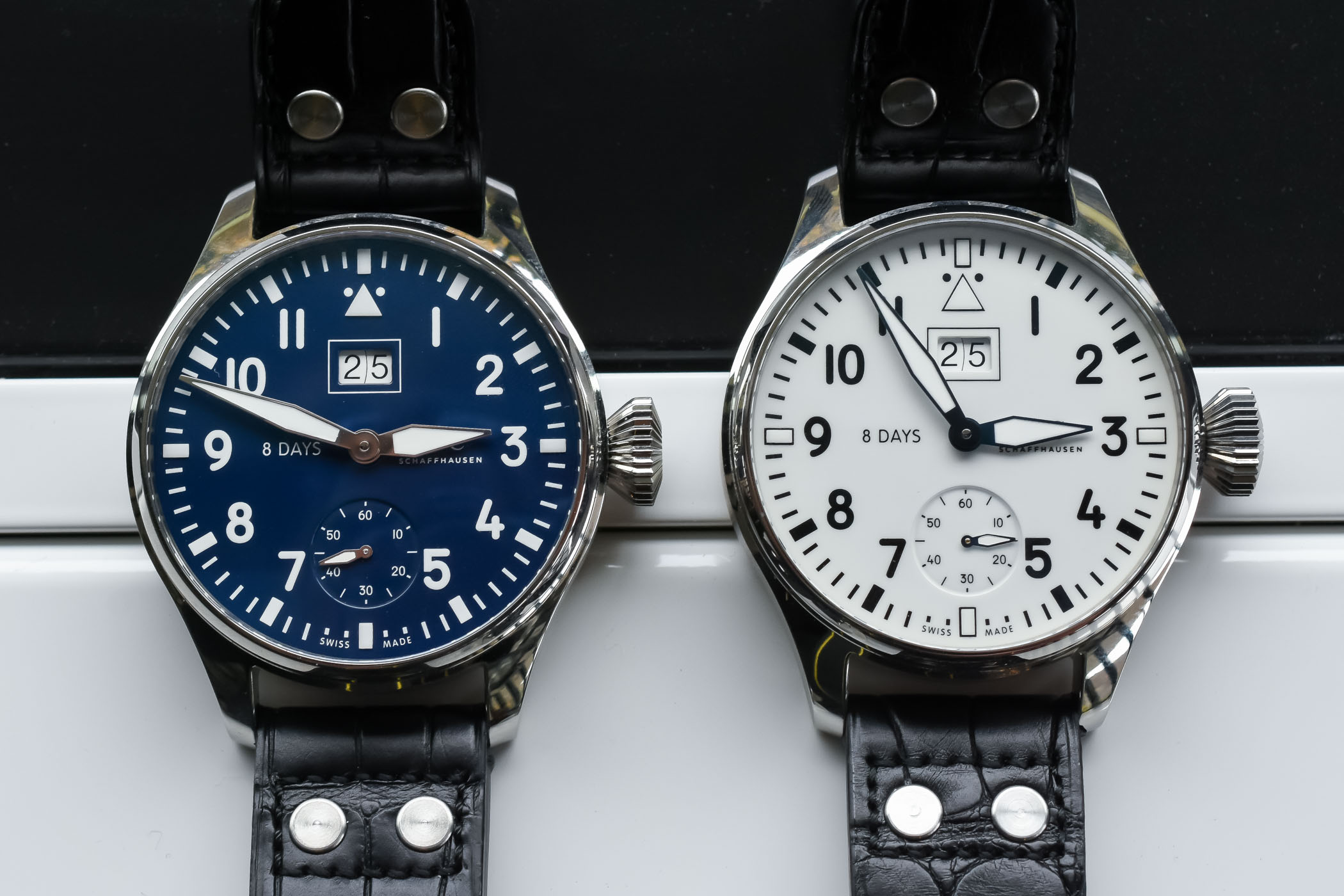

True to the 2018 Jubilee concept, the watch featured a high-gloss lacquered dial, either deep blue (IW510503) or crisp white (IW510504). The polished 46.2mm stainless steel case retained the classic Big Pilot´s silhouette but was slightly slimmer at 15.2mm, thanks to the hand-wound calibre.
Big Pilot’s Watch Constant-Force Tourbillon
Marking another first for IWC’s Pilot’s Watch collection, the Constant-Force Tourbillon Edition Le Petit Prince IW590302 (10 pcs) used IWC’s in-house, hand-wound calibre 94805, which countered the effects of gravity and fluctuating torque with two dedicated solutions: a 15.8mm tourbillon and a patented constant-force escapement.
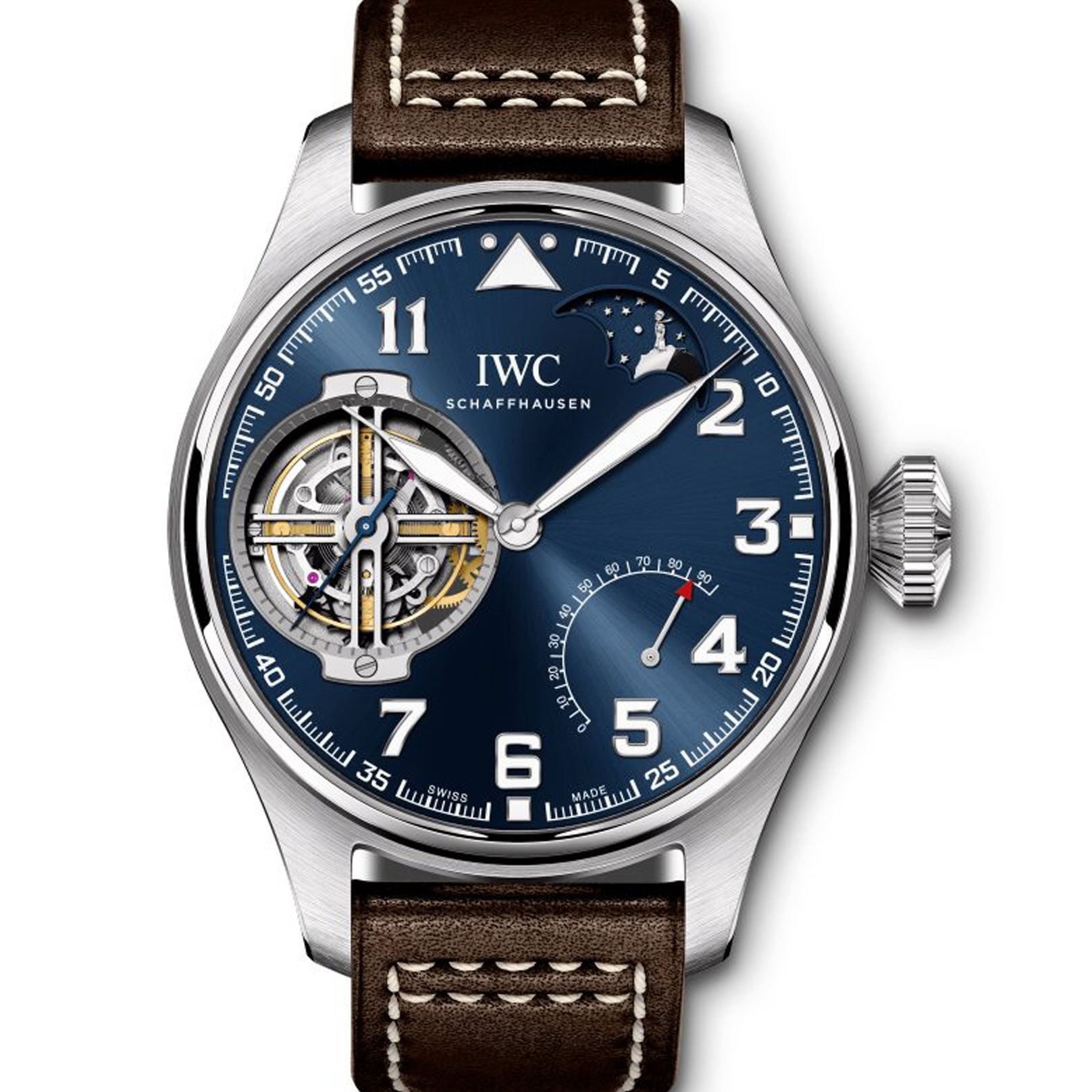

The constant-force system employed an additional escapement mounted between the fourth wheel and the escape wheel. This device isolated the balance from torque variation by storing energy in a coiled spring that released precisely once per second, ensuring consistent impulses. Combined with the oversized tourbillon, this architecture stabilised amplitude and improved rate accuracy. Twin mainspring barrels delivered a 96-hour power reserve at 18,000 vibrations/hour (2.5 Hz).
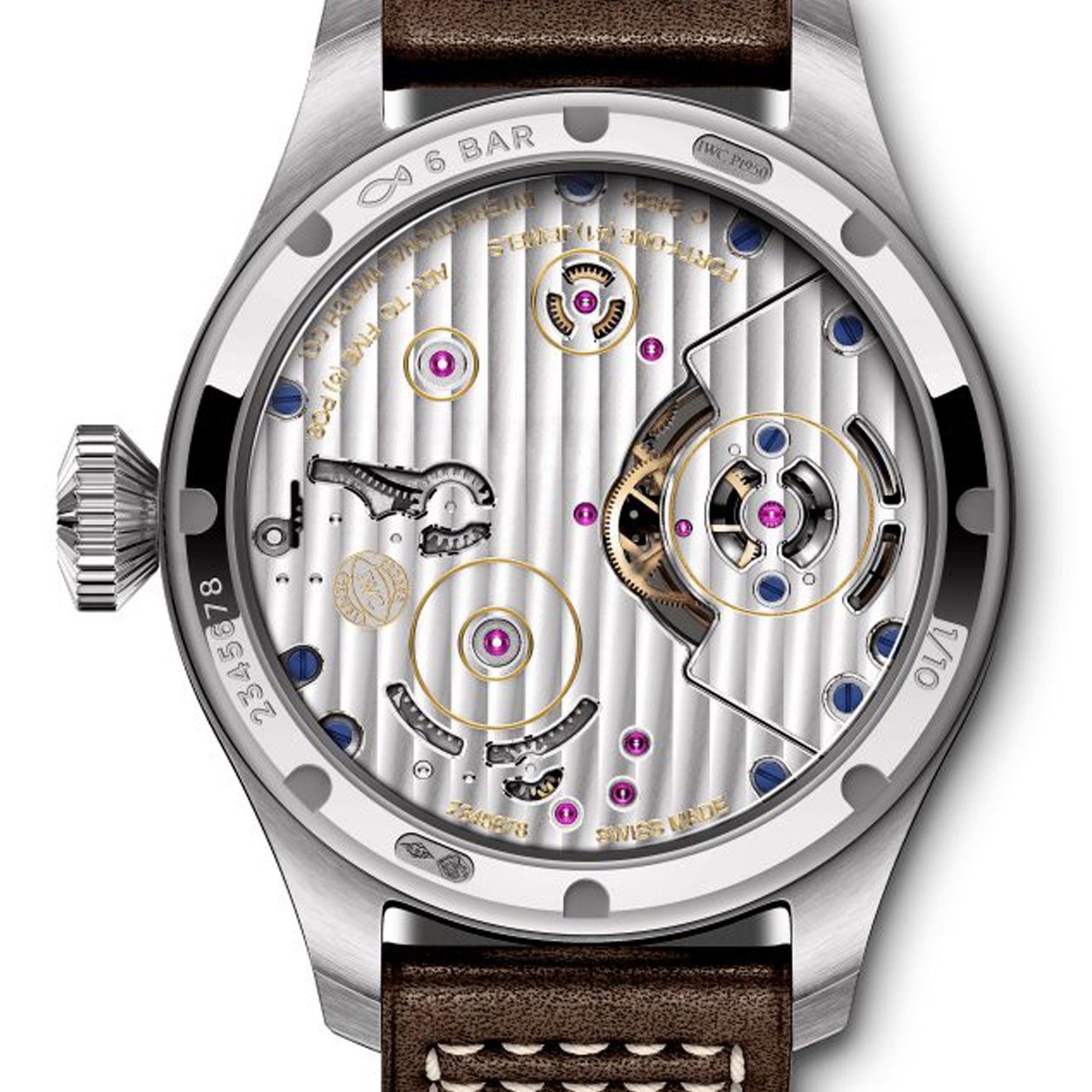

The 46.2mm x 13.5mm case was crafted from IWC’s proprietary 18k hard gold. The dial featured the signature Le Petit Prince sunburst blue, gold-plated propeller hands, applied luminous Arabic numerals, a perpetual moon phase accurate to one day in 577.5 years, and a power reserve indicator at 4 o’clock. Small seconds were displayed on the one-minute tourbillon at 9 o’clock.
Big Pilot’s Watch Monopusher Chronograph
As already demonstrated, over the years, the Big Pilot’s Watch has welcomed remarkable complications, yet an essential one remained absent: a chronograph. In 2021, IWC addressed this omission with a fitting tribute to aviation heritage and, once again, literary magic: the Big Pilot’s Watch Monopusher Edition Le Petit Prince IW515202 (500pcs).
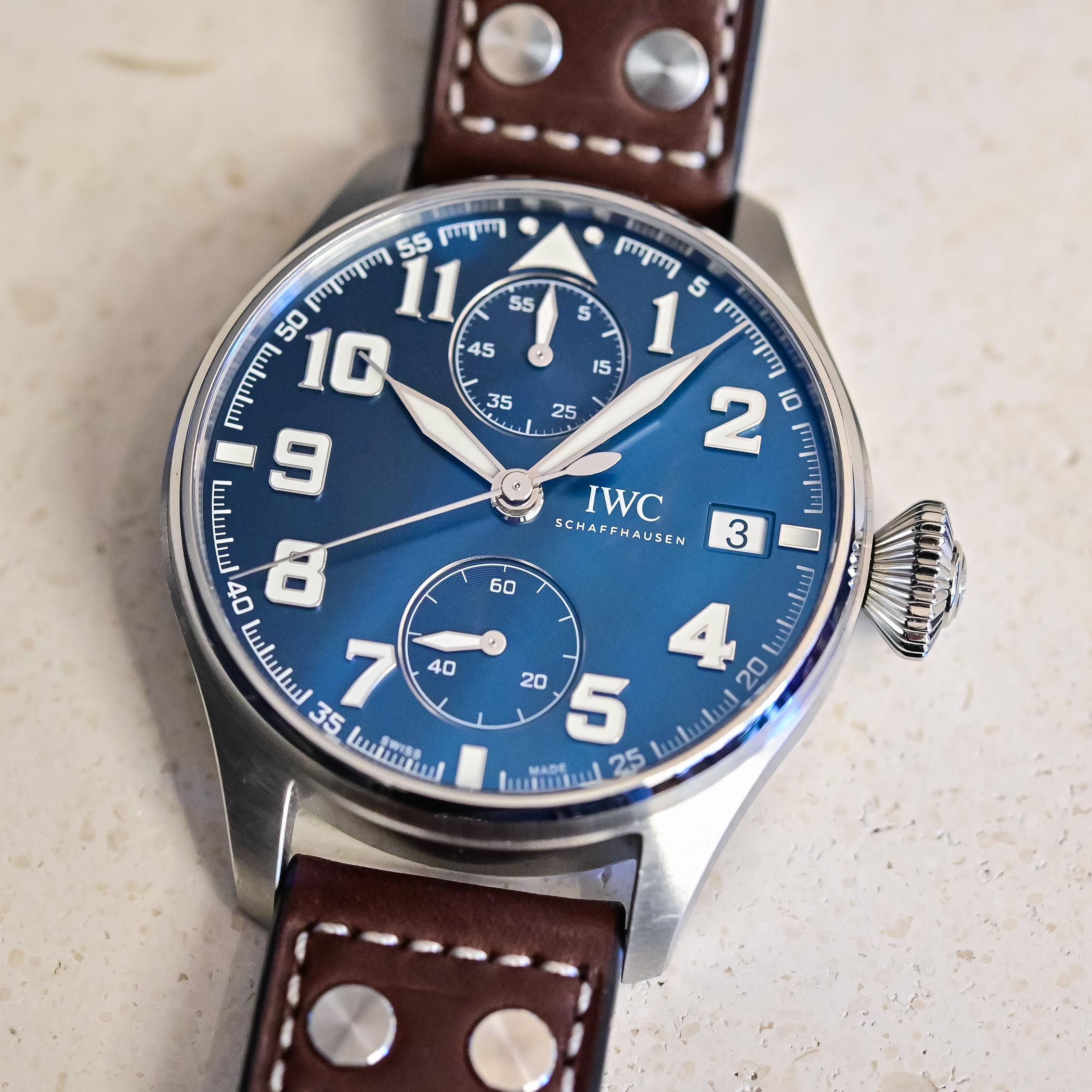

To preserve the watch’s iconic silhouette, the historic first for the Big Pilot’s line opted for a monopusher design, integrating the start, stop, and reset functions into a single pusher housed within the signature oversized conical crown. The watch relied on the hand-wound calibre 59365 featuring a sophisticated monopusher module with a column-wheel, IWC’s only manual-winding chronograph, with an 8-day power reserve.
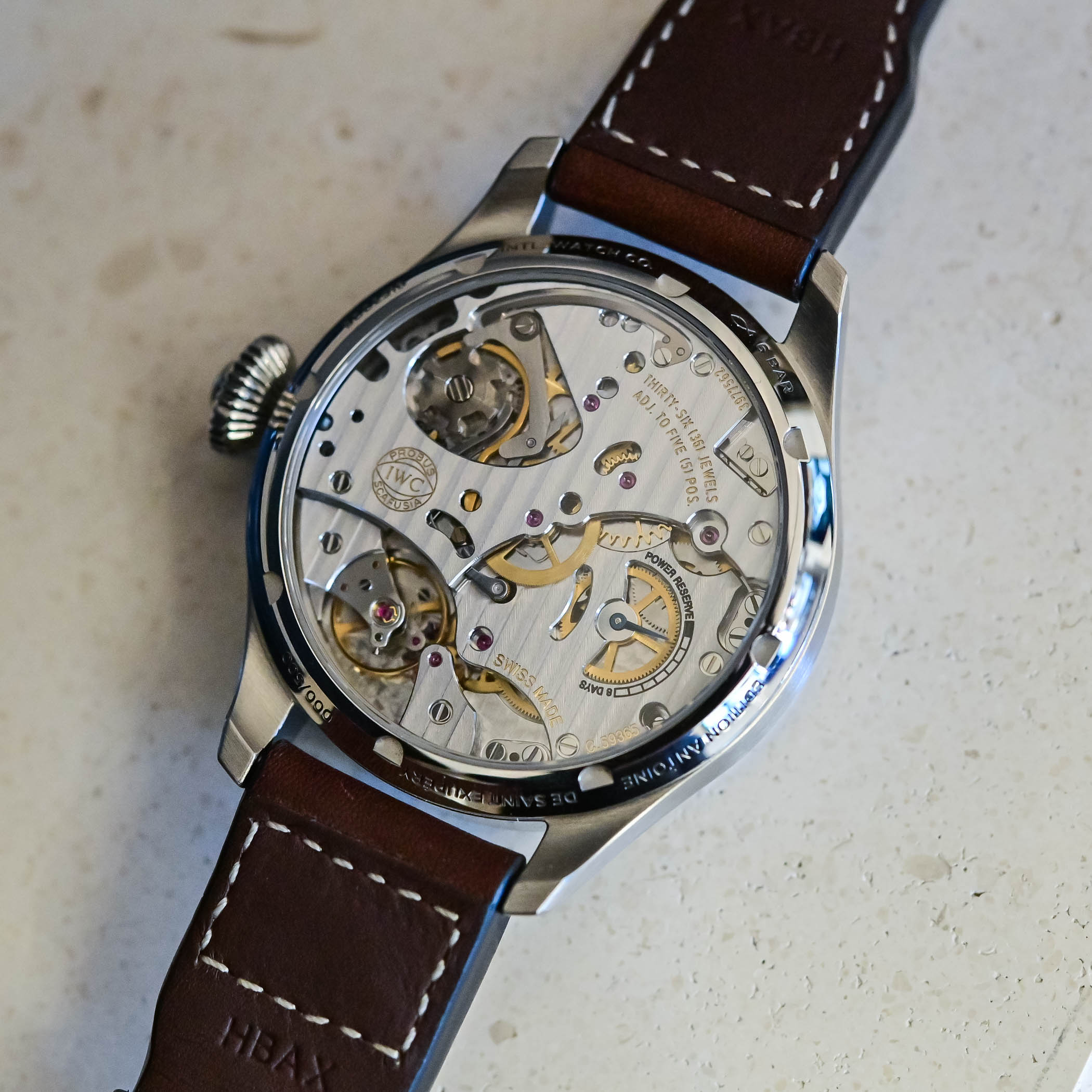

True to the spirit of the Le Petit Prince editions, the 46.2mm stainless steel case frames a deep blue sunray-brushed dial, featuring luminous applied numerals, broad hands, and a clean vertical layout with a 60-minute counter at 12 o’clock and small seconds at 6 o’clock. A discreet date window replaced the numeral at 3.
Big Pilot’s Watch Shock Absorber XPL
The Big Pilot’s Watch Shock Absorber XPL IW357201 marked the debut of IWC’s Experimental Engineering Team and pushed the limits of shock resistance in mechanical watchmaking. Housed in a 44mm Ceratanium case, the XPL integrated IWC’s patented SPRIN-g PROTECT system. This innovative suspension mounted the calibre 32111 on a mathematically engineered BMG (bulk metallic glass) spring, isolating the movement from impacts up to an unprecedented 30,000G, verified.
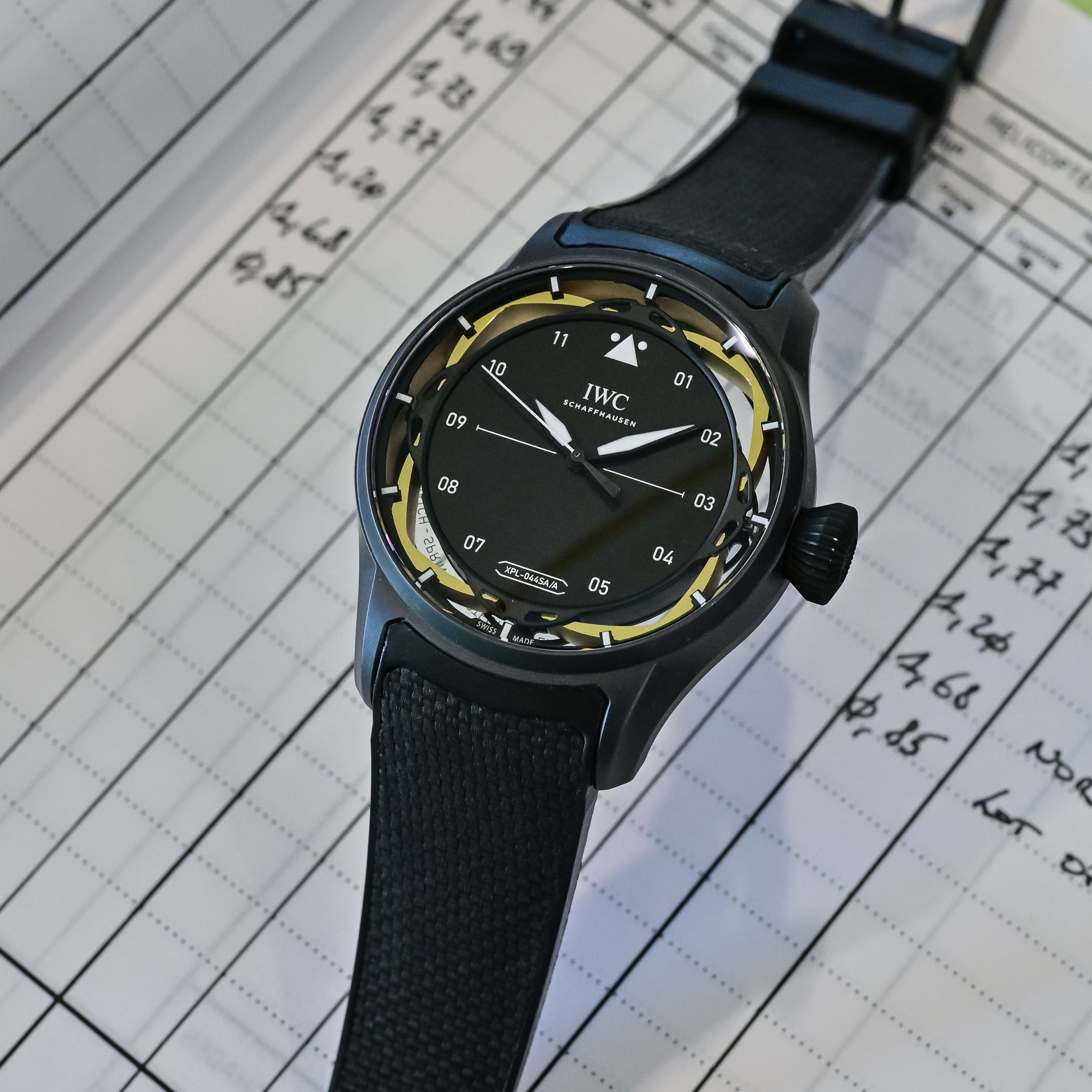

A clutch-based flexible coupling connects the movement to the crown, while a lightweight aluminium base plate reduces overall mass. The automatic calibre 32111 runs at 4 Hz with a 120-hour power reserve, displaying hours, minutes and seconds on a black dial secured under a sapphire crystal rated against displacement from rapid air pressure drops. The Big Pilot’s Shock Absorber XPL was limited to 30 pieces worldwide, with only 10 units produced annually. In 2025, Big Pilot Shock Absorber Tourbillon Skeleton XPL put IWC’s hyper-technical shock-resistant technology at the disposal of a tourbillon regulator.
Closing Notes
From its origins as a robust military tool designed for legibility and precision in the skies, the IWC Big Pilot’s Watch has evolved into one of the most recognisable timepieces in modern watchmaking. Over time, its commanding presence and aviation-inspired design have remained faithful to the original 1940s blueprint while embracing technical upgrades.
Whether through classic references, complications like perpetual calendars and constant-force tourbillons, or limited editions, the Big Pilot’s Watch continues to embody IWC’s spirit of functional engineering and timeless style. The collection moves forward and stands as a tribute to its pioneering past and a canvas for future horological experiments, a true statement piece for those who appreciate purposeful design and enduring heritage.
https://monochrome-watches.com/complete-history-of-the-iwc-big-pilot-collection-evergreen-in-depth/